Save 40% off! Join our newsletter and get 40% off right away!

Sailboat Life
Sailboat Cruising and Lifestyle Magazine.

Sailboat Solar Systems and How-To

Solar on a sailboat goes together like hands and gloves, but sailboat solar systems can be installed in a variety of ways. The solar components themselves create an infinite combination of possibilities for off-grid sailing. Victron Energy chargers, Renogy Panels, Sunpower Yachts, BlueSea Systems, and many more brands have entered the marketplace, and that’s not including the lithium battery companies.
To simplify things, we’ve compiled three sailboat solar systems videos to give you an overview of what’s possible. And to help you decide on your own simple solar panel setup for sailing.
How-To Install Solar Panels on Your Sailboat
This system from Zingaro shows flexible panels summing 300w of power on a 38′ catamaran.
300W Solar System:
- Three 100w solar flexible panels
- 1 MPPT Solar charger controller
View on Amazon >>
100W HQST Flexible Solar Panels $100-$200
20amp Solar Charge Controller by Victron Energy $150-$200

Simple Sunpower Solar System
This simple solar system from The Fosters shows a quick and easy setup with limited space on top of a bimini.
Sunpower Solar Panels are considered by most in the industry as the gold standard. They use the highest-efficiency solar cells and have top-notch build quality. In this simple installation, three 50w panels are just enough to get you started. Plus, it’s the most affordable installation!
150w Starter Solar System
- Three 50w Flexible Solar Panels
- A Single 15amp solar charge controller
50W Sunpower Solar Panels $150-$200
75v/15amp Solar Charge Controller by Victron Energy $100-$124

Off-Grid on a DIY Solar Powered Sailboat
Here’s a special installation that turned a derelict sailboat into an off-grid sailing machine!
Simon has transformed this derelict sailboat into an epic off-grid solar-powered and fossil-fuel-free cruising catamaran. He’s been living aboard and renovating the boat for the past 3.5 years We’re excited to show you the transformation as well as how he plans to propel the boat without the use of diesel or fossil fuels!
5280w Solar System for Electric Powered Catamaran
- 16 Rigid solar panels (330w each)
- 20kwh of Lithium Batteries
240W Rigid Solar Panels $250-$300
200AH Lithium 4d Battery $1200-$1200

Share this post!
Throw in your two cents, start a discussion cancel reply, related articles.

The Voyage of the Sea Star – 35ft Sloop to Bermuda

Living Aboard a 30-36ft Sailboat: A Guide for the Curious and Adventurous

Summer Sailboat Video, Bikinis, Sails, and Fun

Saved Up For This Dream
Yachting Monthly
- Digital edition

Sailing with solar power: A practical guide
- Duncan Kent
- November 13, 2020
The latest solar technology makes self-sufficient cruising much more achievable. Duncan Kent gives the lowdown on everything you need to get your boat sorted

SOLAR POWER ON BOARD
Solar power is fast becoming the most popular and economic method of keeping the batteries charged on a boat.
Particularly now that the efficiency of photovoltaic (PV) panels, charge controllers and batteries is improving every day.
Furthermore, the latest technology in regulators and charge controllers has brought about a noticeable increase in useable power output, so the problems of shading and non-alignment can be compensated for more easily.
Not only has PV equipment become more efficient and cost-effective, but many of the modern devices we want to use on a boat have become less power hungry.
This means it is now far easier to provide your entire yacht’s electrical needs, both 220Vac and 12/24Vdc, from natural energy resources – particularly solar power, even if you are planning on a fully electric boat .

Thinking carefully about how much power you need and how much your boat can accommodate is key to planning a solar array. Credit: Graham Snook
WHAT DO YOU NEED?
For instance, a boat with two new, good quality, deep-cycle house batteries of 100Ah each would supply 100Ah of energy to consume between charges, if you only use the recommended 50% of available charge between each charge cycle to protect the batteries.
From this you could run:
- a modern 12Vdc fridge (approx. 1.5Ah, or 36Ah over 24hrs),
- all LED lighting (say 20Ah per day),
- various small device chargers (20Ah)
- and a number of other items such as water pumps, TVs and stereos (25Ah/day)
- Totalling around 100Ah.
- For this you’d need 400W of solar capacity.
Of course, if you like to run a lot of AC devices off-grid such as hair dryers, microwaves, toasters and the like, then you’re going to need a DC/ AC inverter, which will take you to another level in power consumption terms.
But even then, with careful planning, solar could provide a large portion of the power you need before resorting to engine charging or a generator.
THE AVAILABLE SPACE
In practical terms, a modern 40ft monohull would have the space for around 1,200W of PV panels (cockpit arch, sprayhood top, deck), maybe 1,500W with the addition of a few portable panels for use at anchor.
The 1,200W of fixed position solar array could produce around 360Ah on a sunny summer’s day (zero shading) or more likely 250Ah on the average UK summer’s day.
So that’s enough for your 100Ah general DC consumption plus another 150Ah of AC consumption via the inverter.
Of course, to do this you’ll most likely need to increase your battery capacity to around 400-500Ah for maximum flexibility (you’ll need to store as much as possible during daylight hours), a typical figure for a 40-50ft offshore cruising yacht these days.

Get your solar charging right and you may never need to hook up to shore power
Typical daily inverter loads for a cruising yacht off grid might be:
- induction cooking plate (20min) 60Ah
- microwave (15min) 30Ah
- coffee maker (20mins) 25Ah
- hair dryer (5min) 15Ah
- laptop charger (2h) 10Ah
- or around 140Ah in total.
The trick is to monitor the batteries’ state of charge (SOC) at all times and vary your use of the inverter to suit.
For example, you might want to cook supper mid-afternoon, when solar is in abundance, and then reheat it in the evening when you want to eat it.
In some cases, when you’re cruising in warm climates such as the Med, you might end up with excess charge from your solar panels .
In this situation, many long-term cruisers devise a method of ‘dumping’ the extra energy by heating water for showers.
Do bear in mind if you’re planning to live aboard full time , then it’ll be a whole different story on cloudy days and during the winter, when inverter use might need to be knocked on the head entirely.
Continues below…

Eco friendly sailing: Best practice for green yachting
How easy is it to go eco friendly sailing? We look at the steps cruisers can take to minimise their…

How and where to go wild cruising in the UK
Planning to spend the night away from crowded waters can be truly rewarding but preparation is essential before you go…

Solar-powered boat crosses Atlantic
Then heads to UN climate conference
POWER DISCREPANCIES
There’s often confusion as to how much power you can harvest from a solar installation.
A PV panel is nearly always advertised stating its theoretical peak output power (Pw).
But in reality, on a yacht where there are limited areas in which to mount them, they will more likely produce a maximum of 60% of their peak output if mounted horizontally, increasing to 80% if tilted towards the sun and regularly adjusted.
The latter is rarely achievable on a boat, however, as even at anchor it can swing through an arc of 180° in wind or tidal shifts .

Flexible panels can be mounted on sprayhoods or awnings to add power when it’s needed at anchor or in harbour
INSTALLATION
Having trawled through hundreds of ‘deals’ to get the best price on the most efficient panels you can afford you now need to know how to install them to best fulfill your energy generation needs.
The output, even from the highest quality photo-voltaic array, will only be as good as the installation itself.
So following our guidelines should ensure you extract every last drop of energy from your investment.
PANEL MOUNTING
Sailing boats are not the ideal structure on which to mount wide, flat PV panels.
So before you go ahead and purchase what looks like the biggest and best, take a few minutes to decide on exactly where you can mount them, as this will affect what size and type of panels you should buy.
In many cases the first choice would be on an arch, davits or gantry aft, especially if you already have, or plan to fit one.

Dinghy davits, particularly on multihulls, can support a huge solar capacity
These allow a solid metal framework to be constructed that will be strong enough to take the heavier, more productive rigid PV panels.
You can also build in some form of adjuster to the framework that will allow the panels to be orientated towards the sun for the best performance.
With luck (or careful planning) a gantry will also keep them aft of the boom, thereby eliminating loss of output caused by boom shading.
The next most popular position for mounting the panels is on a cockpit sprayhood or bimini, although this will often mean using the flexible or semi-flexible panels, which are generally less efficient than the rigid ones for the same area.
ELEVATED MOUNTING
Alternatively, there are kits available for mounting panels onto lifelines, which can allow their elevation to be manually adjusted to a certain degree.

Pole-mounted panels can be used for maximum adjustability
Finally, panels can be fitted directly onto the deck by either gluing them down using mastic or attaching them onto a rigid support frame.
Once again you will probably need to use semi-flexible panels – especially if the deck surface is curved.
Rigid, glass-coated panels will obviously not be suitable for deck mounting in an area that is frequently walked over.
Don’t be tempted to drill through the panels, even along the edges, as this will invalidate the warranty and possibly damage the panel.

With solid panels, the ability to adjust the angle can add significantly to output
It might seem obvious, but the key to an efficient system is to avoid shading wherever possible.
It’s no good fitting expensive, high-efficiency PVs right under the boom as they’ll perform little better than the cheaper types.
Saying that, in good quality panels each cell will be isolated from the next by a series of diodes (one-way electrical valves), so that if one cell is shaded at least it won’t drag down the other cells within the same panel.
Older panels often didn’t have these, so the slightest partial shading caused the output of the entire panel to cease.
OVERHEATING
Another important factor that is often ignored when installing the panels is that of overheating.
If a PV panel gets too hot, which is quite likely if mounted directly onto a flat surface without an air gap behind, its output will drop quite noticeably.
To allow for some air circulation behind the panels it’s best to apply mastic adhesive in numerous large dabs.
This is best achieved by placing wooden spacer strips between the dabs until the mastic has completely cured, after which the spacers can be removed.
You might need some form of trim around one or more of the outside edges, though, if they are positioned where sheets and other lines might get caught under them.
Raising the panels up will also help water to drain off and thereby helping to avoid possible delamination from sitting in water for too long.
CHARGE CONTROL
A PV module cannot supply an electrical device directly due to the changeability of the sunlight, which in turns varies the current it can produce.
Therefore, it has to be connected to a battery, which stores and smooths its output.
Whatever the size of your solar array you will need to fit a regulator, or charge controller as they are now more commonly known, to the system in order to control the output and to help extract as much power from the panels as possible.
There are two types of PV charge controller.
The older designs, called Pulse Width Modulation (PWM) types, were fairly basic voltage regulators and simply output volts at just above battery level.
The latest controllers use Multi Power Point Tracking (MPPT) technology and can accept much higher input voltages (up to 240Vdc).
MPPT controllers can be up to 30% more efficient as they use the peak output of the panels to charge the batteries, even compensating for partial shading.
BEWARE FAKE GEAR
If you buy online do be careful to ensure you’re getting what you pay for.
There are a huge number of fake MPPTs out there, which are simply the much cheaper PWM dressed up with fake labels.
It’s hard to tell which is which, but the old adage of ‘if it looks too good to be true, it usually is’ makes good sense.
MPPT controllers are usually bigger and heavier than PWMs, but if in doubt call or email the supplier to discuss the pros and cons of their kit before buying.
If they’re not happy to chat and advise you then I would steer clear of their gear.
Some good MPPTs are made in China, but unless they have a UK supplier, I wouldn’t bother with them as you’ll have no follow-up advice.
To calculate what size controller you need simply divide the panel’s peak power in Watts (Wp) by the battery voltage, which will give you the maximum current (Amps) they could theoretically supply.
For example 240W/12V = 20A. Although it’s unlikely you’ll ever get near the peak output from any PV panel, it’s best to go for the maximum possible.

Induction cooking is now a reality on board, even without shore power
PV panels come with a short length of cable, usually around 1m long.
Some are supplied with MC4 connectors already attached but most only provide bare wires.
The latter can be easily extended using proper waterproof connections but thought must be given as to the current rating and voltage drop (usually max 3%) for the size of cable you intend to use.
If in doubt, bigger is better!
Panels can sometimes be ordered with the wiring on the back so that the cable can go straight below deck through a hole under the panel.

You may need to fit extra battery capacity if you want to run an inverter from solar charging
SERIES OR PARALLEL?
A commonly asked question is ‘should I wire my PV panels in series or in parallel?’
The simple answer is, if there’s any danger of frequent shading to one or more of the panels then install them in parallel.
If wired in series the shading of a single panel will drag down the output from all of the others in the same series.
PARALLEL IS PREFERRED
Most commonly, multiple panels are wired together in parallel to a single charge controller, with diodes protecting each panel from discharging the others should one become partially shaded.
With the advent of MPPT controllers, however, there can sometimes be a benefit to wiring two or more identical panels into a series bank, thereby presenting a higher voltage to the controller.
It’s worth noting that, like batteries, wiring PV panels in series increases the voltage only – the current capacity of the array remains the same as for a single panel.
‘Where’s the benefit of wiring them in series then?’ you might ask.
Well, the higher the voltage fed into the MPPT, the more consistent it will be with its output, which could, in some cases, prove more efficient than a parallel installation with PWM controllers.
It’s also likely to be necessary if you have a 24V domestic system.
SERIES WIRING
Series wiring is usually only done when the cable runs are long, as it helps negate the voltage drop caused by the resistance of the cable.
While a decent controller will have no problem handling the output from four or even five panels wired in series, it is often inappropriate for sailing yachts as shading just one of the panels will reduce the output of the entire series array.
If you need to do so in order to reduce cable runs then it’s best to split the panels between each side of the boat – a series bank on each side.
If you do this, then you would ideally fit a separate controller to each series PV bank and then connect their outputs together in parallel to the battery bank.
Note, however, that panels wired in series must all be the same types with an equal number of cells per panel.
Furthermore, the charge controller needs to be sized for the total of all panel voltages added together and the current rating of one individual panel.
Differently rated panels can be connected together in parallel but only if each panel has its own controller.
The outputs of the individual controllers can then be joined together to go to the battery bank.
BATTERY BANK QUESTION
Another frequently asked question is ‘Can I connect another charging source to the battery bank while the solar array is charging?’
The answer is yes.
Any decent PV controller will be protected against feedback from other charging sources.

Think carefully about where shade from mast, boom and rigging will fall. Credit: Graham Snook Photography
CABLE SIZE AND CONNECTORS
A frequent cause of reduced output from PV arrays is wiring that is too small.
The resistance of a wire conductor increases in direct proportion to its cross-sectional area, so go as big as is practicable for the least cable loss.
Each panel should be supplied with the correctly sized cables for its own maximum output.
But if you’re combining panels, either in parallel or in series, you will clearly need to rate the single feed cable to suit the maximum current available at theoretical peak solar output and to minimise voltage drop.
Likewise, the cable from the controller to the batteries should be sized to suit the controller’s maximum output current and protected with a fuse.
For outside it’s important to use exterior grade cable, which is double- insulated and UV-proof.
WEATHERPROOF CONNECTORS
And wherever possible use compatible weatherproof connectors (usually MC4) to those found on the panels rather than cutting off the plugs and hard-wiring them.
Field- assembly MC4 plugs are available, so you don’t have to drill large holes in the decks or bulkheads when feeding the cables through.
When joining more than one panel together try to use the approved multiway connectors; not only do they keep the wiring neat and tidy, but they also offer a greater contact area than budget terminal blocks.
If you have to use screw-type connectors make sure to fit proper ferrules to the wire first to avoid any stray wires in the multistrand shorting across the terminals.
When feeding a cable from above to below deck, try to go through an upright bulkhead where possible to minimise ‘pooling’ of water around the access hole.
Also, use a proper watertight deck seal that matches the cable you’re using.
If drilling through a cored deck you need to drill a larger hole first, fill it with epoxy resin and then drill the required size hole through the epoxy to ensure no water gets into the deck core.
Ideally, the charge controller should be mounted no further than 2m from the battery bank.
If you need to go further, you’ll require larger cabling to reduce the voltage drop.

A generous solar array will keep you self- sufficient indefinitely. Credit: Graham Snook Photography
CONTROLLER LOAD TERMINALS
There is often confusion over the ‘load’ output of a charge controller (often depicted by a light bulb) and what can safely be connected to these terminals.
Rarely explained in the manual, the load terminals should be pretty much ignored in a marine installation as the output on these terminals is usually very limited (10A max).
Some attach an LED light to them to indicate the controller is operating, but all your usual electrical loads should remain connected to the batteries with the battery terminals on the controller connected directly to that battery bank via a fuse.
It is possible, though, to control a high-current switching relay in certain conditions.

Parallel installation is more resilient to shading, but a series installation will increase peak charging outputs. A combination of the two offers some of the benefit of both
CIRCUIT MONITORING
Unlike most cheap PWMs, the majority of good quality MPPT charge controllers come with an alphanumeric LCD screen to let you know what is going on.
This can either be a remote display or simply one on the front of the box.
It’s obviously a lot better to have a proper numerical display than to rely on a few flashing LEDs to tell you when something’s not right.
So if your chosen controller doesn’t have one be sure to fit a battery monitor (the shunt type) into your solar circuit between the controller and the batteries.
It doesn’t have to be a very ‘smart’ monitor, just one that can display the voltage and current being supplied by the panels.
For smartphone addicts there are several wifi apps that will do the job remotely on your phone or tablet.
DEVICE PROTECTION
All good quality PV panels feature built-in diode protection between each cell to prevent a shaded cell from dragging down the productive ones.
In addition, there will be internal blocking diodes on the final output to protect the panel from polarity reversal and to ensure that the batteries can’t discharge back into the panel during the night.
The latter can be added externally, the former can’t, so check before you buy.
A fuse, rated just above the maximum current available, should be fitted between each panel and the charge controller.
Another fuse should then be installed between the charge controller’s output and the batteries.
In the case of multiple arrays, this second fuse will be rated higher than the individual panel fuses and should match the maximum current rating of the cable.
With this protection installed other charging devices can be connected in parallel at the battery, meaning the solar can be left connected even when you are hooked up to shore power and the battery charger is operating.
In some circumstances, however, this arrangement can affect the sensing of the battery by the charger, causing it to fall back into float mode.
If this becomes apparent it can be overcome by installing a manual/auto switch to disconnect the solar array when on shore power.

Check the flex of the solar panel is sufficient for your deck
EXCESS POWER DUMPING
A solar charge controller works by disconnecting the supply from the PV panels when the batteries are fully charged.
But for some full-time liveaboards in sunny climates that can be considered a waste, when the excess power could be put to good use – heating water, say.
This is commonly done using an inverter to supply AC power to the heating element.
Alternatively, you can now buy a 12Vdc element for your calorifier (hot water tank) and supply this directly from your battery bank.
Both of these methods would require a voltage sensitive relay (VSR) to disconnect the element should the battery voltage drop below a pre-set level.
Don’t expect boiling hot water, as there will probably only be enough spare power to take the chill off it before your battery bank reaches its lower threshold voltage.
A 600W/12V element will draw some 50A, from the batteries, whereas a 1kW AC element run through an inverter will need close to 100A.

A small, semi-flexible panel will be sufficient for keeping batteries trickle charged, but not for heavy use
RIGID, FLEXIBLE, OR SEMI FLEXIBLE?
Despite massive recent improvements in semi-flexible panels in recent years, the solid glass panels still offer a higher power density.
That said, they are heavier, more awkward to mount and can’t be walked on, so unless you have a dedicated gantry aft, you’re better off choosing the more rugged semi-flexibles.
Modules incorporating monocrystalline cells also have a better output than those with polycrystalline cells (that’s cells made from a single slice of silicon as opposed to layers of smaller pieces).
Output voltage also depends on the number of cells on the panel.
In the past this has commonly been 32, but now some 36 and even 40 cell panels are available.
That said, they’re larger, of course, so an array of interconnected smaller panels might be a better solution.
Module efficiency is now more often around the 20% mark, as opposed to 12-15% for older models and semi- flexible (up to 20° bend) are usually better than flexible (up to 180° bend).

A rigid panel is more efficient, but less robust
There are a huge number of panels on the market, but many use the same cells.
Sunpower Maxeon cells are exceptionally good, as are the Panasonic HIT range and LG, but they are pricey.
If the maker is offering a 25-year guarantee instead of a 3-5 year one, you can be pretty confident they’re good.
When it comes to charge controllers it’s definitely worth paying a little more for a decent MPPT.
A cheap PWM might be okay just to keep a small starter battery charged with a 30W panel, but the MPPT will give you much more when it comes to heavy service.
Victron are probably top of the range, while cheaper brands like MakeSkyBlue and EPever are also good value – but treat imports of unclear origin with care.
ABOUT THE AUTHOR

Duncan Kent has been evaluating and reviewing yachts and marine equipment for the past 30 years
Enjoyed reading this?
A subscription to Yachting Monthly magazine costs around 40% less than the cover price .
Print and digital editions are available through Magazines Direct – where you can also find the latest deals .
YM is packed with information to help you get the most from your time on the water.
- Take your seamanship to the next level with tips, advice and skills from our experts
- Impartial in-depth reviews of the latest yachts and equipment
- Cruising guides to help you reach those dream destinations
Follow us on Facebook , Twitter and Instagram.
- Sign in / Register
- Comparison list
- Solar on the go
Picking the best solar panels for a sailboat: Buyer’s guide
- 18 Aug 2022

You might have already heard of brave sailors that conquer the oceans with nothing but wits and solar panels. For instance, this year 83-year-old Kenichi Horie became the oldest person to sail solo from the US to Japan on a solar-powered boat. These stories are inspiring, but picking panels for your boat yourself can be a small challenge in itself. That’s why we wrote a short article about the best solar panels for sailboats and how to recognize them.
Start from type of solar panels
When it comes to solar panels for sailboats, their weight and size matters more than with PV modules for residential systems. Efficiency is important but power — not that much, because the energy needs of a boat are relatively low. The first thing you’ll have to decide about your panels is their type.
Generally, you’ll choose between thin-film panels and monocrystalline modules. While polycrystalline panels are still around and they are indeed cheaper than mono panels, they are much less efficient, which means they’ll need more space and add more weight to your boat.

Thin-film panels are light and cheap
Thin-film or flexible solar panels bend well and they are very easy to install which makes them a great choice for boats with difficult configurations. Some sailors say that flexible panels are the best choice for fast boats because they don’t impact the aerodynamics of a vessel as much as rigid panels do.
The downside of flexible panels is their low wattage. If there are many appliances on board, you’ll need several panels and you’ll need to find the right place for each of them. They also age faster than rigid panels — a thin-film panel generally lasts for 10-15 years.
Monocrystalline panels are powerful and reliable
Rigid solar modules, monocrystalline and polycrystalline, are heavier and bulkier than thin-film panels. You can fix flexible panels with adhesives, but rigid panels require drilling. They are also more expensive than flexible panels.
On the other hand, monocrystalline panels are the most efficient type of panels which means that they provide more power for less space. Even one powerful mono panel can be enough for everything that you’ve got on board. They are also much more reliable and will survive any storm that is coming your way. A monocrystalline panel lasts for at least 25 years.
Panels for boat should be efficient and sturdy
The best solar panels for sailboats don’t have to be powerful, but they better be efficient — find the number in the datasheet. For rigid panels anything over 18-19% is fine. Panels also should be sturdy enough to withstand seastorms. You generally also want good shading tolerance since panels often get shaded by masts and sails. Finally, good performance in low-light conditions is appreciated.
Picking bifacial panels, 72/144-cell panels or larger, anything too powerful generally doesn't make a lot of sense. Performance at high temperatures matters less than it does with home systems. Warranties also play a lesser role. You won’t be able to make use of them because they generally have effect only for residential installations.
The markets of thin-film and rigid panels are different. Generally, a manufacturer of flexible panels doesn’t offer mono- or poly-panels. Canadian Solar, Q CELLS and Jinko Solar are good choices when it comes to monocrystalline modules for boats. Renogy , WindyNation and PowerFilm make fine thin-film panels.
Do the math before purchase
The amount of power for your boat depends on the number of appliances on your board. There are two main ways to determine the size of installation that you need. You can take a test trip and see how much of your battery’s charge you’ve spent in one day. You can also do the calculations manually: write down all the appliances on the board with their power rating and number of hours in use per day. You can read about it in detail in our article " How much solar power to sail the seas? " It doesn’t make sense to oversize a marine PV system, because all the excess power will just go to waste.
Keep in mind that adding photovoltaics doesn’t make your vessel a solar boat, unless you have a solar-powered motor. You can switch your boat to solar energy fully, especially if it’s small, but you’ll have to calculate your energy needs accordingly.

Once you’ve purchased your panels, you’ll have to install them properly. You can order professional service or do it yourself. The most popular places for solar panels on a boat are a stern rail, masts, deck and canvas. Thin-film panels can even go on the sails. Ideally, you want a place where panels wouldn’t be shaded by masts on any other parts of a boat.
List of solar panels for a sailboat
We’ve asked our engineer to pick the panels that would complement a small boat well. These are his choices:
ZNShine Solar ZXM6-NH120-370/M

Solar panels from ZNShine Solar are inexpensive and fit all kinds of applications, including boat systems. ZXM6-NH120-370/M provides 370 Watts of power with a 19.88% efficiency. It performs well in low-light conditions. Graphene coating increases power generation and allows self-cleaning. The only downside is a lower wind tolerance, compared to other models: it is rated to withstand 2400 Pa pressure which is comparable to 140 mph wind.
Mission Solar MSE345SX5T

MSE 345 is a simple solar panel for all kinds of applications, including boat installations. Mission Solar panels are manufactured in Texas. The module provides 345 Watts of power with 18.7% efficiency. It is certified for high snow (5400 Pa) and wind loads (4000 Pa). The model is resistant to salt mist corrosion.
Suntech STP 365 S

Suntech is a Chinese company that offers quality budget-friendly solar panels. The STP365S model stands out in line because of its great performance in weak light, such as cloudy weather and mornings. It is designed to withstand harsh weather conditions, and the module is certified to tolerate wind of over 170 mph. Half-cut design makes cells sturdier and improves shading tolerance. Overall, this panel earns a place among the best boat solar panels.

Andrey had been a news editor and freelance writer for a number of medias before joining A1SolarStore team. Climate change and its impact on people's lives has always been among his interests and it partially explains his degree in Philosophy and Ethics.
Solar monitoring systems: All under control
Inergy solar generators review: Taking charge
AC vs DC-coupled solar battery systems: Pros and cons
How to clean RV solar panels
Solar panel size range: From tiny to large
Learn about the latest arrivals and discounts first!
By clicking "Subscribe", I agree by electronic signature to: (1) receive marketing and other texts and messages from A1SolarStore, directly or from third parties acting on its behalf, at the email address I entered above; (2) the Terms and Conditions ; and (3) the Privacy Policy .
Yacht Solar: Exploring the Advantages of Flexible Solar Panels for Boats
When it comes to sailing the open waters, boat owners are constantly seeking innovative ways to enhance their boating experience while being mindful of the environment. One such breakthrough in marine technology is the utilization of flexible solar panels for boats. In this article, we will delve into the world of marine solar panels, discussing their benefits, applications, and the various options available in the market.
Sailing enthusiasts are increasingly turning to flexible solar panels as a viable solution to power their boats sustainably. These innovative panels offer significant advantages over traditional rigid solar panels, making them a popular choice among boat owners worldwide.
1. Understanding Flexible Solar Panels for Boats
1.1 what are flexible solar panels.
Flexible solar panels, also known as thin-film solar panels, are made of lightweight and flexible materials such as amorphous silicon. This flexibility allows them to conform to various curved surfaces on boats, making them an excellent choice for marine applications.
1.2 How Do Flexible Solar Panels Differ from Conventional Panels?
Unlike conventional solar panels that use rigid crystalline silicon cells, flexible solar panels use thin-film technology, which makes them more versatile. Traditional panels are bulkier and heavier, while flexible panels are lightweight and easy to install.
1.3 The Advantages of Using Flexible Solar Panels on Boats
The benefits of flexible solar panels on boats are manifold. They are lightweight, durable, and resistant to impacts, making them ideal for marine environments. Additionally, their flexibility allows them to fit on curved surfaces, maximizing the use of available space on boats.
2. Addressing Rust Concerns in Marine Solar Panels
2.1 the impact of rust on traditional solar panels.
Traditional solar panels are often mounted using metal brackets or frames. In marine environments, these metal components are susceptible to rust due to exposure to saltwater and humidity. Rust can compromise the structural integrity and efficiency of the panels.
2.2 Why Flexible Solar Panels are Rust-Resistant
Flexible solar panels do not require metal brackets for installation. As a result, they are not as vulnerable to rust as their rigid counterparts. This advantage extends the lifespan of flexible panels and ensures optimal performance even in corrosive marine conditions.
3. Empowering Boats with Solar Panels and Batteries
3.1 combining solar panels with battery systems.
Integrating solar panels with boat batteries creates an independent and sustainable energy system. Solar panels generate electricity during the day, which can be stored in batteries to power various onboard appliances and equipment, even during cloudy or nighttime conditions.
3.2 Advantages of Using Solar Panels for Boat Batteries
Using solar panels for boat batteries reduces the reliance on traditional power sources, such as generators or shore power. This not only cuts down operational costs but also reduces noise pollution and emissions, promoting eco-friendly boating practices.
4. Exploring Flex Solar Panels for Marine Applications
4.1 the versatility of flex solar panels.
Flexible solar panels can be installed on various boat surfaces, including the deck, hull, and bimini tops. Their lightweight and pliable nature allow them to adapt to the unique contours of different boat designs.
4.2 Installing Flex Solar Panels on Different Boat Surfaces
Boat owners can install flexible solar panels using adhesives or by sewing them into canvas materials. This installation flexibility offers convenience and ensures a seamless integration with the boat's aesthetics.
5. The Rise of Flexible Solar Panels in the UK
5.1 marine flexible solar panels in the uk.
The UK, with its extensive coastline and thriving boating community, has seen a surge in the adoption of flexible solar panels. Boat owners are increasingly recognizing the long-term benefits of harnessing solar power for their marine activities.
5.2 Embracing Sustainable Boating Solutions
The popularity of flexible solar panels in the UK reflects the growing awareness and commitment to sustainable boating practices. As environmental concerns mount, the marine industry is actively seeking eco-friendly solutions to minimize its carbon footprint.
6. The Convenience of Boat Solar Panel Kits in the UK
6.1 all-in-one boat solar panel kits.
Boat solar panel kits offer a convenient solution for boat owners looking to embrace solar power. These kits come with all the necessary components, including panels, mounting hardware, charge controllers, and connectors, making installation hassle-free.
6.2 Harnessing Solar Energy Effortlessly
Boat solar panel kits provide boat owners with a simple and effective way to harness solar energy. By generating electricity from the sun, boaters can extend their time on the water without worrying about depleting conventional power sources.
Read our top notch articles on topics such as sailing , sailing tips and destinations in our Magazine .
7. Understanding the Issue of Panel Rust
7.1 common causes of panel rust.
Panel rust in traditional solar panels is primarily caused by exposure to moisture and salty air. It can lead to corrosion and decrease the efficiency of the panels over time.
7.2 Preventive Measures and Solutions
Flexible solar panels, being less prone to rust, require less maintenance. However, boat owners can further protect their panels by choosing anti-corrosive mounting options and performing regular inspections.
8. Harnessing the Power of 12V Solar Panels for Boats
8.1 the advantages of 12v solar panels.
12V solar panels are a popular choice for boats due to their compatibility with standard marine battery systems. They are easy to install and can efficiently charge 12V batteries.
8.2 Enhancing On-Board Energy Efficiency
By installing 12V solar panels, boat owners can optimize their onboard energy consumption and reduce the reliance on engine-driven charging methods, saving both fuel and money.
9. The Best Solar Panel Kits for Boats in the UK
9.1 top picks for boat solar panel kits.
Several reputable manufacturers offer high-quality solar panel kits designed specifically for marine applications. Researching and comparing different kits can help boaters find the best fit for their needs.
9.2 Factors to Consider When Choosing Solar Panel Kits
When selecting a solar panel kit, factors such as wattage, efficiency, and durability should be taken into account to ensure a reliable and long-lasting solution.
10. Enjoying the Sun with Boat Sun Power
10.1 embracing solar energy for recreational use.
Solar power enables boaters to enjoy recreational activities without the noise and fumes associated with traditional power sources. It opens up new possibilities for leisurely and environmentally-conscious boating.
10.2 The Pleasures of Environmentally-Friendly Boating
Boat sun power offers a cleaner and greener way to explore the waters, preserving the marine ecosystem and contributing to sustainable tourism.
11. Exploring Marine Solar Panel Kits
11.1 preparing your boat with solar panel kits.
Installing marine solar panel kits requires careful planning and consideration of the boat's layout and energy needs. Consulting with experts can ensure a well-designed and effective solar power system.
11.2 Advantages of Customizable Marine Solar Panel Kits
Customizable marine solar panel kits allow boat owners to tailor the system according to their energy requirements and space limitations. This customization maximizes energy output and overall efficiency.
12. Sailing the Future: Solar Sailboats
12.1 the concept of solar sailboats.
Solar sailboats take sustainability to new heights, utilizing large solar panels to power electric propulsion systems. These futuristic vessels offer emissions-free and silent sailing.
12.2 Eco-Friendly Sailing with Solar Power
Solar sailboats pave the way for eco-friendly yachting, promoting renewable energy use and reducing the environmental impact of maritime travel.
13. Optimizing Sailboat Solar Panel Mounts
13.1 choosing the right solar panel mounts for sailboats.
Selecting the appropriate solar panel mounts is crucial for maximizing energy production. Properly positioned panels receive the maximum sunlight exposure throughout the day.
13.2 Ensuring Optimal Sunlight Exposure
By strategically installing sailboat solar panels, boat owners can capture more sunlight, ensuring a steady flow of clean energy for their sailing adventures.
14. Sailing with Solar Power: Harnessing the Sun
14.1 how solar panels enhance boat efficiency.
Solar panels offer boat owners a reliable and renewable power source, reducing the reliance on traditional fossil fuels and enhancing overall energy efficiency.
14.2 The Future of Solar-Powered Sailing
As technology advances and renewable energy becomes more accessible, the future of solar-powered sailing looks promising, with boats becoming even more eco-friendly and sustainable.
15. Finding the Best PV Panels for Boats
15.1 understanding photovoltaic panels.
Photovoltaic (PV) panels are the heart of any solar power system. Understanding their efficiency and construction is essential for selecting the best PV panels for boats.
15.2 Selecting High-Quality PV Panels for Boats
High-quality PV panels offer better performance, durability, and longevity. Investing in top-tier panels ensures a higher return on investment and a more eco-friendly boating experience.
Embracing solar technology in the form of flexible solar panels offers boat owners a clean, sustainable, and cost-effective way to power their vessels. The advantages of flexible solar panels, such as their rust-resistance, installation flexibility, and efficiency, make them an ideal choice for marine applications. As the world seeks greener alternatives, the future of boating lies in harnessing the power of the sun, enabling sailors to embark on eco-friendly adventures on their solar-powered yachts.
So what are you waiting for ? Take a look at our range of charter boats and head to some of our favourite sailing destinations .
FAQs: Flexible Solar Panels for Boats
Yes, flexible solar panels are designed to withstand the harsh marine environment. Their durability, impact resistance, and rust-resistance make them ideal for boat applications.
While flexible solar panels can power several appliances, it's essential to assess your energy needs and consider battery storage capacity for consistent power supply.
No, solar sailboats rely solely on the power generated from their solar panels to operate their electric propulsion systems, making them completely emissions-free.
Yes, the flexibility of these panels allows them to conform to various boat surfaces, including curved ones, providing multiple installation options.

Top 3 Best Solar Panels For Sailboats

Last Updated by
Daniel Wade
June 15, 2022
Choosing whether or not to install solar panels on your sailboat is a big decision. They are not exactly cheap, though they can start to pay themselves off pretty quickly.
This article is going to cover not only why you might want to use solar panels but all the benefits they provide. You will also find a helpful guide on which solar panels would be best for you and your budget. Hopefully, by the end, you will feel confident in your decision to install solar panels on your sailboat and even have an idea of which ones you might like.
Table of contents
Are solar panels on sailboats necessary?
Whether or not you should be installing solar panels on your boat is a matter of choice, not out of necessity. Sailboats get their power from the wind, by harnassing it in their sail. So if you plan to be sailing for the afternoon you probably don’t need solar panels.
You could charge a battery pack from the marina and that will probably see you through several trips. The problems only really start to arise if you are planning to be on your sailboat for longer periods, or even permanently. If you plan to live on your sailboat year-round, even if you spend 80% of it in a marina, you would be better off with some solar panels. Even if it is just as a backup source of power.
Are solar panels on boats safe?
Solar panels are generally pretty safe. They have no moving parts and typically have a very strong protective cover over them so you never come in contact with the electrics themself. So, as a source of power, they are generally pretty safe. The only time they may become unsafe is if they are badly damaged.
Solar panels are often covered by glass plating that keeps them safe. It also helps them absorb sunlight and warmth. This is great, except when the glass breaks. If the glass protective cover on your solar panels should crack and splinter you are at risk of serious injury from sharp shards of glass. Not only is the glass itself dangerous at this point, so are the electronic components inside. They have powerful currents running through them, and if you come in contact with them you may be in for a shock.
Furthermore, if these electronics get wet they can become deadly. Electricity and water do not mix well at all. Being as you are on a sailboat, at sea, the chances of them getting wet is very high. Luckily, the chances of them breaking in the first place are slim to none. The only real way they would break, besides vandalism, is by debris hitting them during a bad storm. There is not often debris at sea, so this shouldn’t be too much of a problem.
What are the benefits of having solar panels on a sailboat?
There are so many great benefits of having solar panels on a sailboat. They can be a lifesaver if you find yourself at sea for a long time. There benefits range from trivial comforts to being the difference between life and death. Here are some of the benefits you might not have considered about having solar panels installed on your sailboat.
Money-saving
Solar panels are not cheap, it is far cheaper to just run a generator or charge your batteries from the marina the whole time. At least, it is in the short term. Over time, it can start to become very expensive. With solar panels, you are looking at a big initial cost (the solar panels themself) and then it’s smooth sailing. You don’t need to pay for power again. Solar panels last for about 40 years before they start to become too inefficient at producing power. The cost of a few solar panels upfront compared to 40 years of marina fees and gasoline for a generator is the financially savvy move.
Emergency power
If you find yourself at sea, the wind dies down (or becomes too strong), and you find yourself stuck bobbing around waiting for more favorable conditions you may run into trouble. Depending on how long you are out there, you may find yourself with dead electronics. Be it a satellite phone, radio, or secondary engine (depending on the boat). Having a set of solar panels and a power bank can be a genuine lifesaver in these situations.
Comfort amenities
Whether you are day sailing or making a week-long voyage, having access to the comforts in life can make the whole journey so much more enjoyable. The amenities may not be available to you without having a constant source of power at sea. Having access to a kettle, tv, videogame system, radio or microwave oven may be the only thing keeping you going at rougher times. As exciting as sailing can be, when you aren’t sailing and are just bobbing around it can be quite dull. The sea is beautiful, but there is only so much time you can spend looking at the water before you miss the comforts of land. With solar panels, you can bring those comforts with you.
Eco-friendly
There are only two alternatives to solar panels. A gasoline generator, and taking power from the grid. Neither of these is good for the environment. Luckily, solar panels are a great third option. Solar panels are completely eco-friendly and are great for the environment. This is not just great for the earth, and your conscience, but for the journey itself. If you are running a gasoline generator at sea you are going to be listening to it thrumming away and smell the burning gasoline. Wouldnt you prefer silence and nothing but the smell of the sea breeze?
How much do solar panels cost?
How much solar panels cost is almost entirely tied into both their voltage/wattage and whether or not they are portable panels. Portable solar panels are great for people who don’t spend a lot of time on their boat or are happy enough living off the marina’s power grid. Permanent solar panels, the kind that may need to professionally installed, can end up costing far more. They are also likely to be far superior and you can pretty much forget about them once they are installed.
Portable solar panels will cost just a few hundred dollars each. You will need a few to be sustainable, but that’s not going to be much of a problem. These portable solar panels can just be rolled out on the deck of your boat, weighed down, and then hooked up to a battery pack. The battery itself here is going to be the most expensive part of the whole set up. A decent-sized battery could set you back a $1000. But, when charged fully it will last days. Even with constant use.
Permanently installed solar panels can cost one or two thousand dollars in some cases. The advantage here though is once they are installed that’s it, you can forget about them. You don’t have to put them up, take them down, and find somewhere to stow them every time they need using. They too will need to be hooked up to a battery, the battery is still only going to cost you $1000. If you are installing permanent solar panels because you plan to be making long voyages, it is ideal to have two or perhaps even three large batteries hooked up to your boat. One to run off, one or two for emergencies.
How do I maintain my solar panels?
Solar panels, unlike gasoline generators, are generally pretty easy to maintain. They have no moving parts and are thus pretty self-sufficient. They don’t need taking apart and they last as long as 40 years. That being said, if they do break they need repairing as soon as possible. The exposed electrics can be deadly when water is thrown into the mix. Which, on a boat, is almost always. The glass cover will need replacing and the electronics inside may need repairing, though not always. Don’t ever attempt to do this yourself unless you are experienced at making these repairs. The cost of hiring someone to do it for you is preferable to being dead. Solar panels have very powerful electric currents, that when in contact with water and yourself can be fatal. As mentioned above, these panels rarely break so you will likely not ever run into this problem. If you do, hire a contractor.
Do my solar panels need cleaning?
Solar panels work by converting the light and heat of the sun into useable power. The process itself is rather complicated but the results are simple to understand. That being said, there are some reasons that your solar panels will stop working as effectively. They all revolve around a lack of sunlight. It could be because it is night time. It could be because it is very cloudy. Or, it could be because they are dirty. If solar panels become too dusty, dirty, and become too covered in grime they stop operating at maximum efficiency. This is not as much of a problem at sea, the sea spray stops dust settling. The biggest thing you will need to clean off your solar panels is salt build-up and slime. This is easy enough to do with some warm soapy water. Freshwater, not seawater. You want to be removing as much salt as possible. Salt is corrosive to electronics, so removing it is important. Never clean your solar panels using pressure washers as they can crack the glass.
Which are the best solar panels for sailing?
There are so many options on the market at various price points. Here are three very different options that will all make good choices, depending on your needs. It is important to consider not just price but power output. Spending a lot of money on solar panels now might not feel ideal, but it is the most cost-effective decision.
1. Renogy Starter Kit
This starter kit is going to be perfect for installing on almost any sized boat. There are four solar panels, each can be fitted permanently to the boat. They can be mounted (and unmounted) easily, for your convenience. They do require a flat surface, but they are small enough that that likely won’t be too much of a problem. This starter kit is very middle of the pack price-wise but should provide enough power for a small to medium-sized vessel easily. It is also possible to buy extra panels individually should you need them.
Wattage: 400/4 (100 per panel)
2. Nature Power Rigid
The nature power rigid is a large, powerful, single solar panel. If you are looking for the right panels to power your entire boat comfortably, these are the ones for you. They are very large so they will need a large flat surface area. alternatively, they can be hung vertically from rails. This is an inefficient way of using them, so you would need to buy more this way. Nature power makes various solar panels so you could find some smaller ones of the same brand to supplement it. This one is not so easy to install, you might need to hire someone to install it for you.
Wattage: 165
3. Nature Power Monocrystalline
Nature power makes a portable solar panel that fits inside a special briefcase. It is perfect for stowing away easily and only taking it out when it is needed. It is decently powerful considering its portable, but there is the inconvenience factor of having to set it up each time. If you planned to buy the nature power rigid, buying one of these portable panels might be ideal for supplementing your power supply when it is especially sunny. Though, it may be cheaper for you to just fit more of the Nature Power Rigids.
Wattage: 120
Hopefully, you now have a good idea about whether solar panels would be right for you and your sailboat. Sailing is great, but the lack of power at sea can be dreadfully boring. Luckily, there are so many great options available on the market. Not just the ones mentioned above. Buying a solar panel is an investment, the initial cost is minor compared to the steady return from all the savings you will make.
Related Articles
I've personally had thousands of questions about sailing and sailboats over the years. As I learn and experience sailing, and the community, I share the answers that work and make sense to me, here on Life of Sailing.
by this author
Sailboat Upgrades
Most Recent

What Does "Sailing By The Lee" Mean?
October 3, 2023

The Best Sailing Schools And Programs: Reviews & Ratings
September 26, 2023
Important Legal Info
Lifeofsailing.com is a participant in the Amazon Services LLC Associates Program, an affiliate advertising program designed to provide a means for sites to earn advertising fees by advertising and linking to Amazon. This site also participates in other affiliate programs and is compensated for referring traffic and business to these companies.
Similar Posts

How To Choose The Right Sailing Instructor
August 16, 2023

Cost To Sail Around The World
May 16, 2023

Small Sailboat Sizes: A Complete Guide
October 30, 2022
Popular Posts

Best Liveaboard Catamaran Sailboats
December 28, 2023

Can a Novice Sail Around the World?
Elizabeth O'Malley

4 Best Electric Outboard Motors

How Long Did It Take The Vikings To Sail To England?

10 Best Sailboat Brands (And Why)
December 20, 2023

7 Best Places To Liveaboard A Sailboat
Get the best sailing content.
Top Rated Posts
Lifeofsailing.com is a participant in the Amazon Services LLC Associates Program, an affiliate advertising program designed to provide a means for sites to earn advertising fees by advertising and linking to Amazon. This site also participates in other affiliate programs and is compensated for referring traffic and business to these companies. (866) 342-SAIL
© 2024 Life of Sailing Email: [email protected] Address: 11816 Inwood Rd #3024 Dallas, TX 75244 Disclaimer Privacy Policy
- BOAT OF THE YEAR
- Newsletters
- Sailboat Reviews
- Boating Safety
- Sailing Totem
- Charter Resources
- Destinations
- Galley Recipes
- Living Aboard
- Sails and Rigging
- Maintenance
- Best Marine Electronics & Technology

Adding Solar Power to a Sailboat
- By Emily Fagan
- Updated: October 18, 2019
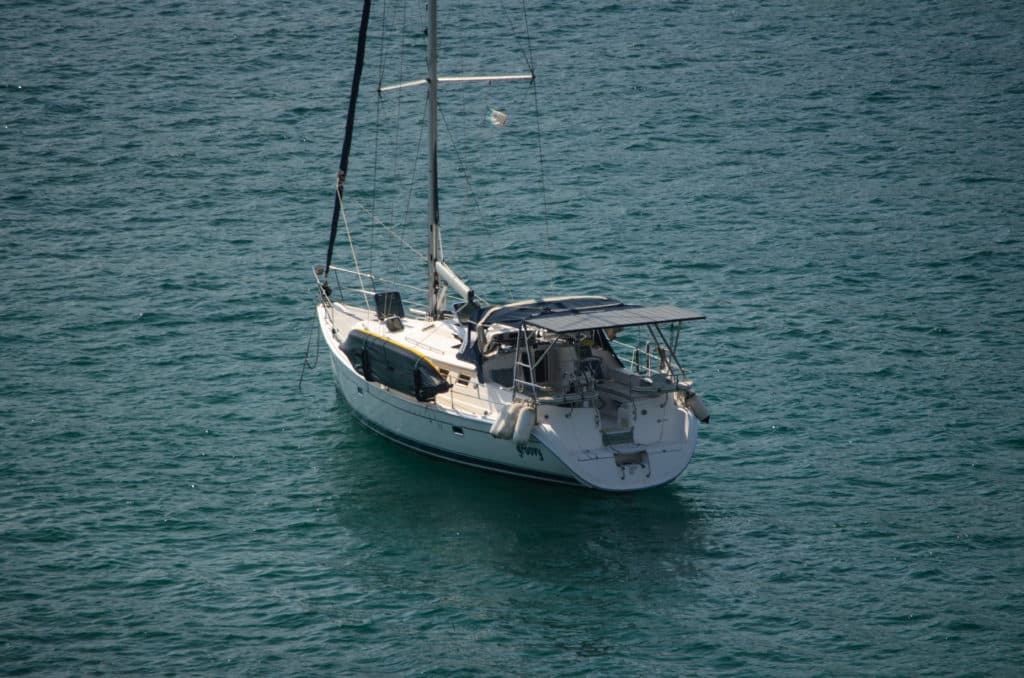
During our nearly four-year cruise of Mexico, my husband, Mark, and I lived almost exclusively on 555 watts of solar power charging a 640-amp-hour house battery bank. We anchored out virtually every night aboard our 2008 Hunter 44DS, Groovy , and relied on the sun for power. During one 10-week stretch, while we waited for a replacement engine alternator to arrive, our boat’s solar panels were our sole source of power. We had no backup charging system to turn to, and yet we lived and sailed comfortably the entire time. Mounting solar panels on a sailboat was not difficult, but a few key decisions made a huge difference in how effective our panels were.
A solar-power installation on a sailboat is made up of two independent systems: one system to charge the batteries, and another system to provide 120-volt AC power for household appliances. In the charging system, the solar panels convert sunlight into electrical current and deliver it to the batteries via a solar charge controller. Similar to a voltage regulator, the charge controller acts as a gatekeeper to protect the batteries from receiving more current than they need as they are being charged. In the AC power system, an inverter or inverter/charger converts the 12-volt DC power in the battery into 120 volts AC whenever it is turned on.
Panel Positioning and Wiring Considerations
One of the biggest challenges for sailors installing solar power on a sailboat is finding a place on the boat where the panels will be shaded as little as possible. Just a few square inches of shade on one panel can render that panel all but inoperable. Unfortunately, between the mast, radome, spreaders and boom, shadows cross the deck all day long, especially as the boat swings back and forth at anchor.
What’s worse, if the panels are wired in series rather than in parallel, this little bit of shade can shut down the entire solar-panel array. When we installed solar power on Groovy , we had already lived exclusively on solar power in an RV for over two years. Our RV solar panels had been wired in series, and we had witnessed the array shutting down current production when just half of one panel was shaded.
Choosing whether to wire the panels in series or parallel on a boat affects the wire gauge required, which is why many solar-power installers lean toward wiring the panels in series. Panels wired in series can be wired all the way to the solar charge controller with a thinner-gauge wire than those wired in parallel. This is because the voltage of panels wired in series is additive, while the current remains constant, so the current flowing is just that of a single panel. In contrast, the current flowing from panels that are wired in parallel is additive, while the voltage across them is not. This means that in a parallel installation, the current going to the charge controller is several times higher and requires much thicker cable to avoid any voltage loss over the length of the wire.
Not only is thinner-gauge wire less expensive, but it is also more supple and easier to work with, making the job of snaking it in and around various crevices in the boat and connecting it to the solar charge controller much less of a struggle. Thus the choice between series and parallel wiring boils down to a trade-off between system performance, expense and ease of solar system installation.
Luckily, the size of the wire can be reduced if higher-voltage solar panels are chosen. Since watts are determined by multiplying volts by amps, a higher-voltage panel that generates the same watts as a lower-voltage panel will produce less current. Therefore, selecting nominal 24-volt panels instead of 12-volt panels allows for the use of thinner wire sizes no matter how they are wired.
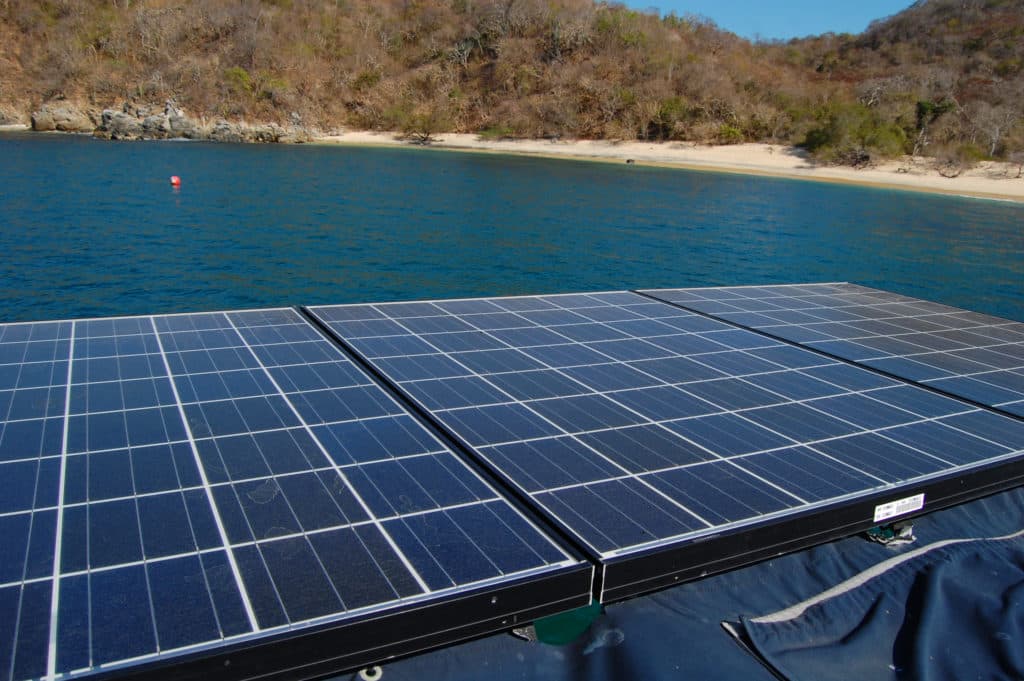
Our Marine Solar Panel Design Choices
In our installation, we decided to mount three 185-watt, 24-volt (nominal) Kyocera solar panels high above the cockpit, well aft of the boom, as far away as possible from potential shade. Our Hunter came with a big, solid stainless-steel arch, and we turned to Alejandro Ulloa, a brilliant metal fabricator at Baja Naval Boatyard in Ensenada, Mexico, to build a polished stainless-steel solar-panel arch extension onto the existing structure. He designed the arch extension with integrated telescoping davits to hoist our dinghy as well as support the solar panels. These davits were strong enough — and the lines and blocks had enough purchase — that either of us could lift our light Porta-Bote dinghy with its 6-horsepower outboard without a winch.
We spaced the panels about a half-inch apart and wired them in parallel. Using two twin-lead wires, we snaked the three positive leads and one common ground down through the inside of the arch tubes so they wouldn’t be visible, and placed wire loom over the exposed wires under the panels.
The junction points for the three parallel panels were on positive and negative bus bars inside a combiner box, all mounted in a cockpit lazarette. Inside the combiner box, we installed three breakers, one for each panel. This gave us the ability to shut off any or all of the panels if we needed to (we never did).
We mounted a Xantrex solar charge controller (model XW MPPT 60-150) in a hanging locker, as close to the batteries as possible, in a spot where it was easy to monitor and program. We ran twin-lead wire from the combiner box to the charge controller and from there to the batteries.
Our boat came with three new 12-volt Mastervolt 4D AGM house batteries, all wired in parallel, for a total of 480 amp-hours of capacity. We wanted a bigger house battery bank, and because it is best for the age, type and size of the batteries to be matched, we added a fourth new Mastervolt 4D AGM house battery, which brought our total to 640 amp-hours. Our batteries were installed at the lowest point in the hull, below the floorboards, and they ran the length of the saloon, from just forward of the companionway stairs to just aft of the V-berth stateroom door.
The best way to charge a bank of batteries that are wired in parallel is to span the entire battery bank with the leads coming from the charge controller. We did this by connecting the positive lead from the charge controller to the positive terminal of the first battery in the bank, and the negative lead from the charge controller to the negative terminal of the last battery. By spanning the entire bank, the batteries were charged equally rather than having the charging current focused on just the first battery in the bank.
We feel that AGM batteries are superior to wet cell (flooded) batteries because they can be installed in any orientation, don’t require maintenance, can’t spill (even in a capsize), and charge more quickly. Our Mastervolt batteries, like almost all AGM batteries on the market, are dual-purpose, combining the very different characteristics of both deep-cycle and start batteries. Our batteries work well, but if we were doing an installation from scratch today, we would consider the new Trojan Reliant AGM batteries. These batteries are engineered strictly for deep-cycle use and have been optimized to provide consistent current and maximize battery life.
Our boat came with a Xantrex Freedom 2,500-watt inverter/charger wired into the boat’s AC wiring system with a transfer switch. The inverter/charger performed two functions. While the boat was disconnected from shore power, it converted the batteries’ 12-volt DC power into 120-volt AC power, allowing us to operate 120-volt appliances, like our microwave. When the boat was connected to shore power, it charged the batteries.
Because this inverter/charger was a modified-sine-wave inverter, mimicking AC current with a stair-stepped square wave, we also had a 600-watt pure-sine-wave inverter to power our potentially more sensitive electronic devices. We chose Exeltech because its inverters produce an electrical signal that is clean enough to power medical equipment, and they are NASA’s choice for both the Russian and American sides of the International Space Station. For simplicity, rather than wiring the inverter into the cabin’s AC wiring, we plugged ordinary household power strips into the AC outlets on the inverter and plugged our appliances into the power strips. Like the charge controller, the inverter must be located as close to the batteries as possible. Ours was under a settee.
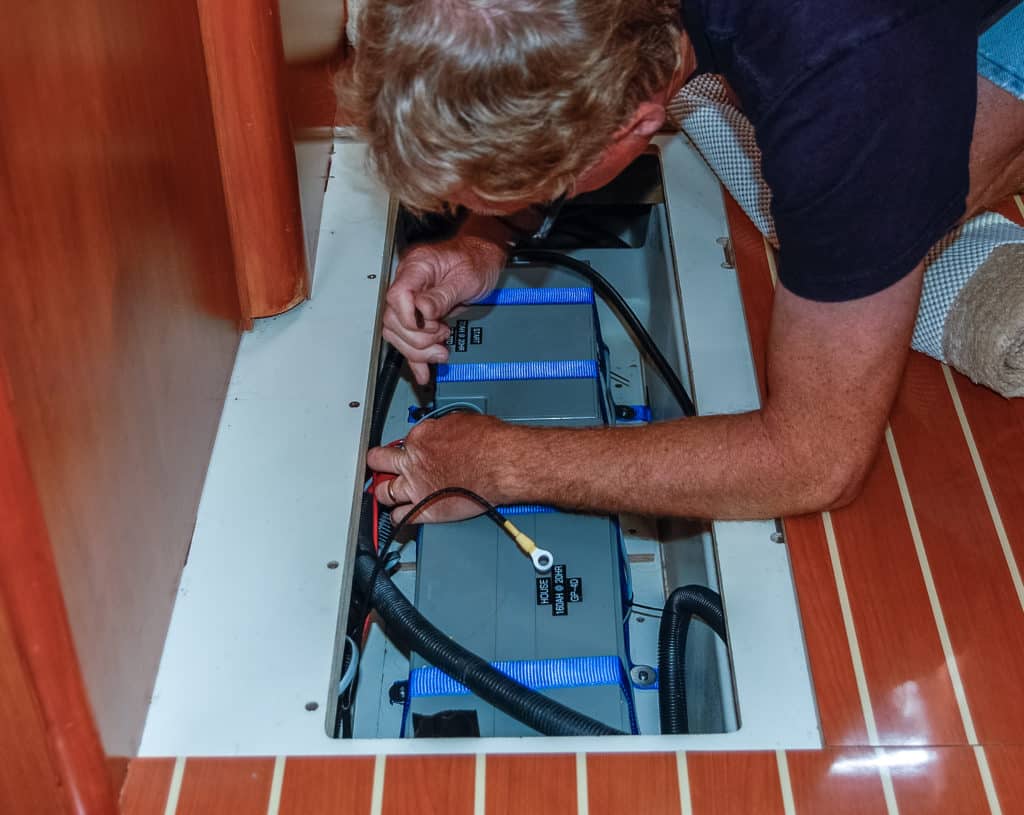
Shade’s Impact on Sailboat Solar Panels
Once our solar installation was completed on our sailboat, we closely observed the effects of shade on our solar-panel array. We were often anchored in an orientation that put the panels in full sun. Just as often, however, we were angled in such a way that shade from the mast and boom covered portions of our panels. It was fascinating to monitor the solar charge controller’s LCD display whenever the sun was forward of the beam — the current from the panels to the batteries fluctuated up and down as we swung at anchor.
Taking notes one morning, we noticed that the charging current was repeatedly creeping up and down between 9.5 and 24.5 amps as the boat moved to and fro. When the entire solar-panel array was in full sun, it generated 24.5 amps of current. When we moved so the mast shaded a portion of one panel, the array generated 15 amps. When it shaded portions of two panels and only one was in full sun, the array produced just 9.5 amps. Of course, it would have been preferable to see a steady 24.5 amps all morning, but this sure beat watching the current drop to zero whenever a shadow crossed a panel.
We discovered that shade makes a huge impact while sailing, too. Surprisingly, it is far worse to have the panels shaded by the sails than to have the panels in full sun but tilted away from its direct rays. One afternoon, we noticed that while we were on a tack that tilted the panels away from the sun, they generated 24.5 amps of current, whereas on a tack where the panels were tilted toward the sun but two of the three were partially shaded by the sails, the current dropped to a mere 10 amps.
Reflections On Our Solar Panel Installation
A wonderful and surprising side benefit of our large solar panels and arch system was that the setup created fabulous shade over the jumpseats at the stern end of the cockpit. Our metal fabricator, Alejandro, placed a support strut at hand-holding height, and sitting in those seats feels secure and comfortable while sailing, no matter the conditions.
After living on solar power for eight years of cruising and land-yacht travel, we’ve learned that you can never have too much solar power. Groovy’s 555 watts was enough to run all our household appliances as needed, including our nearly 4-cubic-foot DC refrigerator, two laptops, a TV/DVD player, and lights at night. However, it was not quite enough power to run all that plus our stand-alone 2.5-cubic-foot DC freezer during the short days and low sun angles of the winter months without supplemental charging from the engine alternator every few days. For the 10 weeks that we did not have a functioning alternator, our solution was to turn off the freezer, which enabled our batteries to reach full charge every afternoon.
Solar power made a world of difference in our cruise. Not only did it allow us to live comfortably and with ample electricity for weeks on end when our engine alternator went on the blink, but as a “set-it-and-forget-it” system, it also gave us the freedom to anchor out for as long as we wished without worrying about the batteries. In our eyes, the solar-panel arch enhanced the beauty and lines of our boat, giving her a sleek and clean appearance. It was true icing on the cake to discover that the panels and arch system also provided much-needed shade over the cockpit and helm from the hot tropical sunshine. If you are preparing for a cruise, consider turning to the sun for electricity and outfitting your sailboat with solar power.
The Installation:
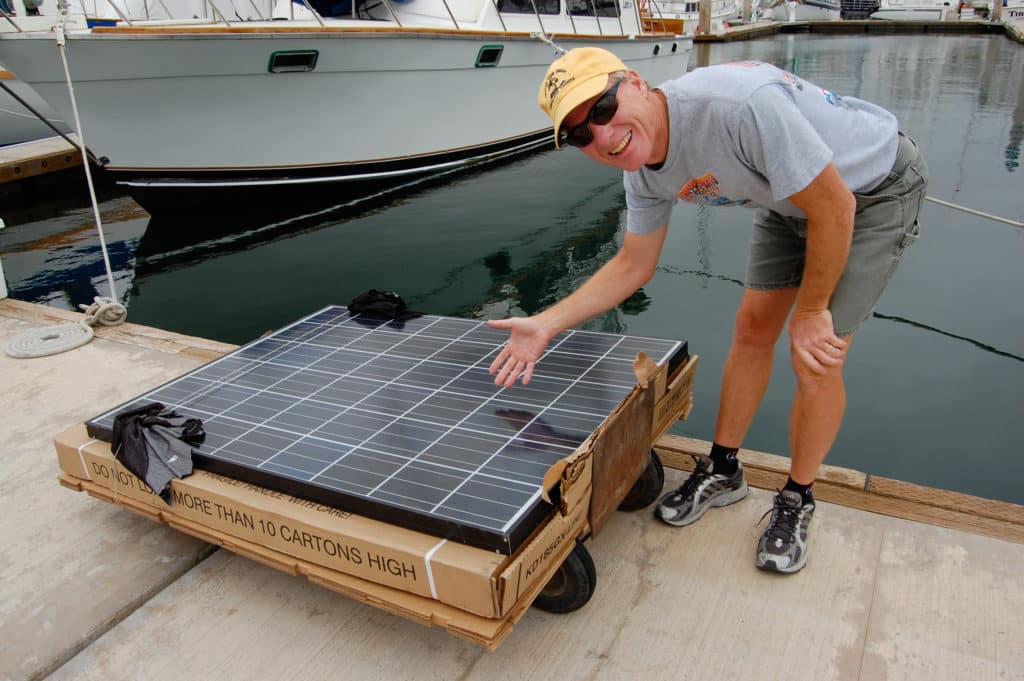
Emily and Mark Fagan offer cruising tips and share their stories and photos on their website, roadslesstraveled.us . They are currently enjoying a land cruise across America aboard an RV.
- More: DIY Sailboat Projects , green sailing , How To , installations , Refits , Sail Green , solar , solar panel , Upgrades
- More How To
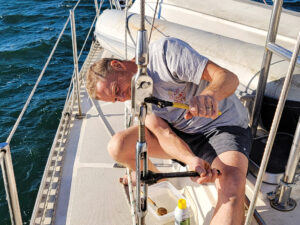
How to Rig Everything in Your Favor
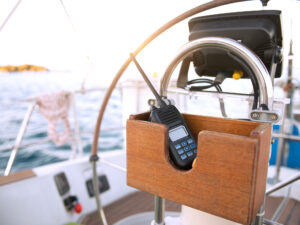
Is There a Doctor Aboard?

3 Clutch Sails For Peak Performance

It’s Time to Rethink Your Ditch Kit

Cruising the Northwest Passage

Balance 442 “Lasai” Set to Debut

A Legendary Sail

10 Best Sailing Movies of All Time
- Digital Edition
- Customer Service
- Privacy Policy
- Email Newsletters
- Cruising World
- Sailing World
- Salt Water Sportsman
- Sport Fishing
- Wakeboarding

6 Best Solar Panels for Sailboats in 2023
Categories Boating

Solar panels are a great way to power your boat and enjoy off-grid benefits. You can use them for charging batteries, running lights, or even providing you with hot water. The best solar panels for sailboats are those that can withstand the harsh marine environment and provide you with clean, quiet energy.
Six best solar panels for sailboats
Here are our top six picks for the best solar panels for sailboats:
Renogy Flexible Solar Panel 175 Watt 12 Volt
This Renogy solar panel is one of the best options for a sailboat. This product has an efficiency rate of 16-18% and will produce an average of 175 watts.
The Renogy flexible solar panel is a durable and lightweight product that can easily mount on any surface.
The best feature of this product is the 10-year warranty that Renogy provides. This solar panel can be used in any weather condition and will not become damaged or broken easily.
The best part about this product is the price. It is one of the most affordable solar panels that you can purchase. This product is perfect for any boat or RV and will provide a reliable energy source.
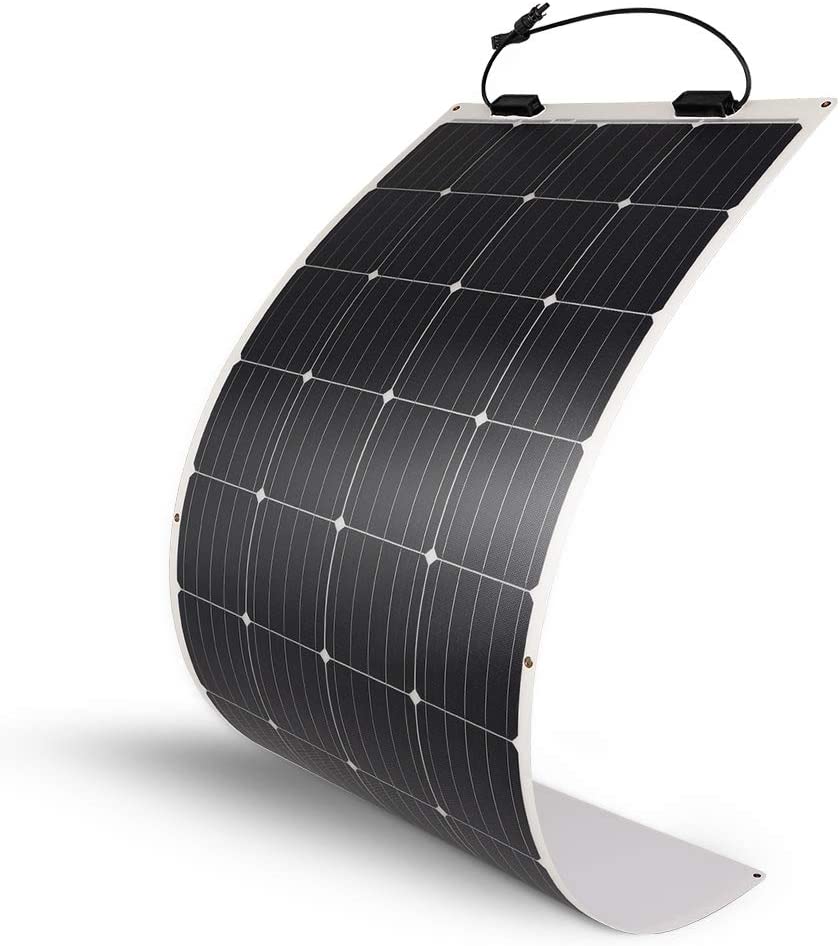
No products found.
HQST 100 Watt 12V Solar Panel
The HQST 100-watt solar panel is one of the best solar panels for sailboats. The HQST 100-watt solar panel can charge multiple batteries and other devices.
The HQST 100-watt solar panel is highly efficient as it can charge multiple batteries and other devices.
The HQST 100-watt solar panel is eco-friendly and durable. The HQST 100-watt solar panel is a one-time investment that will save you money in the long run.
The HQST 100-watt solar panel is water resistant, shockproof, and has an anti-corrosion coating.
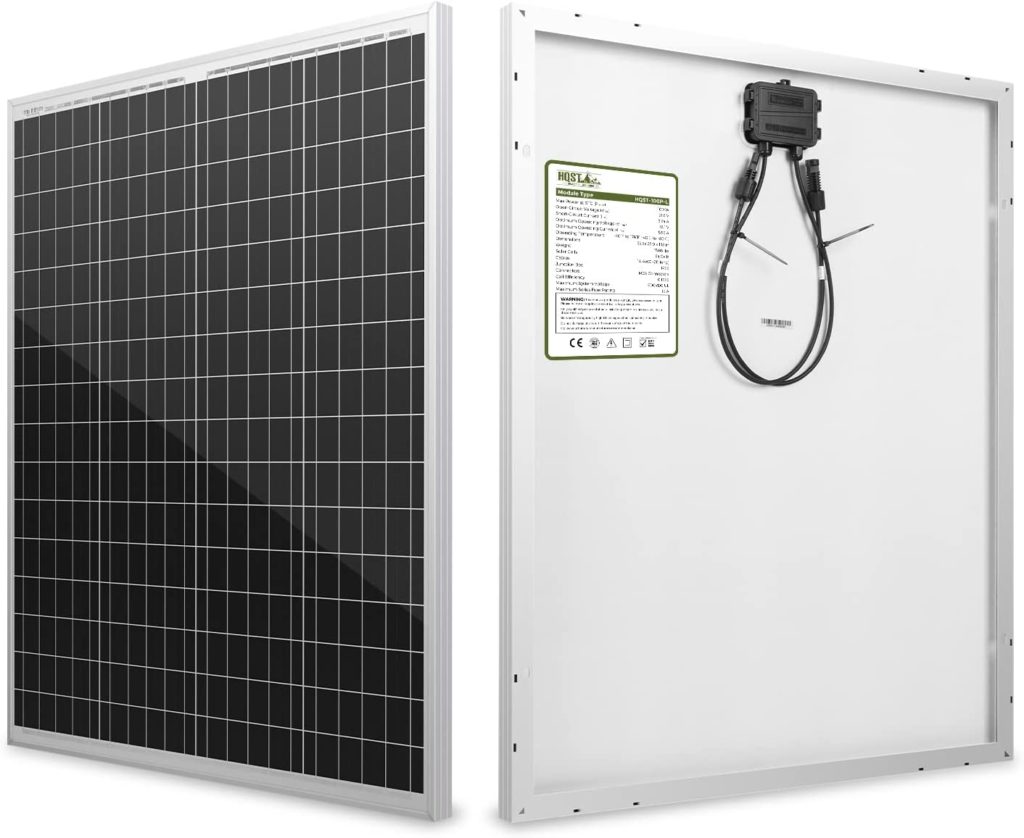
Topsolar Flexible Solar Panel 100W 24V/12V
The Topsolar Flexible Solar Panel 100W 24V/12V is an excellent option for sailboats. It is a practical, semi-flexible, cheap option. The connectors are incredibly robust and withstand lots of wear and tear over time.
The maximum energy absorption is crucial if you want to increase the performance of your solar panel.
The Topsolar Flexible Solar Panel can be mounted on pretty much any vessel, either flat on the surface of your deck or curved around the mast. This is an excellent feature as it allows you to take advantage of the sun’s energy no matter what shape your boat is.
You can use the Topsolar Flexible Solar Panel with the Topsolar Tripod for mounting your boat’s mast.
This is a great option to consider if you want something that will improve your sailboat’s performance without breaking the bank.
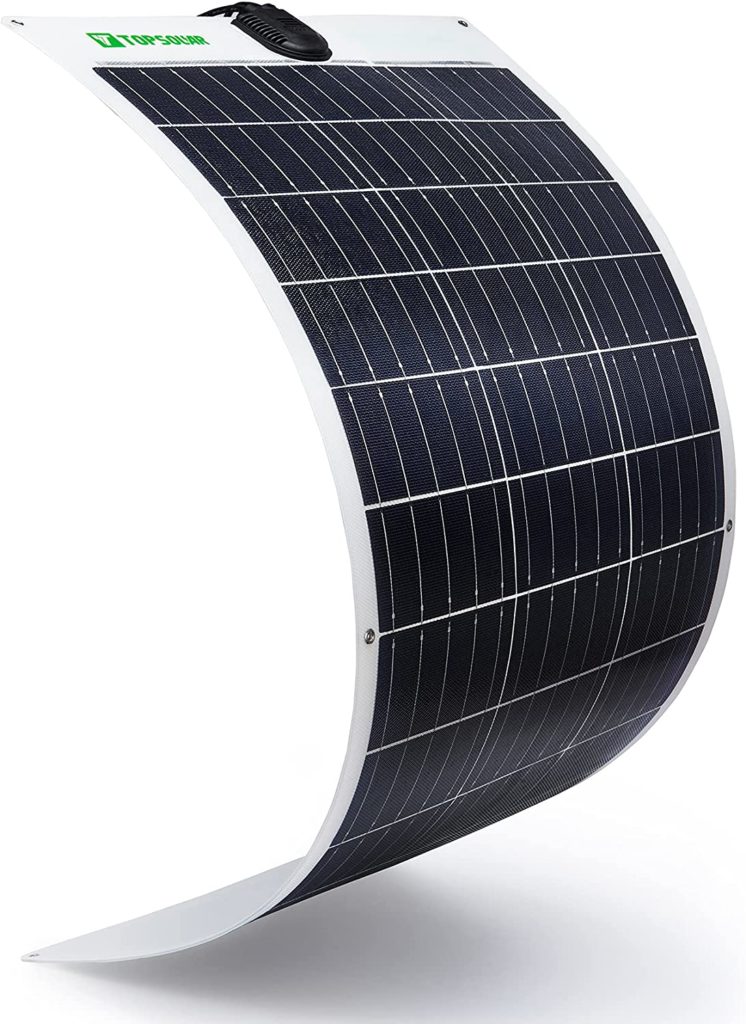
SunPower Flexible 110W Solar Panel
The SunPower Flexible Solar Panel is made with high-quality materials, ensuring durability. The solar panel can be easily portable and flexible. The solar panel has a five-year warranty on power and a two-year warranty on the product.
The solar panel is lightweight and has a durable build. The output quality of the solar panel may deteriorate over time, but you can use the extended warranty to address this issue.
The solar panel is also weatherproof, so the elements will not damage it. The only disadvantage of this solar panel is the price.
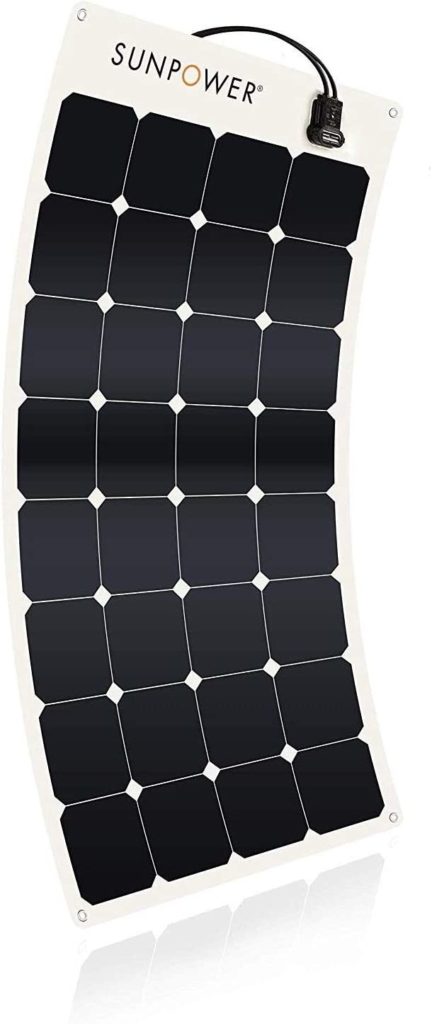
Newpowa 30W Watts 12V Solar Panel
The Newpowa 30W Watts 12V Mono Solar Panel is one of the best solar panels for sailboats. The Newpowa 30W Watts 12V Mono Solar Panel is a high-efficiency solar panel perfect for sailboats.
It is a monocrystalline solar panel that offers a 25-year transferrable warranty against a drop in power output.
The Newpowa 30W Watts 12V Mono Solar Panel is a 100% waterproof solar panel that can protect things when the doors and the soft or hardtop roofs are removed.
The Newpowa 30W Watts 12V Mono Solar Panel is a durable solar panel that can withstand weather conditions and sunlight exposure.
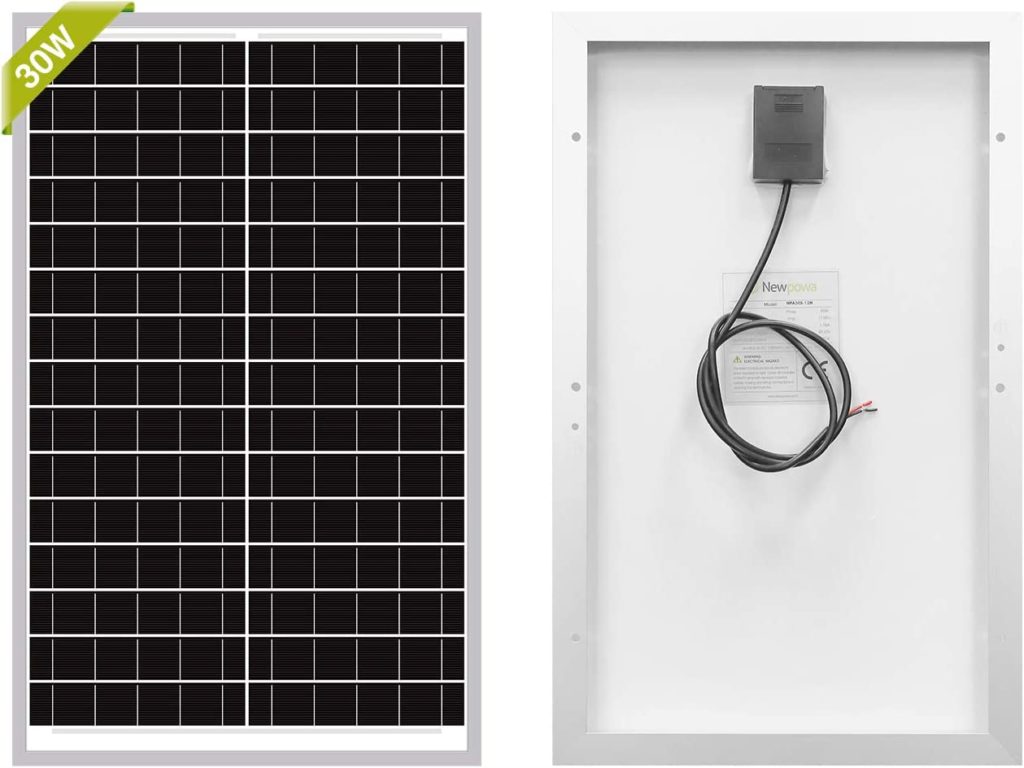
ECO-WORTHY 100 Watt Solar Panel
The ECO-WORTHY 100 Watt Solar Panel is one of the best solar panels for sailboats. This panel type comes with a warranty and IP65 water and dustproof rating.
This solar panel is lightweight (only 13 pounds) and has all the accessories needed to install it on your boat. The panel is easy to install and waterproof, so you don’t have to worry about any damage from the rain or water splashes.
The ECO-WORTHY solar panel is designed to work well with different types of boats. It has everything you need to install on your boat, including a mounting bracket and an MC4 connector cable.
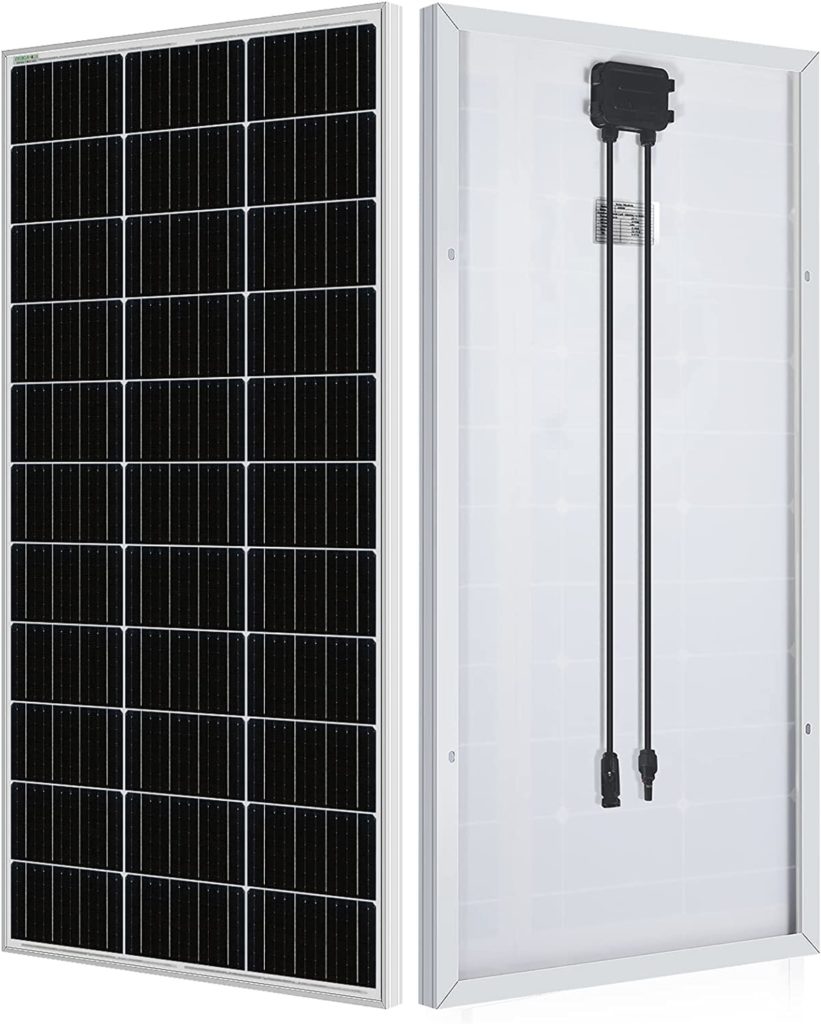
How to choose the right solar panels for your boat
To choose the right solar panels for your boat, you must determine how much power your boat uses. The first step is to determine how many amp hours your appliances use daily.
You can use a battery monitor to measure the energy your fridge, lights, or the other appliances on your boat consume while in use.
After finding the amp hours your boat uses per day, you can determine the wattage of power your solar panels need to produce. For example, if you have a 50-watt panel and use 30 amp hours per day, you would need two 50-watt panels to produce enough power for your needs.
Additional things to consider are whether you need a charge controller and if you have enough unshaded space for your solar panels to absorb the maximum amount of sunlight.
What are Flexible and Rigid Solar Panels?
Rigid solar panels are more efficient but less robust than flexible panels. Monocrystalline cells offer a better output than polycrystalline cells. The output voltage depends on the number of cells on the panel.
Module efficiency is now more often around the 20% mark, as opposed to 12-15% for older models and semi-flexible (up to 20° bend) is usually better than flexible (up to 180° bend).
If the maker offers a 25-year guarantee instead of a 3-5 year one, you can be pretty confident they’re good. Regarding charge controllers, it’s worth paying a little more for a decent MPPT.
How many solar panels do I need for my sailboat?
You will need between 2-8 solar panels for your sailboat. The amount you need depends on the size of your sailboat and how many electronics you need to power. 2-4 panels should be enough if you have a small sailboat. For larger boats with more electronics, 4-8 panels are recommended.
What are the benefits of solar panels for sailboats?
Solar panels are a great alternative to running a gasoline generator or taking power from the grid. Solar panels are eco-friendly and can be a lifesaver if you are at sea for a long time. Solar panels can provide comfort amenities such as access to a tv, microwave oven, etc.
Solar panels are an excellent option for sailboats because they are eco-friendly and have many benefits that make sailing more enjoyable. The best solar panels for sailboats are durable, easy to install, and produce a lot of power.

What are the disadvantages of solar panels for sailboats?
Solar panels for sailboats rely on the sun on to generate electricity. Sailboats are limited in space and cannot carry large solar panels. Solar panels can be expensive to install on a sailboat. Solar panels for sailboats are less efficient on cloudy days.
How much do solar panels for sailboats cost?
Solar panels for sailboats cost a few hundred dollars each. Permanent solar panels can cost one or two thousand dollars in some cases. Portable solar panels can cost just a few hundred dollars each.
If you are installing permanent solar panels because you plan to be making long voyages, it is ideal to have two or perhaps even three large batteries hooked up to your boat.
Do I need a professional to install solar panels for sailboats?
You do not need a professional to install solar panels for sailboats. Solar panels can be installed on sailboats by anyone that is reasonably handy. You can also install solar panels yourself if you are handy.
If you do not feel comfortable installing solar panels yourself, you can hire a professional to install the system for you. An excellent marine electrician will be able to help with your solar panel installation.
Are Solar Panels Safe On Sailboat Boats?
Solar panels are generally safe to use on boats. The panels themselves have a minimal risk of starting fires. However, if they are damaged, they may become unsafe.
Solar panels are covered by glass that keeps them safe from sharp shards of glass. However, if the panel gets wet, it can become deadly due to the combination of electricity and water.

The best of EcoWatch right in your inbox. Sign up for our email newsletter!
- About EcoWatch
- Contact EcoWatch
- Terms of Use
- Privacy Policy
- Learn About Solar Energy

Top 5 Best Solar Panels for Boats (2024 Marine Buyer’s Guide)
In this guide, you’ll learn:
- Why photovoltaic (PV) equipment is great to have on your boat
- Which panels are best suited for use on the water
- What qualities make for a great boat solar panel
Each product and or company featured here has been independently selected by the writer. You can learn more about our review methodology here. If you make a purchase using the links included, we may earn commission.
Why Should You Install Solar Panels On Your Boat?
Before we dive into the best panels to bring your boat into the world of clean energy, it’s worth discussing why you’d want a solar panel system on your boat in the first place.
There are a few use cases that are important to consider. These not only dictate whether or not you need panels on your boat, but they can also help you decide which system is the best and most cost-effective for you. We’ll discuss the different reasons to go solar on your boat below.

Blue Raven Solar

Regional Service
EcoWatch rating
Average cost
- Industry-leading in-house financing
- Competitive pricing
- Excellent reputation
- Doesn't offer solar batteries (coming 2022)
Charging Emergency Equipment
For anyone who has run into issues out at sea, the need for reliable emergency equipment is well understood. Whether you run out of gas, your boat breaks down or you have some other issue that precludes you from getting back to shore, having a way to reach out for help will keep your mind at ease.
Depending on the type of boat you have and how well it’s equipped, you may have a radio system, a satellite phone, a regular phone or some other communication device for emergencies. All of these require power, and having a solar system on your boat ensures that you’ll always have access to these devices.
Charging Recreational Equipment
Even if you’re not running into problems at sea, you might want the ability to charge recreational equipment. It’s always nice to have the ability to charge smartphones, e-readers, speakers and other devices you might use for entertainment.
This is especially important if you plan on spending a few days at sea and don’t want to rely on your boat’s batteries. Keeping those well charged for lighting, navigation tools and starting your boat’s engine is more important than getting your phone up to a full charge.
Quality of Life at Sea
For a lot of people, there’s a lot of joy in upgrading life at sea and making things just a little more comfortable. One of the perks of installing a solar system on your vessel is that you don’t have to worry about using your boat’s batteries for non-necessities.
For example, many recreational boaters connect their solar array to an electric cooler. Others use their solar modules to power electric water heaters for hot showers and constant hot water.
The possibilities for improving your at-sea experience with solar are really up to you, which is part of what makes bringing renewable energy to your boat so exciting.

What Are the Top 5 Best Solar Panels for Boats?
If you’re convinced you want to install solar on your boat, but you don’t know much about the available options, you might be overwhelmed by the choices. You’ll have access to seemingly countless brands and models.
To help you narrow down your options and choose panels that will meet your needs, we’ve done extensive research and chosen just a few product lines that we recommend. We’ll provide a quick breakdown of the different options below, and we’ll dive deeper into the specifications in later sections.
SunPower 170W Solar Panel
SunPower is a leader in the residential solar industry, so it’s no surprise that we found that the company also makes the best solar panels for use on boats.
This panel is pricey, but it’s significantly more powerful than most other options. At 170 watts, you can use these panels to charge your boat’s main battery, provide backup power for emergencies, or live large on the water by powering coolers, hot water heaters and much more.
This panel doesn’t come with a solar charge controller like many other options do, so not only is it expensive, but you’ll have to lay out more money for a controller, inverter and battery. However, we believe the efficiency and power output are well worth the investment.
These panels are also rated with a waterproof rating of IP67, which means they can withstand immersion in water up to about three feet for around half an hour. If you need more protection than that, you have bigger problems on your hands than losing a panel.
- High-efficiency panel for maximum power
- High-quality, durable materials
- Trusted and reliable brand
- Waterproof up to a meter for 30 minutes
- Doesn’t include any equipment other than the panel
Renogy 100W Flexible Marine Solar Panel
The Renogy Flexible solar panel designed specifically for use on the water is our pick for the best bang for your buck. It’s about half the price of the SunPower panel, although it does have a little more than just half the power capacity.
At 100 watts, this panel is great for middle-of-the-road power. It can serve as a reliable backup source of energy, or you can use it to recharge phones, GPS devices, e-readers, laptops and other electronics. It’s possible to use it for the quality-of-life items mentioned above as well.
This panel also has an IP67 waterproof rating, which is ideal for maintaining peace of mind on the water. Although it’s less expensive than our top pick, it includes a controller and wiring to connect your panels. You’ll just need an inverter and a battery to complete your setup.
- Excellent power output
- IP67 waterproof rating
- Includes controller and wiring
- Reliable brand name
- More expensive than many other options
- Doesn’t include a battery or inverter
EcoWorthy 25W Solar Panel Kit
The EcoWorthy solar panel kit is one of the easiest photovoltaic (PV) systems to install, so it’s our top pick for those looking to get started with clean energy. You can purchase this kit with a 10 amp-hour (AH), 12-volt battery, and the MC4 connectors are plug-and-play for a quick and painless installation.
This panel has a much smaller output than our top two picks, so it’s best reserved for backup power or for charging cell phones and other small electronics.
This kit has a waterproof rating of IP65, which means it can withstand being submerged in around five feet of water for up to a half hour, and it will also be protected from sprays of water. This is a great option for maintaining peace of mind when you’re on the water, especially if conditions are rough.
Lastly, the kit includes a panel, a controller and wiring, so you’ll just need to add a battery and an inverter to complete your kit.
- IP65 waterproof rating
- Includes a controller and wiring
- Very affordable
- Significantly less power than our top picks – Only ideal for light-duty use
NewPowa 30W Solar Panel Kit
This 30 watt solar panel kit from NewPowa includes a panel, a controller and wiring. If you add a backup battery and an inverter, you can create a complete off-grid solar kit for less than $150 without leaving your home (thanks to Amazon).
With an output of 30 watts, this is the best marine solar panel for light-duty use, although you could use it for non-essential electronics like an electric cooler or a small solar water heater. Those more demanding devices should be low-use, though.
The panels and controller are IP67-rated, so they’re suitable for use on just about any boat.
Best of all, the partial solar kit is just $60, so this makes our list as our top budget pick for going solar without breaking the bank.
The kit has pre-drilled mounting holes and is compatible with a wide variety of mounting brackets. As such, your installation process should be relatively straightforward.
- Includes a controller and plug-and-play wiring
- Relatively low wattage
TopSolar Monocrystalline Solar Panel Kit
The off-grid solar kit from TopSolar is a great affordable option, and it’s what we’d recommend as a starter kit for backup energy for beginners. It only puts out 20 watts, so this is not the best option if you’re looking for something to charge your recreational devices or quality-of-life equipment. However, it’s an affordable and easy-to-install kit for emergency power.
Unfortunately, this kit doesn’t include a specific ingress protection (IP) rating, but the manufacturer does note that the product is waterproof. Based on customer reviews, it appears that this product is safe for use on the water.
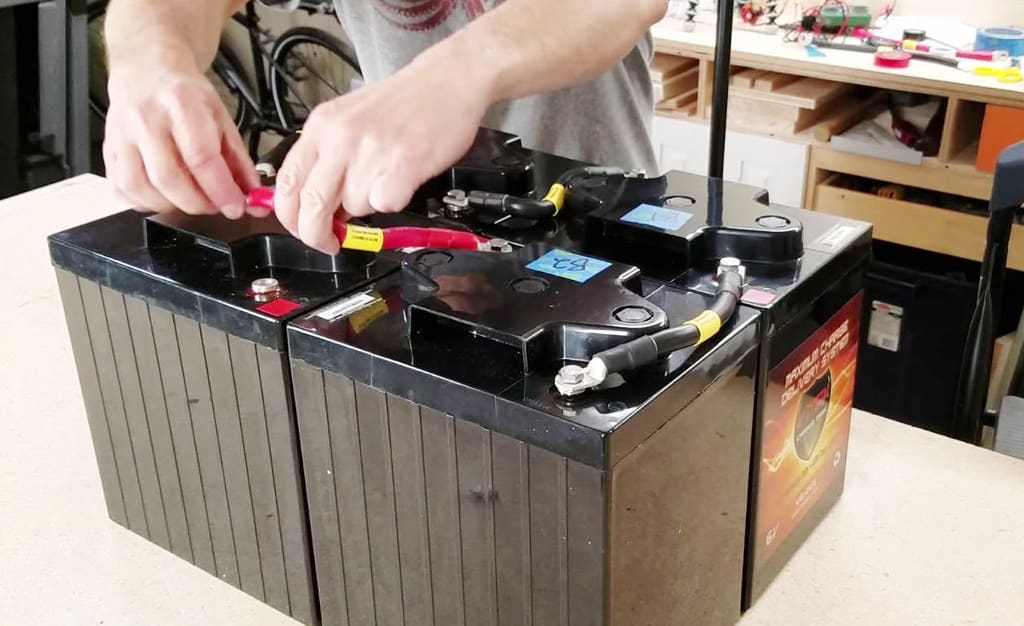
The kit includes a small PV panel, a controller and wiring, so you’ll need to buy an inverter and battery separately if you want AC power or backup power.
Best of all, the kit is super easy to install. It has pre-drilled holes and is compatible with most mounting brackets and clips.
- Great option for backup power
- Easy to install
- No official IP rating
- Low wattage
What Should Boat Owners Look for When Buying Solar Panels?
Solar panels can be a great option for marine use, but not all panels and solar kits are suitable for use around water. Additionally, the panel you choose needs to be selected based on how you want to use your solar power system.
In the sections below, we’ll include a few key things you’ll want to consider when choosing a solar module for your boat.
Energy Needs
One of the first things we recommend thinking about is how much energy you need your panels to generate. This will help guide you to what size panel and how much energy output you need.
If you’re just looking for reliable backup power for your boat’s internal 12-volt battery, or you want your panels to provide power for emergencies only, you’ll probably only need a panel of around 20 watts.
If you use your boat frequently for entertaining guests, or you spend days at a time on your boat, you might want something above 100 watts to provide backup power plus electricity for electric coolers, water heaters and more. Consider everything you’ll use your solar array for and size your system accordingly.
The chart below provides a quick breakdown of what size solar panels you need for different purposes on a boat.
If you plan on using your panels to replace an on-board generator, you can calculate how much electricity your boat uses and then size your system accordingly. It’s always advisable to go a little bigger than you think you need, as cloud coverage and the angle of the sunlight hitting your panels can cause fluctuations in solar power production.
If you have high energy needs, we also recommend considering a Maximum Power Point Tracker (MPPT) controller, which is more efficient than a Pulse Width Modulation (PWM) controller, which is more common.
Space Available for Installation
Just like residential solar systems are limited by available roof square footage, marine solar systems are limited by the available space for installation. This is an important consideration to make to ensure you don’t buy a panel that you won’t be able to mount or use in your vessel.
Before you buy any equipment, we recommend checking the measurements of the panel and deciding where on your boat you can install it. Some portable, foldable panels come with kickstands for temporary setups, but the smaller of our top picks can be set up just about anywhere without mounting brackets as well.
Type of Solar Panel
You’ll have a few choices for the type of panel you purchase for your boat as well.
First, you’ll need to decide between thin-film solar panels, polycrystalline solar panels and monocrystalline solar panels.
- Monocrystalline panels are the most efficient, so they’re the best suited for use on boats. The higher efficiency ratings will let you produce more energy per square foot, which is essential on a boat where space is limited. All of our recommendations above are monocrystalline.
- Polycrystalline solar panels can also work, but they won’t provide as much solar power.
- Thin-film panels are the most affordable, but they generate even less electricity and aren’t ideal for use where available space is minimal.
Second, you should think about whether you want a rigid solar panel with an aluminum frame or a semi-flexible one. Flexible panels contain special solar cells that can be a bit pricier, but they’re easier to install and are a bit more versatile. They can be mounted on curved surfaces, giving you more placement options.
Waterproof Rating
Since you’ll be using your panels on the water, it’s essential that you choose one with a good waterproof rating. Some of the best options are IP67 and IP65. These will ensure your panels and charge controllers or regulators remain safe and at low risk of fire even when exposed to moisture and direct water contact.
Accessories
Finally, you should consider what your kit comes with. Some come with only panels, so you’ll need to buy a controller, an inverter and a battery to complete your setup. Some come with a combination of these parts, although batteries and inverters aren’t commonly included. Some panels also include mounting brackets, although this is also uncommon.
Thinking about the additional equipment you’ll need to purchase after buying your panels will help you budget more effectively for your entire system.
How Do Solar Panels Work With Boats?
PV panels for boats work just like panels for residential use — they collect sunlight and route the energy either to a storage or use system.
Since boat solar systems are entirely off-grid, most require the following:
- Solar panels
- A charge controller
- An inverter
- Mounting brackets or other mounting hardware
- A backup battery for energy storage
We’ll explain what each of these components does in the section below, and then we’ll get into how to set up and maintain your system.
Equipment for a Marine Solar System
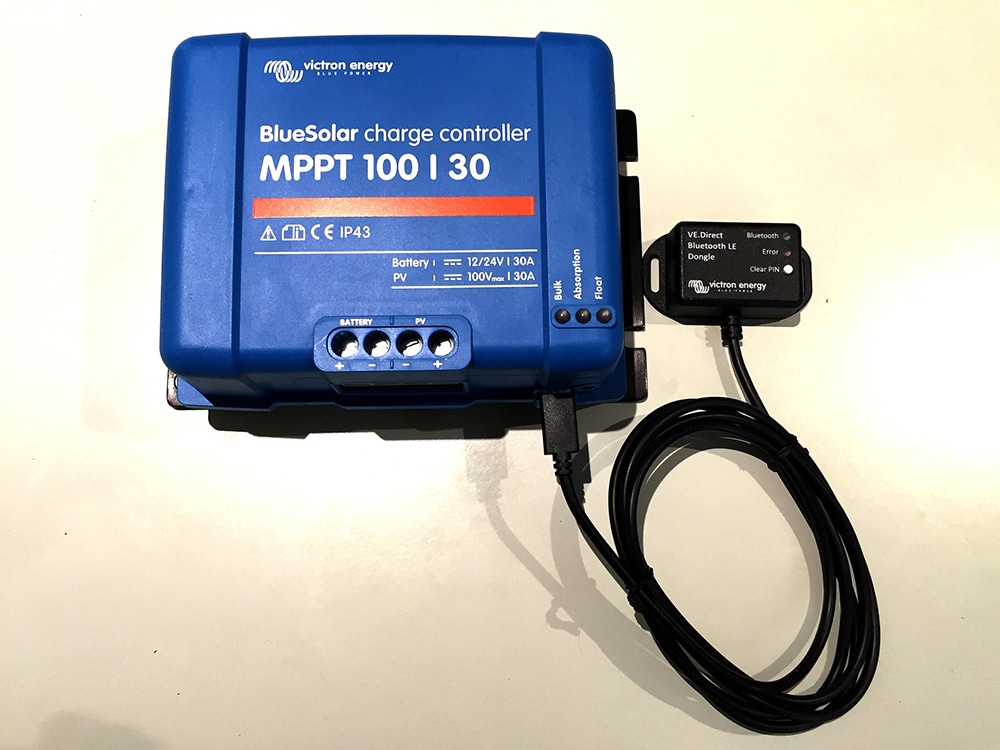
The main components you’ll absolutely need for your boat solar system are PV panels and a controller. If you plan to store energy or use it to charge common electronics, you’ll also need a battery and an inverter.
The panels are the pieces of the system that collect energy from the sun. The electricity generated is then passed to your controller, which limits the amount of power that flows through the wires to your battery or device.
The charge controller helps prevent overcharging batteries or electronics when production is high, and it also prevents battery drainage when production is low. Some panels are equipped with bypass diodes to provide the same safety features.
The solar energy that’s collected is direct current (DC), while most electronics, including standard light fixtures, use alternating current (AC) power. An inverter is used to convert DC current to AC so that you can use your solar power to power devices directly. If you don’t have DC lights in your boat, for example, an inverter might be necessary to provide lighting.
A battery storage system is exactly what it sounds like: it’s a battery bank that stores solar energy for later use.
Solar batteries are useful for two main reasons on boats.
- First, if you ever experience cloudy days, your solar production might very well drop below what you need to provide power to your devices. In that case, having a battery to pull stored energy from can be helpful in maintaining charging capability or electricity.
- Additionally, a battery on board can be useful for maintaining backup power for emergencies. If your boat’s built-in battery ever fails or you need to charge emergency communication or navigation devices, a battery will come in handy.
Installation
Since you want your solar panels to be exposed to as much sun as possible, it’s best to install them at or near the highest point on your boat — often the bimini. This will prevent them from getting shade from other parts of your boat during the day, regardless of which direction your vessel is moving.
It’s also typically best to install your panels as close to parallel with the surface of the earth as possible. Since your boat will be moving around a lot, it’s not realistic to install them facing the path of the sun in the sky as you would on a home. Laying them flat gives you the best chance of always collecting at least some sunlight.
You, of course, need to consider available space as well, so remember to take measurements of your installation site and compare them to your panels before beginning the process.
Finally, you should consider where your batteries will be — if applicable — and where your wiring will run once your installation is complete. Keeping these things in mind will help ensure that the installation process goes as smoothly as possible.
Below, we’ll include a brief step-by-step guide on how to install a solar system on your boat.
- First, take measurements of where your panels will be installed, the path the wiring will take to all components and where your battery, inverter and controller will be placed. Making sure you have enough room for all of your components will help avoid headaches once you get started.
- We recommend mounting your batteries, inverter and controller first. These are generally the easier components to mount, so they’re the easiest to move once installed.
- Next, mount your panels. The process for this will depend on the panels you choose and where you plan to install them. You should follow the installation instructions for the mounting brackets or hardware you purchase.
- Finally, you can wire your system, beginning with the connection between the panels and the controller and then the connections to the inverter and battery.
- You can test your system by using a voltmeter or by checking to see if your powered devices function as intended. Some controllers will also show you if your panels are providing energy and how much they’re producing.
For more guidance and information on how to set up your boat solar system, you can check out the video below:
Maintenance
Thankfully, solar systems are relatively maintenance-free once installed, although you should carry out routine system checks and cleaning to ensure you continue to enjoy maximum safety and energy production.
You should spray down your panels with water about once every six months to get any accumulation of dirt or salt off of them. This will help maximize energy generation. Around the same time, you should also check the wires and connectors for corrosion, which is more likely to occur if you use your boat in saltwater.
After major storms, it’s a good idea to ensure that none of the connections between components were lost. A simple disconnect could lead to your battery charging issues, which could be an issue if you ever need backup power.
Lastly, it’s worth mentioning that solar systems on boats are generally considered safe. There is a small risk of fire but provided you carry out the proper maintenance, you should avoid any serious issues.
Are Marine Solar Panels Worth It?
The answer to this question really depends on who you ask. For some boat owners, PV panels are essential. Not only can they provide backup power for emergencies, but they can also improve your quality of life at sea and the enjoyment of your boat.
For many people, these things are indispensable, so solar systems are well worth the investment. For certain types of boats — like small fishing boats and sailboats — solar panels will be the only source of electricity.
Other boat owners feel comfortable relying on generators if they have them, and some use their boats only for short durations, which makes having an on-board solar array less valuable.
For most people, though, having at least a small solar system to provide backup power for emergencies is worthwhile. From there, opting to up the size of your system to improve your time at sea isn’t hard to get behind.
FAQ: Marine Solar Panels
Below, we’ll answer a few of the most common questions we get about solar panel systems made for boats.
What are the best marine solar panels?
In our opinion, the best solar panels for boat use are the SunPower 170W solar panels. These are flexible panels that allow for easy and versatile installation.
They are some of the most efficient panels suitable for boat use, and they provide an incredible 170 watts each. This is enough power for just about anything you need electricity for on your boat and for emergency equipment in low-light conditions.
These panels are a bit expensive, and they don’t come with any additional equipment. However, the junction boxes have a waterproof rating of IP67, come with a five-year warranty for equipment and high efficiency and are made from high-quality, durable materials for years of use.
Will solar panels keep my boat battery charged?
Yes, solar panels can be hooked up to keep your boat’s 12 volt battery charged. However, you need to make sure you install a system that is sized appropriately for your boat’s needs.
You can check how much power your boat draws from its battery system by looking at the loads (in amps or watts) of each device. You can also use your battery monitor if you have one to check the energy demand of each individual component pulling power. Then, choose solar panels that produce a bit more energy than your system needs.
If you live in an area that experiences a lot of cloudy weather, you might want to size up your system even more to ensure your system generates enough electricity.
How much does it cost to put solar panels on a boat?
The cost to install a solar array on your boat can range from around $150 up to well over $1,000. Where in this range your total falls depends primarily on how much energy you need to produce.
If you’re looking for portable solar panels to take on and off a small boat with you for emergency use only — which is typical for sailboats and smaller boats that don’t normally have electricity — you’ll likely be looking at the $150 end of the spectrum.
If you have a much larger boat and want to be able to maintain power for your essential equipment and some non-essentials, then you’ll likely push your all-in cost closer to the higher end of the range.
What are the benefits of solar panels on boats?
Installing solar panels on your boat can provide quite a few key benefits, although the perks you’ll actually experience depend on your situation and your specific boat.
Perhaps most importantly, solar panels can charge your boat’s battery and maintain electricity for emergencies. Most systems — even small ones — can serve to charge your phone, GPS or other emergency devices in case you run into problems out on the water.
Larger systems can also provide power for recreational use, like charging phones, powering speaker systems, keeping beer cold and more.

Related articles
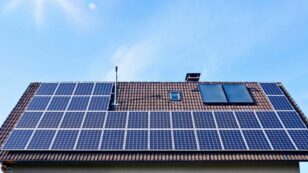
Calculate Your Solar Panel Payback Period (How Long To Recoup Costs?)

Solar Panel Cost In 2024 (Homeowner’s Installation Savings Guide)
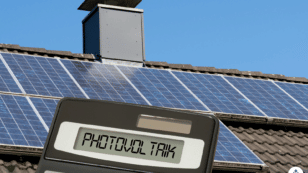
Solar Calculator
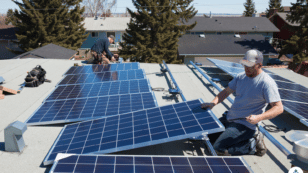
Top 6 Best Solar Companies Review
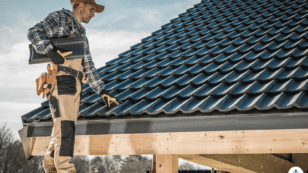
Solar Roof Shingles 2024 Cost and Buying Guide
Related Solar Panel Guides
- Buyer’s Guide: Best Solar Panels for Camping (2022)
- 7 Best Solar Panels for Mobile Homes (2022 Guide)
- What Are the Best Solar Panels for Farming Solar for Agriculture Guide (2022)
- The Best Solar Panels for Portable Solar Generators
- 5 Best Flexible Solar Panels (2022 Reviews and Buyer’s Guide)
Comparing authorized solar partners
Having trouble deciding? Click below and use our process to receive multiple quotes instead:

- Forums New posts Unanswered threads Register Top Posts Email
- What's new New posts New Posts (legacy) Latest activity New media
- Media New media New comments
- Boat Info Downloads Weekly Quiz Topic FAQ 10000boatnames.com
- Classifieds Sell Your Boat Used Gear for Sale
- Parts General Marine Parts Hunter Beneteau Catalina MacGregor Oday
- Help Terms of Use Monday Mail Subscribe Monday Mail Unsubscribe
Solar panel question/Recommendations
- Thread starter artleyt115
- Start date Jan 25, 2023
- Forums for All Owners
- Ask All Sailors
Attachments
- Power plan.pdf 54.7 KB Views: 69
You need to get a charge controller for the solar panel... then... yes... it would be okay to hook it up to your one battery. @Maine Sail has a few good writeups on this topic.
artleyt115 said: Hello everyone! It’s me again asking more power questions (Hooray!) so I have all my devices in the boat now and I drew up a little excel sheet of how much everything can consume and the hours we plan to run the devices. Now by my (poorly done) math I should expect around 4 day of battery usage of my one GEL 100ah battery with all electronic do-dads on the boat. Now some things (like the fridge) were put at the average consumption, though when I wrote the excel sheet, I put both the initial cooling wattage and the idle wattage (I plan to run that in the house over night before a trip to get the fridge to temp then put it in the boat). So, my questions; if I add another battery in parallel, in theory it should give me 4 days of capacity. If I add another battery, can I put a 200w solar panel on the boat and expect the batteries to be able to take the possible 30amp it can (potentially) produce. And can I put the same solar panel on just one battery for now (Until I buck up and buy the other one) and expect one battery to withstand it? Also (I know sorry) I have a 10a (2 bank) battery charger that I am hooking up, if I get two batteries in parallel can I put one bank on each battery? View attachment 212454 Click to expand

dlochner said: You're off to a good start. If you are unsure of your math, please post the spreadsheet so we can check the formulas, much easier than doing the math ourselves. A few comments: Pick one unit of power, either watt hours or amphours, it is much less confusing that way. Batteries placed in parallel should be of the same age and type to ensure the charges on the battery are balanced. This will lead to longer battery life. Lead Acid batteries generally have a maximum usable capacity of 50% of the total capacity, if the battery is fully recharged between discharges. Realistically, when cruising or when shore power is not accessible, they have a useable capacity of 40%. There are a few exceptions, carbon foam batteries and a couple of high end AGMs have a larger capacity, up to about 70%. Charging a battery is inefficient, it will take between 110% to 120% of the used ah to recharge the battery, i.e., for every 10 ah that is used, recharging will require 12 ah. Solar panels will average efficiencies can be expected to produce 3 times the nominal power each day. A 100 watt panel will produce about 300 watts (25 ah) on average per day, less on cloudy days, a little more on bright sunny days. High efficiency panels (expensive) panels can get close to 4 times. AGM batteries can generally absorb 20 to 40% of their rated capacity when charging in the bulk phase (constant current). This is written as .2C. A 100 ah battery can take a charge of 20 to 40 amps in the bulk phase. Reputable battery manufacturers will use the 20-hour discharge rate to label capacity. Less reputable ones will use the 10 hour rate which tends to yield a higher capacity rating, but less actual capacity in real life settings. A two bank charger can not deliver more than its rated capacity. When 2 batteries are connected, the charge current is divided between the two batteries. Your 10a charger will only put out 5a per battery, which will lead to under charging and very long charge times. Click to expand
dlochner said: You're off to a good start. If you are unsure of your math, please post the spreadsheet so we can check the formulas, much easier than doing the math ourselves. Click to expand
artleyt115 said: This is some really good information, from the sounds of it I should be able to use the 200W solar panel with no issues. (especially with a controller) I'll attach the sheet (though I did not use the formulas on the sheet I just hand did the math) I figured the charger was under powered for even one battery but I mainly figured it was a trickle charger to keep in the boat when I have it on a trailer. Though I didn't know about that absorption rate on the battery, that's awesome! Btw I heard through the grape vine that when a batteries are in parallel they have to be charged slower, is this true? (I don't think this is true but I thought I'd ask) Click to expand
Ralph Johnstone
artleyt115 said: The site wont let me post it :/ Click to expand
artleyt115 said: ... (especially with a controller) ... Click to expand
Timm R Oday25
A couple of thoughts . We also have 25 Oday . A 200 watt solar panel is going to take up an enormous amount of room . We mounted a 30 watt off the back of the rear pulpit . I ran the wiring inside the railing ,under the cockpit and into the regulator mounted on the back of the bulkhead . Most of the electronics you have listed most likely will only run randomly throughout the day . We actually have two solar panels, one for each battery . The "charging" we get from the outboard is maybe 3 to 4 amps . Normally ,we draw down one battery until we are at 12.3 volts . We then flip the battery selector switch to the other battery . While we don't have refrigerator, the auotpilot uses several amps at a time when in use. We've been able to stay out for as long as a week this way
Timm R Oday25 said: A 200 watt solar panel is going to take up an enormous amount of room . Click to expand
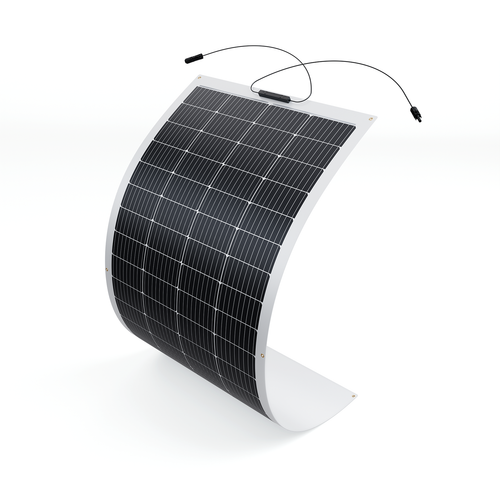
200 Watt 12 Volt Flexible Monocrystalline Solar Panel

Highest Efficiency (up to 25.4%)And Best Flexible, Rigid, And Walkable Marine Solar Panels For Your Boat in 2023. We'll help you decide on the right solar panels to meet your power needs.

Maintenance of Flexible Solar Panels
dlochner said: I didn't realize the site blocked excel files, probably because of macros that could hide malicious code. You must use a controller. The Victron controllers with Bluetooth are a good choice, easy to program and efficient. When batteries are in parallel or series they act as one large battery. Batteries in parallel will increase the ah capacity and the charge capacity will increase, but not the acceptance rate, it will still be .2C, but 20% of 200 ah instead of 100ah. Click to expand
Timm R Oday25 said: A couple of thoughts . We also have 25 Oday . A 200 watt solar panel is going to take up an enormous amount of room . We mounted a 30 watt off the back of the rear pulpit . I ran the wiring inside the railing ,under the cockpit and into the regulator mounted on the back of the bulkhead . Most of the electronics you have listed most likely will only run randomly throughout the day . We actually have two solar panels, one for each battery . The "charging" we get from the outboard is maybe 3 to 4 amps . Normally ,we draw down one battery until we are at 12.3 volts . We then flip the battery selector switch to the other battery . While we don't have refrigerator, the auotpilot uses several amps at a time when in use. We've been able to stay out for as long as a week this way Click to expand
rgranger said: Here are some more ideas and products... Highest Efficiency (up to 25.4%)And Best Flexible, Rigid, And Walkable Marine Solar Panels For Your Boat in 2023. We'll help you decide on the right solar panels to meet your power needs. Marine solar panels with best Sunpower cells, 23.7-25.4%+ efficient, A+ grade solar cells only. All info and consulting available to help you choose the ideal solar panels for your needs. Visit or call, we're more than happy to help. www.custommarineproducts.com Maintenance of Flexible Solar Panels maintenance of your flexible solar panels is easy, simply routinely keep them clean, check for structural integrity, and check the efficiency using monitoring functions in the charge regulators to ensure all is operating at optimum performance. coastalclimatecontrol.com View attachment 212460 View attachment 212461 View attachment 212462 Click to expand
rgranger said: You know.... this rabbit hole is deeeeep! We could start talking about electric outboards, LiFePO4 batteries etc. Click to expand
artleyt115 said: Yea it is, I dont plan to move to LiFEPO4 but I wanted an electric outboard originally just not too many good ones out there yet :/ Click to expand
Cruise – Electric Outboards with 6 to 25 HP – Torqeedo
rgranger said: Actually this Torqeedo Cruise is well reviewed and is equivalent to a 6 HP. My next pocket cruiser will get an upgrade to something like this... Cruise – Electric Outboards with 6 to 25 HP – Torqeedo Torqeedo Cruise outboard motors are state-of-the-art electric drive systems for boats up to 10 tons. With a respectable performance of 6 to 25 HP. www.torqeedo.com I go sailing for the silence and running an OB kind of ruins it for me. Click to expand
I'm confused by the 87w/12w rating on your fridge. You listed 288.0 WH, which is 12w * 24H. 12 watts seems too low. Let's assume 30w on average. Your inverter will draw power, even though you have N/A listed. A Victron Multiplus 2000 will draw anywhere from 3-9 watts depending on how search mode is configured. Let's assume 6 watts draw, 24 hours per day. Your depth meter is only used when sailing, not 24 hours. Call it 6 hours. Using your figures in addition to the assumptions above, I get a total of 3196.2 watts per day. A 200w panel will contribute around 800 watts per day. Figure in losses for voltage drop, battery efficiency and operating with an 80% depth of discharge, you'll need 227 AH of storage or 3 100AH batteries for 1 day away from shore power. Limit the PS4 to a couple of hours per day and you can eliminate 1 battery. But it might cause a mutiny. The numbers seem high but math is math.
mermike said: I'm confused by the 87w/12w rating on your fridge. You listed 288.0 WH, which is 12w * 24H. 12 watts seems too low. Let's assume 30w on average. Your inverter will draw power, even though you have N/A listed. A Victron Multiplus 2000 will draw anywhere from 3-9 watts depending on how search mode is configured. Let's assume 6 watts draw, 24 hours per day. Your depth meter is only used when sailing, not 24 hours. Call it 6 hours. Using your figures in addition to the assumptions above, I get a total of 3196.2 watts per day. A 200w panel will contribute around 800 watts per day. Figure in losses for voltage drop, battery efficiency and operating with an 80% depth of discharge, you'll need 227 AH of storage or 3 100AH batteries for 1 day away from shore power. Limit the PS4 to a couple of hours per day and you can eliminate 1 battery. But it might cause a mutiny. The numbers seem high but math is math. Click to expand
- This site uses cookies to help personalise content, tailor your experience and to keep you logged in if you register. By continuing to use this site, you are consenting to our use of cookies. Accept Learn more…

- Gear Directory
- Multihull Sailor
- Boats for Sale
- Real Estate
- Maintenance & Hardware
- Water Sports
The Best Solar Panels for Boats of 2024
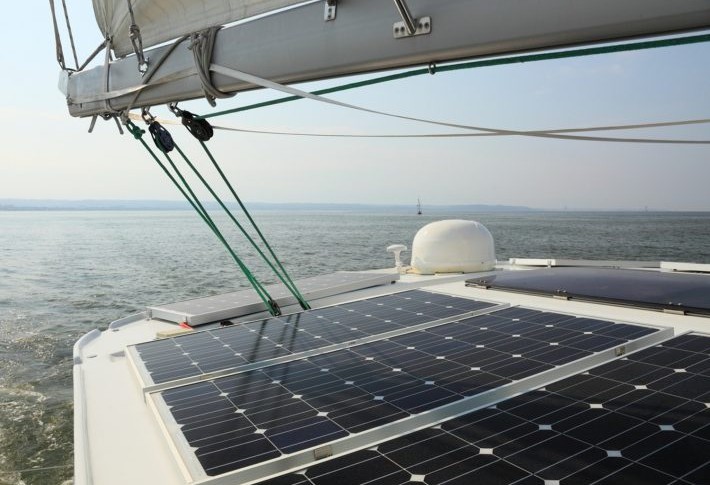
Solar panels are a great way to give your boat energy and power. If you like taking long rides on motorized watercraft, having solar panels can reduce your energy costs. They also make sure that the boat is efficient and never runs out of power in an emergency. There are multiple options for solar panels available, which can make the market search even more confusing. To help you find a suitable pick, we have shortlisted and keenly reviewed our favorite solar panels for boats in 2024.
A top-quality product not only lasts long but also delivers efficient results. This is why it is essential to invest your money in high-end solar panels. All our products are selected based on their overall performance and ability to deliver high-end results.
Our Top Picks
- Best Overall: Renogy Solar Panels for Boats Shop Now ➔
- Most Lightweight Design: Rophie Solar Panels for Boats Shop Now ➔
- Premium Kit: TopSolar Solar Panels for Boats Shop Now ➔
- Best Backup Kit: ECO-WORTHY Solar Panels for Boats Shop Now ➔
- Simple Installation: Sunway Solar Panels for Boats Shop Now ➔
- Premier Foldable Panel: EF ECOFLOW Solar Panels for Boats Shop Now ➔
- 1 What to Consider When Buying Solar Panels?
- 2 Size
- 3 Type
- 4 Accessories
- 5 How Do Solar Panels for Boats Work?
- 6 Installation
- 7 What Are Care Requirements to Enhance the Life of Solar Panels for Boats?
- 9 Cleaning
- 10 What Are the Properties of Charge Controllers for Solar Panels for Boats?
- 11 Basic charge controllers
- 12 Mid-range charge controllers
- 13 Max power charge controllers
- 14 Conclusion
Can solar panels for boats run a trolling boat motor?
How long does it take for a solar panel to charge your boat’s battery, why do people consider installing solar panels for boats, the best solar panels for boats, best overall.
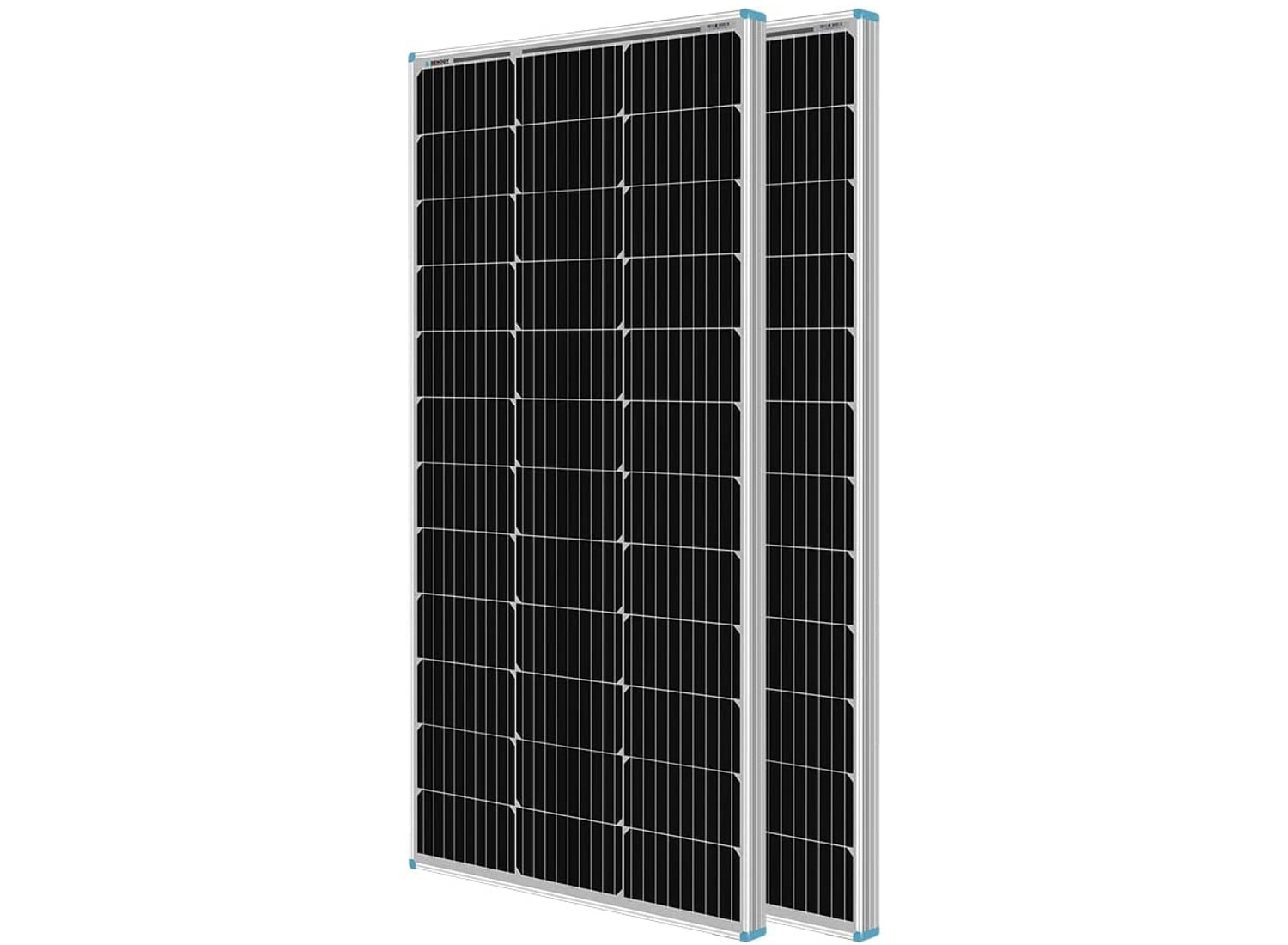
Renogy Solar Panels for Boats
The Renogy are 100W monocrystalline solar panels providing an average of 400-500Wh or 33-41Ah of electricity per day, so you have reliable performance. It has bypass diodes that protect the solar cells from overheating, so you don’t have to worry about maintenance. In addition, it features a corrosion-resistant aluminum train providing extended outdoor use without any extra damage.
These solar panels come with pre-drilled holes on the back so that you can install and mount them without spending money on professional help. They measure 42.2 x 19.6 x 1.38 inches and weigh 14.3 pounds, making them lightweight and convenient. Moreover, you can install them on boats, rooftops, cabins, and more for multifunctional use. Because of their efficiency and reliability, these solar panels stand at the top of our list.
- They are weather-resistant
- These solar panels maintain cell temperature
- Provide reliable performance
- Only compatible with Renogy ground mounts and brackets
Most Lightweight Design
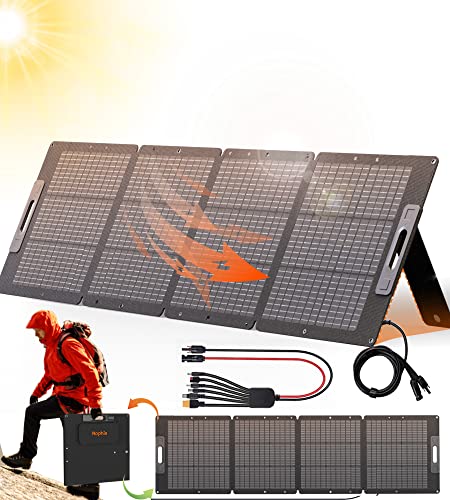
Rophie Solar Panels for Boats
The Rophie Solar Panels easily stands out on this list. Designed with impeccable efficiency, they accelerate solar charging to the next level, making it ideal for outdoor enthusiasts and off-grid boat owners. These solar panels convert sunlight into power rapidly, while their ultra-light, foldable design ensures convenience during transport and installation. Don’t let their light weight fool you, though, as they pack an impressive 200 watts, delivering unmatched power performance for your boat or outdoor camping.
These panels don’t just excel in efficiency and power; they’re also built to endure. Their IP67 waterproof grading ensures that they remain operational even under challenging weather conditions. Their high-quality MC-4 connectors further optimize power transfer while ensuring safe and secure connections. Plus, their compact design won’t take up much space, proving to be the optimal choice for boat owners who value both power and convenience.
- Lightweight and easily transportable
- Durable and water-resistant
- High-performance with 200W
- Can be a little pricey
Premium Kit
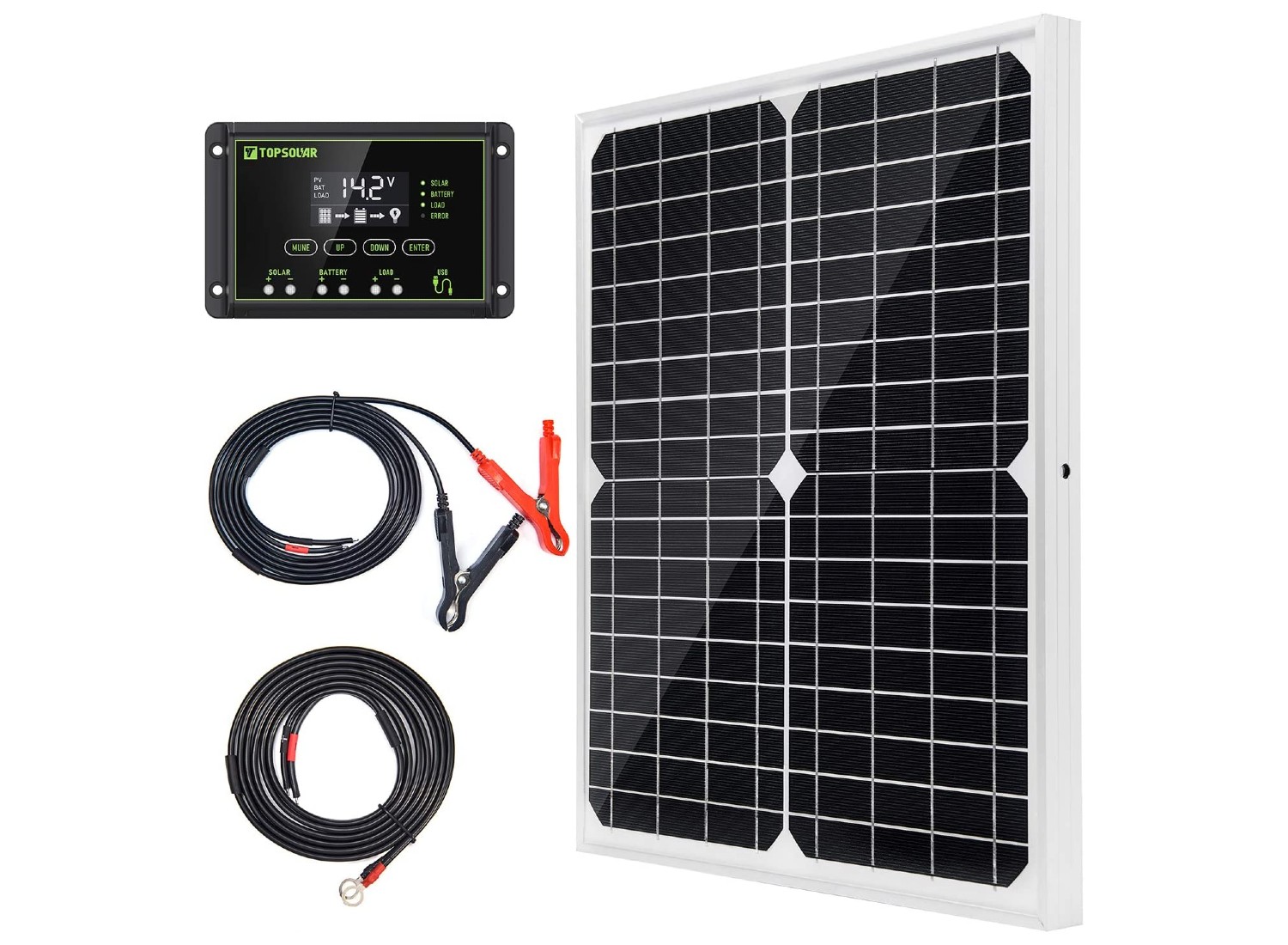
TopSolar Solar Panels for Boats
The TopSolar Solar Panels are available in a kit containing 20W solar panels, a solar charger regulator of 12V/24V, two 6.5-foot cables with alligator clips, and an O-ring terminal to have a complete experience while on the go. They are perfect for off-grid 12-volt battery charging systems providing you with various DC applications like cabins, boats, battery-operated gates, and more. They come with a 10A solar charger controller preventing the battery from overcharging, discharging, and risk of short circuit for a safe experience.
These solar panels have aluminum and tempered glass frames, ensuring a durable and weather-resistant use. Weighing 2.75 pounds and measuring 2.32 x 13.86 x 17.13 inches, they are compact and portable.
- Easy to store and carry
- They come in a complete kit
- Provide excellent weather resistance
- Not suitable for large areas and machinery
Best Backup Kit
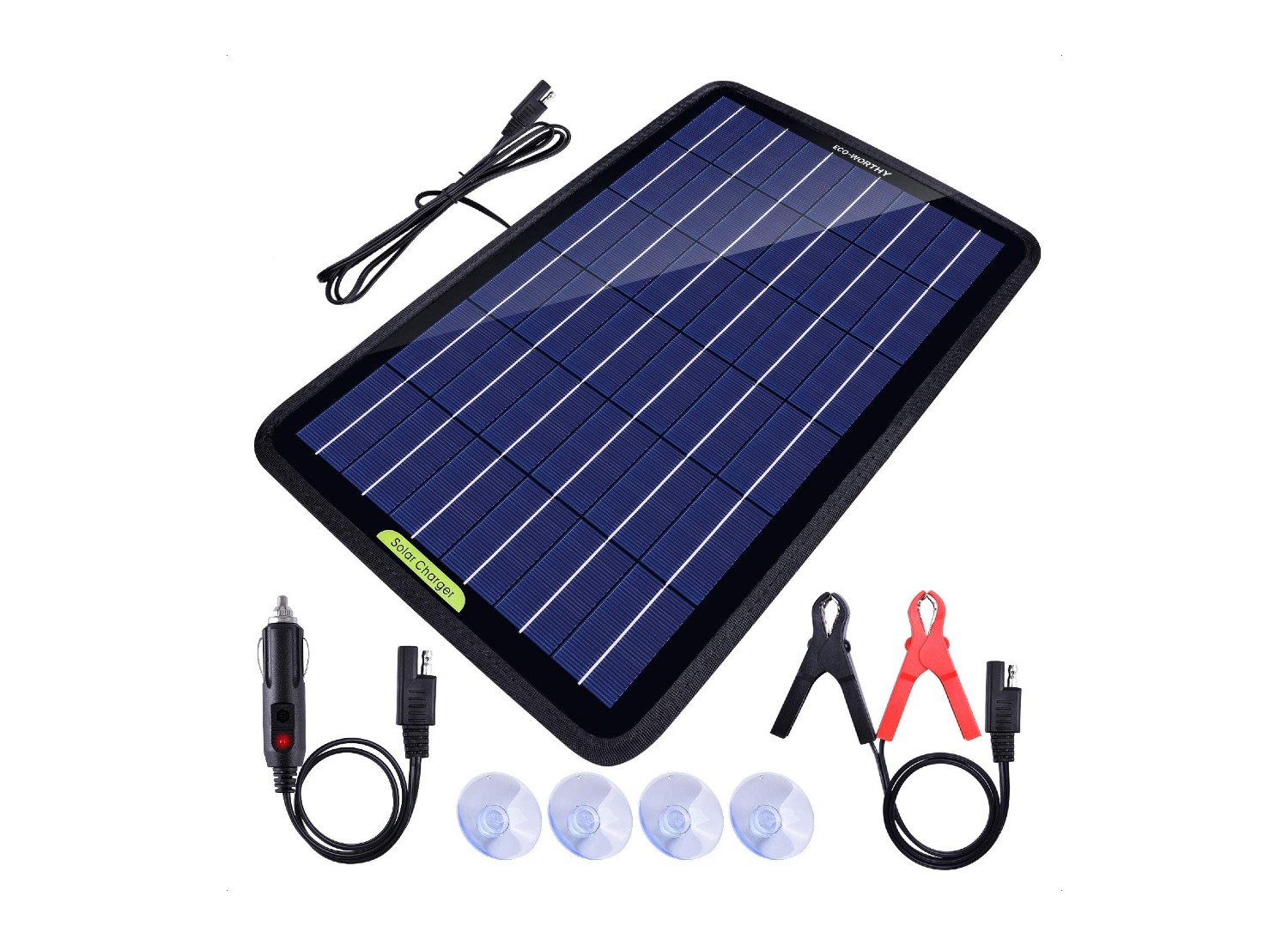
ECO-WORTHY Solar Panels for Boats
The Eco-Worthy Solar Panels are 10W 12V solar car battery chargers that can be used to recharge boats, motorcycles, boats, snowmobiles, and tractors. They feature a cigarette plug option supplying you with constant power when needed. This kit includes a cigarette lighter adapter, one pair of battery clips, and four-piece PVC suckers ensuring maximum results in no time.
They also have energy-saving, built-in blocking diodes that prevent reverse discharge from maintaining and extending battery life for maximum durability. It measures 1.4 x 9.6 x 15.3 inches and weighs only 1.5 pounds, so you have a compact product at hand
- They are available in a complete kit
- These panels are lightweight and compact
- They can recharge different types of vehicles
- Only designed for vehicles
Simple Installation
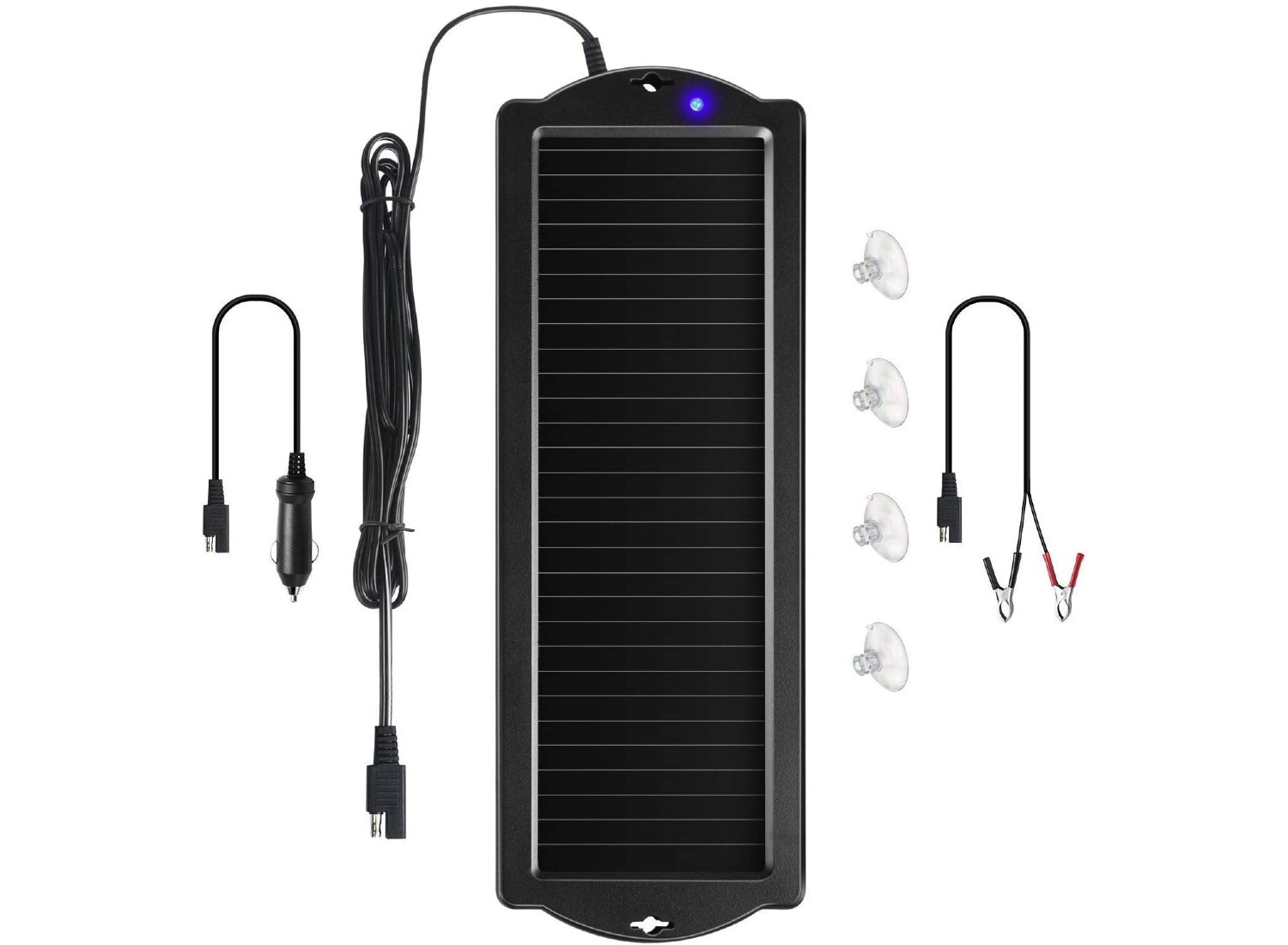
Sunway Solar Panels for Boats
The Sunway Solar Panels are battery charger panel mounts that require a simple installation on any windshield or dash, giving you a quick and convenient experience. They come with 12-volt batteries and a maintainer that protect your panels from overheating and discharging, ensuring safe and convenient use. In addition, these panels are equipped with ultra-clear PC glass, so you have a strong and durable product.
They contain built-in blocking diodes that prevent reverse charging allowing your battery to maintain its useful life. Moreover, they also come with a blinking LED charge indicator that lets you know when the job is done.
- Comes with a battery maintainer
- Do not require professional installation
- Comes with charging indicators
- Suitable to recharge small batteries only
Premier Foldable Panel
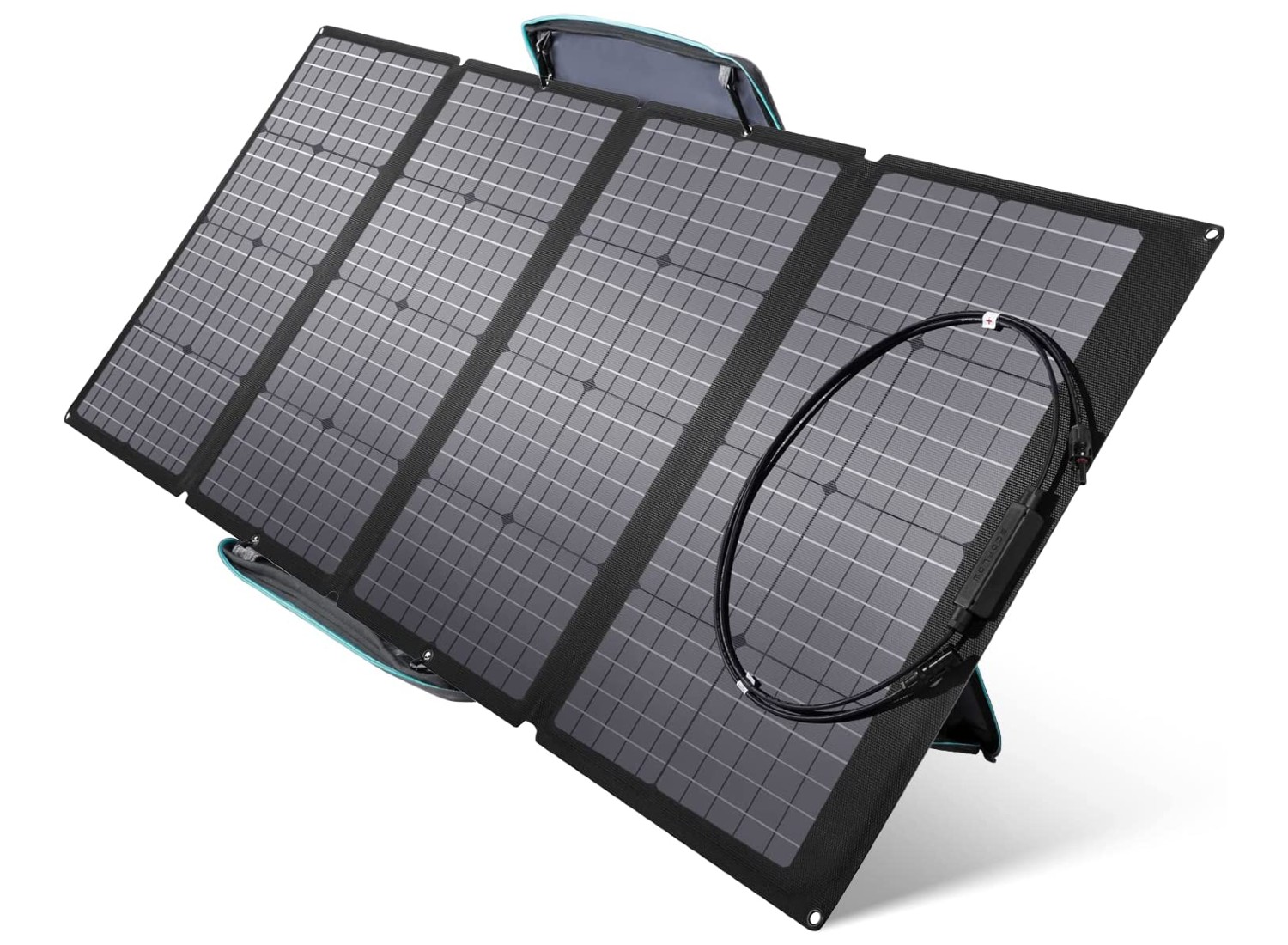
EF ECOFLOW Solar Panels for Boats
The EF Ecoflow provides 160W solar portable and foldable solar panels, delivering a compact and easy-to-carry experience. They are designed to produce maximum power at any time of the day when paired with an EcoFlow power station, so you never run out of electricity. Moreover, they have a seamless one-piece waterproof design, so you can use them during outdoor activities like camping and hiking.
These solar panels are also equipped with protection during transportation, enabling you to carry them without any concerns. Each pack comes with an Ecoflow 160W solar panel, kickstand case, user manual, and warranty card, so you don’t have to make any additional purchases.
- They can be folded for easy storage
- Comes in a complete kit
- Suitable for different outdoor activities
- Can only be paired with an Ecoflow power station
Solar Panels for Boats Buying Guide
We have compiled a detailed buying guide to help you pick a suitable product. It will give you an idea about your requirements for solar panels for boats.
What to Consider When Buying Solar Panels?
Since solar panels are an expensive addition to your asset list, here are a couple of essentials to remember when purchasing.
The size of panels is directly related to the size of your boat. You must get something to match the energy requirements of your boat or greater. A solar panel too small might not power it and leave you frustrated. Other than this, smaller products have less battery time which means they will turn off much quicker than something explicitly designed for the size of your boat.
From PVC to glass covering and fully flexible panels, the type you choose determines their cost. This helps you establish your budget according to your needs. A glass-fronted solar panel is among the most budget-friendly options, but they are not as weather resistant. Besides this, a polycarbonate version is more expensive, but they are incredibly weather resistant and have a longer life.
Accessories
A charge controller or maintainer is an essential component available for your boat’s solar panels. This product protects your panels from battery damage. They prevent any risk of overheating, battery discharge, or sudden drops. A charge controller is essential if you want to elongate the battery’s life. Most brands also offer mount brackets, so you don’t have to purchase them separately.
How Do Solar Panels for Boats Work?
Solar panels for boats work just like any other portable energy provider. To install it successfully, you must have four components: the solar panel itself, charge controller, inverter, and battery. When solar panels in the boat hit sunlight, they convert it into the electrical current, supplying your boat with the required energy.
Boat solar panels can work without a charger maintainer (controller), but there is a risk of overcharging your device. Therefore, you must keep it in place to avoid any risk of battery damage.
The need for an inverter depends on the number of appliances that need a charge. For instance, if you wish to charge multiple devices other than the boat, consider buying a large-capacity product.
You can opt for professional installation if offered by the brand or any other reputed company. But individuals who have the basics can do it all by themselves. However, you must make sure that all the relevant accessories are available at your convenience.
Installation
The installation method is divided into three main stages. The first stage is to conduct an energy assessment. In this, you will determine the level of energy that your boat needs to function. Buy a panel that has a higher voltage than your requirements. This gives more room and flexibility to charge other devices.
Check whether the solar panel can produce that level of energy. Once the capacity is determined, you can decide the exterior of your panels. In most cases, you choose between glass-fronted, polycarbonate, and fully flexible panels.
What Are Care Requirements to Enhance the Life of Solar Panels for Boats?
Caring for solar panels is essential as they are a long-term investment and should last accordingly.
Most solar panels are designed to last two to three decades. Caring for them is fairly simple but requires regular attention. All you have to do is keep them clean from dirt, leaves, and other obstructions. Solar panels from reputable brands always come with a warranty for a couple of years.
Always get a professional repair from the brand in case of any damage. Even if your warranty has expired, we recommend taking your boat’s solar panels to a professional. They might cost a bit more than a local mechanic, but your panels get the treatment they require.
Another factor to consider here is the useful life of your solar panel. This indicates that they will not be as effective as they age. The depreciation in their quality is slow and gradual.
If your product has met the end of its useful life, it won’t stop working but will get more prone to damage. So instead of getting frustrated with why your solar panel for boats isn’t working properly, consider getting a replacement from the same brand or changing your product.
Cleaning
To clean a solar panel, use lukewarm water with a mild, non-acidic detergent and apply water pressure to remove any visible dirt and debris. Panels for boats are relatively smaller, so you won’t need a lot of supply. Clean any unwanted spots with a damp cloth and leave it to dry. Avoid applying water pressure on smaller models as they might not sustain the burden.
What Are the Properties of Charge Controllers for Solar Panels for Boats?
Charge controllers are an essential component. They help protect your panels’ battery from damage. There are three main types of charge controllers available.
Basic charge controllers
They use pulse width modulation to encode transmission information allowing control of the power supplied to boats or other devices. These are simple chargers that come in at an affordable price range. A primary charge controller is designed to control batteries of smaller solar panels. They might not deliver desirable results if connected with a high-capacity panel.
Mid-range charge controllers
These controllers also use pulse width modulation but feature an LCD display to indicate current charging levels. This helps the user keep track of the system and unplug the device when it’s ready to use.
Max power charge controllers
Designed for high-end and powerful solar panels, they are one of the most expensive charge controllers. You should only attach them to devices recommended by the brand itself. They also maximize the performance of panels.
Conclusion
Solar panels are a great way to maximize energy efficiency in your boat and create a durable backup. They are available in different sizes and capacities, so you can find a suitable fit for your boat. This article carefully reviewed the most in-demand solar panels for boats in 2023 that can make a difference in your overall experience. Besides the panel, you should also grab a top-notch charge controller that protects the device from damage and enhances its life.
People Also Asked
Yes, you can run a trolling motor with solar panels, but it is essential to opt for a device that has suitable capacity.
If the panel is according to the desired capacity of the boat, it might take 4 to 6 hours for a full charge.
Solar panels reduce carbon emissions and save money by reducing fuel costs. They also reduce the noise levels caused by a fuel-ignited engine.
Article Contributors
Sail magazine review team.
SAIL Magazine Review Team reports on best-selling products in sailing and boating. The SAIL Magazine editorial staff is not involved in the creation of this content. SAIL Magazine is reader-supported: When you buy through links on our site, we may earn an affiliate commission. The SAIL Review Team is composed of authors, editors, and sailors. Artificial Intelligence (large language models) may have been used in the research and creation of the content.
To ensure questions about product testing or a specific article are addressed, please contact [email protected]

Welcome to the Shop! Purchase your solar panels today and start "sailing with the sun"
We're often asked the question, "How many solar panels do I need?" It's important to size the right solar system for your yacht, but as "roof space" is often limited it may also be a case of maximizing it with solar panels .
This is where Maxeon cell technology excels, with their high efficiency solar cells it means more power in less space!
Based on our time and experience sailing, on short trips and living at sea, we have created a Power Usage Chart below. You can see more details on what each system could power on your weekend or live aboard sailing adventure. Create your own power usage table and see what your power needs are aboard your own yacht then choose the number of solar panels accordingly.
The SunPower E-Flex series of flexible panels includes the 50W & 100W (110W & 170W sold out)
We have Maxeon 415W-R, 470W & 475W frame panels in stock
Expected April/May 2024 - Maxeon Air 330W flexible solar panels (available for pre-order )

Choose Your SunPower® or Maxeon® Solar Panel and Disconnect From the Dock
We offer free shipping in the usa*, * see our shipping policy page for full details. should you want to create a custom bundle or need help sizing a system for say 3 or 4 panels then we can help. just contact us and we will email you a custom price quote., need help placing your order no worries, call us and we can take order details over the phone or email us and we'll send an invoice you can pay online by credit card or paypal..

1x 50 Watt bundle

2x 50 Watt bundle

1x 100 Watt bundle

2x 100 Watt bundle

Maxeon® MAX3-415W-R

1x 415 Watt bundle

2x 415 Watt bundle

Maxeon® MAX3-470W-COM

1x 470 Watt bundle

2x 470 Watt bundle

Maxeon® MAX6-475W-COM

1x 475 Watt bundle

2x 475 Watt bundle

SunPower® A-410W

Maxeon® Air 330W flex

SmartSolar MPPT 75 | 10

SmartSolar MPPT 75 | 15

SmartSolar MPPT 100 | 15

SmartSolar MPPT 100 | 20

SmartSolar MPPT 100 | 30

SmartSolar MPPT 100 | 50

Can You Combine Flexible And Regular Solar Panels?
S olar panels can be lifesavers in days when electricity is becoming a crippling expense; they lower your electricity cost, and are good for the environment. Nowadays, solar panels are becoming more and more common, with even some electric cars being manufactured with solar panel roofs . Granted, solar panels aren't necessarily as simple as plug-and-play, and there are things you need to know before buying and installing solar panels on your home.
That said, with solar panels becoming more accessible to all kinds of people, it's obviously important to be informed before you go ahead and make the decision to make your home solar-powered. There are also many options when it comes to installing solar panels, including different sizes and batteries. In recent years, flexible solar panels have also become more popular, but buyers should be aware of the unique differences and constraints that come with flexible solar panels compared to regular solar panels.
Read more: Battery Brands Ranked From Worst To Best
Flexible Vs. Regular Solar Panels
Flexible solar panels are, well, what the name implies. They are thinner and more lightweight than standard solar panels, which leads to some panels even being as "flexible" as the name suggests — with some ultra-thin panels even as small as stickers . Because of their thin form factor, flexible solar panels can be much cheaper to produce and install than standard ones. This also makes them easier to move from one place to another, which makes flexible solar panels ideal for RVs and boats constantly on the move.
The downside to a flexible solar panel is that they have limited power compared to standard ones. This means flexible solar panels are not best suited to power a home, as the limited power and lower efficiency means you'd need more panels spread out over a much larger area than standard panels. You can certainly combine the two types of solar panels in any configuration as long as your home or site of installation can accommodate both, but that will depend on the efficiency you require from both panels. Using both types of panels will also largely depend on why you might need both affixed and flexible solar panels in the first place, versus just using standard panels entirely.
What kind of panel suits you best depends on what exactly you want it for. If you want a more permanent solution to help offset the cost of powering your home, you may want to stick with traditional panels. If you value mobility and a thin form factor for whatever scenario, then flexible panels are worth looking into.
Read the original article on SlashGear


FREE Shipping & 11 Year Warranty
- CUSTOM / WHOLESALE / B2B
- We Are Dakota Lithium
- Affiliate Program
- Contact & FAQ
- 1-855-743-3279
- Trolling Motor Batteries
- RV, Vans & Camper Batteries
- Marine & Boat Batteries
- Golf Cart Batteries
- Fish Finder Batteries
- Starter & Automotive Batteries
- Ice Fishing Batteries
- 12v Batteries
- 24V Batteries
- 36V Batteries
- 48V Batteries
- 72 Volt Lithium Batteries
- Off-Grid Power Systems
- Power Box & Mobile Power
- Ham Radio Batteries
- Mobility Scooter & Wheelchair
- Inverters & Monitors
- Wiring Kits
- Solar Panels
- Battery Trays
- Apparel & Decals
- 12V Batteries
- Powerbox Solar Generators
- RV, Vans, & Camper Batteries
- Ham Radio & UPS
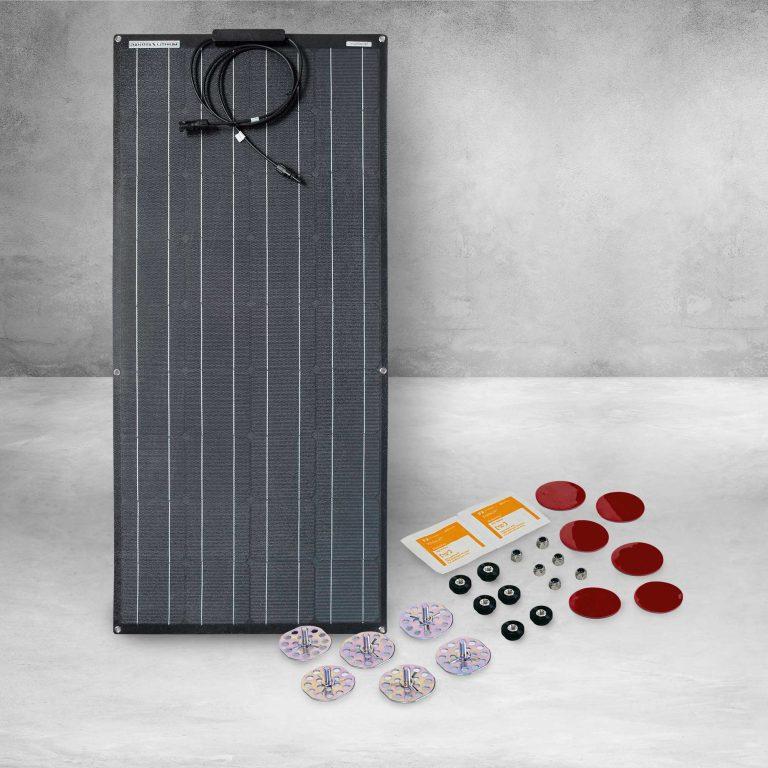
Dakota Lithium 100-Watt Flexible Marine Solar Panel Kit
Live a life without limits! For unlimited freedom, take your boat, RV, truck, or trailer off-the-grid with Dakota Lithium. This kit offers enough power to charge most single 12-volt battery banks (combine 100 watts of solar with 100Ah of Dakota Lithium batteries – additional panels recommended for colder climates, faster charge time, or winter activities). Designed for decades of rugged use in extreme conditions, this flexible, marine grade solar panel is waterproof, flexible for curved roofs and boat decks, and is backed up by a 25 year output warranty. Universal installation hardware included.
100-Watt Dakota Lithium Solar Kit Includes:
100-Watt Dakota Lithium Solar Panel
Quick-connect solar plug
Stainless steel mounting hardware and double sided industrial welding tape. Easy installation on most surfaces.
Please note: A lithium compatible solar charge controller is recommended for connecting solar panels to 12V Dakota Lithium batteries. Choose either the Solar Integration Kit & DL Dashboard Bluetooth Battery Monitor, or the Victron SmartSolar MPPT 75/15 Solar Charge Controller . Both are rated at 15 Amps and can support up to 300 watts of solar (3 x 100 watt panels).
See our solar panel size chart for what and battery combination is appropriate to your needs.
- Free Shipping to Lower 48
- 25 year warranty
- Free mounting hardware
$ 599 $ 399
Live a life without limits! Take your boat, RV, truck, or trailer off-the-grid with Dakota Lithium. This kit offers enough power to charge a single 100Ah battery. Designed for decades of rugged use in extreme conditions, this flexible, marine grade solar panel is waterproof, flexible for curved roofs and boat decks, and is backed up by a 25 year output warranty.
Available on backorder
Specifications
100 Watts power output
5.56 amps peak power generation. Latitude and season will impact solar panel output. If you spend a lot of time winter camping in northern latitudes you may want to think about adding an additional panel
18 Volts (V). Can be connected directly to the battery for simple and smaller systems. A solar charge controller is highly recommended since it lowers the voltage to 14.4V and greatly increases the efficiency of the system.
Installation is a breeze with the pre-assembled mounting hardware and wiring. Add a DL Dashboard integration kit for a solar charge controller, battery monitor, and additional wiring harness.
Dakota Lithium's innovative mounting hardware lets you to mount the panels wherever you need them, and the stainless steel mounting hardware ensure your panels won’t budge in route—no matter how far off-road you go. Additional double sided industrial welding tape is included as an alternative to using the hardware, and may be preferable on curved surfaces like boat decks or airstream trailers.
Semi-flexible, marine grade solar panel on a ruggedized waterproof backing. Optimal for rooftops and boat decks. Not designed for walking on. Foot traffic will reduce the lifespan and warranty of the panel.
Divide the Ah (capacity) of your battery by 5 to determine how many hours to charge your battery.
3 ft wire harness with waterproof MC4 connectors.
47.25 in (1200.15 mm) x 21.25 in (539.75 mm) x 0.1 in (3 mm) per panel
25 year power output warranty, meaning the panels are guaranteed to generate power for 25 years.
IP67 Marine grade waterproof rating for use on boats, RVs, and rooftops in the rain
Suitable for:
- RV Camping & Boondocking
- #VanLife, Truck, Overland, Trailers
- Boats & Marine Applications
- Tiny Homes and Off-the-Grid Cabins
- 100 watts charges 50Ah to 100Ah of Dakota Lithium batteries
- Add additional panels for larger systems
- Living off the grid
OTHER BATTERIES AND PRODUCTS
Dakota lithium #vanlife, rv trailer & truck 12v 100ah power system, dakota lithium & zamp solar 12v 200ah off-grid power system.
The product itself is of great quality. It is boxed well and comes with all you need. I would recommend it over “less expensive ” and lesser quality items of similar type.
For more information or larger quantity inquiries, visit our B2B page or please call our sales team at 1-855-743-3279.
Be The First to Know
- Shop Batteries
- Custom / Wholesale / B2B
- Lithium Battery Chargers
- News, Blog, & Events
- Certifications & Safety
- Best in Class Warranty
- About Dakota Lithium
- Battery Charging Guide
- Customer Service / FAQ
- Battery Collection
- In the Press
- Warranty / Returns
- Find A Dealer
- Become A Dealer
- Meet Our Athletes
- Privacy Policy
- Our Most Popular
- Starter & Cranking Batteries
- RV & Camper Lithium Batteries
- Marine & Sailboat Batteries
Dakota Lithium 225 S Lucile St Seattle, WA 98108
1-855-743-3279.
Thank you for visiting nature.com. You are using a browser version with limited support for CSS. To obtain the best experience, we recommend you use a more up to date browser (or turn off compatibility mode in Internet Explorer). In the meantime, to ensure continued support, we are displaying the site without styles and JavaScript.
- View all journals
- My Account Login
- Explore content
- About the journal
- Publish with us
- Sign up for alerts
- Open access
- Published: 12 March 2024
High-performance bifacial perovskite solar cells enabled by single-walled carbon nanotubes
- Jing Zhang 1 na1 ,
- Xian-Gang Hu ORCID: orcid.org/0000-0002-4944-7634 2 , 3 na1 ,
- Kangyu Ji ORCID: orcid.org/0000-0002-1278-3212 4 ,
- Songru Zhao 5 ,
- Dongtao Liu 1 ,
- Bowei Li 1 ,
- Peng-Xiang Hou ORCID: orcid.org/0000-0002-7585-513X 2 ,
- Chang Liu ORCID: orcid.org/0000-0003-3016-3997 2 ,
- Lirong Liu 5 ,
- Samuel D. Stranks ORCID: orcid.org/0000-0002-8303-7292 4 , 6 ,
- Hui-Ming Cheng ORCID: orcid.org/0000-0002-5387-4241 1 , 2 , 7 , 8 ,
- S. Ravi P. Silva ORCID: orcid.org/0000-0002-0356-1319 1 , 9 &
- Wei Zhang ORCID: orcid.org/0000-0002-2678-8372 1 , 9
Nature Communications volume 15 , Article number: 2245 ( 2024 ) Cite this article
5077 Accesses
88 Altmetric
Metrics details
- Electronic devices
- Solar energy
Bifacial perovskite solar cells have shown great promise for increasing power output by capturing light from both sides. However, the suboptimal optical transmittance of back metal electrodes together with the complex fabrication process associated with front transparent conducting oxides have hindered the development of efficient bifacial PSCs. Here, we present a novel approach for bifacial perovskite devices using single-walled carbon nanotubes as both front and back electrodes. single-walled carbon nanotubes offer high transparency, conductivity, and stability, enabling bifacial PSCs with a bifaciality factor of over 98% and a power generation density of over 36%. We also fabricate flexible, all-carbon-electrode-based devices with a high power-per-weight value of 73.75 W g −1 and excellent mechanical durability. Furthermore, we show that our bifacial devices have a much lower material cost than conventional monofacial PSCs. Our work demonstrates the potential of SWCNT electrodes for efficient, stable, and low-cost bifacial perovskite photovoltaics.
Similar content being viewed by others

Efficiency boost of bifacial Cu(In,Ga)Se2 thin-film solar cells for flexible and tandem applications with silver-assisted low-temperature process
Shih-Chi Yang, Tzu-Ying Lin, … Romain Carron

Flexible all-perovskite tandem solar cells approaching 25% efficiency with molecule-bridged hole-selective contact
Ludong Li, Yurui Wang, … Hairen Tan
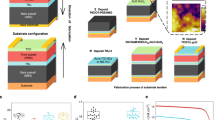
Oxidation-resistant all-perovskite tandem solar cells in substrate configuration
Yurui Wang, Renxing Lin, … Hairen Tan
Introduction
Electricity is the most versatile and widely used form of energy in the world, and it is essential for decarbonization. Solar energy has the potential to supply abundant and affordable energy for various applications. To decarbonize the world, we need cheap and sustainable ways to generate electricity from solar power, which is abundant but underutilized 1 . Solar photovoltaic (PV) systems have grown rapidly in the past decade and are expected to continue to expand 2 . Over 60% of all current new energy world provision depends on solar energy. To achieve sustainable PV manufacture and deployment at gigawatt and terawatt scales, we need to lower the levelized cost of electricity (LCOE) of all existing and emerging PV technologies. The current pace of cost reduction is not sufficient for this aim. For instance, previous reports state the LCOE of commercial silicon solar cells is about 7 US cents per kWh and that of perovskite solar cells is about 5 US cents per kWh, whereas the average electricity price in the UK at present is around 34p per kWh (April 2023) 3 , 4 . Therefore, it is critical to further increase the power output per unit area of solar devices at low extra costs to accelerate the deployment of PVs. Bifacial PVs have the potential to harvest direct and diffuse sunlight from both front and back sides, leading to increased power output compared to monofacial PVs 3 . One advantage of bifacial PV technology is its independence from the angle of incident light (Fig. S1a, b, c ) 5 . Previous studies have demonstrated that albedo energy, which is reflected from surrounding surfaces such as concrete or grassland, accounts for more than 20% of the standard AM 1.5 G irradiance (Fig. S1d–k ). Related simulations and calculations have presented that the energy output of a bifacial PV module can be up to 30% higher than that of its monofacial counterparts 6 . Thus, bifacial PV modules have the advantage of being adaptable to any installation angle, and hence reduce the installation cost compared to monofacial PV modules which typically require costly solar trackers 7 . In this regard, bifacial PVs could offer a promising approach for further reducing the LCOE of PVs.
Bifacial PV devices can harvest albedo energy from the environment, which is measured by a “bifaciality factor (%, BiFi)”, the ratio of their back- and front-side power conversion efficiency (PCE) under standard illumination conditions ranging from 0 to 1 3 . For instance, a BiFi of 80% implies that the back side can generate 80% of the power that the front side can produce. A higher BiFi means a higher utilization of the back side irradiance and a higher overall power output 8 . In the current bifacial PV market, crystalline silicon solar cells (c-Si) are dominant 9 , 10 , 11 . c-Si PVs have achieved modest-to-high BiFi (0.75–0.95) and high PCEs (over 24% for bifacial Si-cells), leading to their dominance in the market 11 , 12 . A notable example is the c-Si heterojunction with an intrinsic thin layer (HIT) solar cell, which has a BiFi of 93% and a PCE of 24.7% 13 . Other types of PVs, such as cadmium telluride (CdTe), copper indium gallium selenide, organic PVs and dye-sensitized solar cells, have received limited attention for bifacial applications 12 . The major reason is their comparatively low BiFi (e.g., the BiFi for CdTe is 15%) compared to c-Si PVs 14 .
Fortunately, PSCs possess several physical parameters that make them suitable for bifacial PV applications. Previous studies have demonstrated that PSCs can achieve a high BiFi of ~94% (monofacial PCE is ~14%) 12 . We note that a record PCE of over 26% for single-junction mono-facial PSCs has been achieved 15 , 16 , positioning them as a potential candidate for efficient bifacial devices. Furthermore, PSCs have an advantage over silicon solar cells under low-intensity light conditions 17 , as they exhibit higher open-circuit voltage and lower voltage loss. This allows them to utilize the albedo energy more effectively.
For optimal bifacial applications, both front and back electrodes should be optically transparent, chemically stable, and compatible with the adjacent layers. Transparent conducting oxides (TCOs), such as indium tin oxide (ITO) and fluorine-doped tin oxide (FTO), are widely used for both front and back electrodes in bifacial PSCs. TCOs are not only highly conductive and transparent, but also resistant to halide corrosion and ion diffusion, enhancing the stability of bifacial PSCs 18 . For instance, a recent work reported that using FTO and indium zinc oxide (IZO) as front and back electrodes in bifacial PSCs resulted in an excellent performance of ~22% 19 . Besides, ITOs were employed as both front and back electrodes in minimodules and realized a great efficiency of 20.2% with an aperture area of 21.7 cm 2 20 . However, ITO and FTO as the front electrode TCOs suffer from brittleness which significantly restricts their application in flexible and foldable devices. Moreover, the fabrication of TCOs as back electrodes is challenging because the high temperature and plasma effects during deposition can damage the underlying perovskite layers 21 . Several solutions have been proposed to mitigate the damage caused by ITO or FTO deposition, including inserting a buffer layer on top of a perovskite layer or using damage-free sputtering approaches 22 , 23 , 24 . These methods increase complexity, the number of required layers of devices.
Other materials such as conductive polymers, metal grids, metal nanowires and carbon-based materials have also been proposed as alternatives to back electrodes in PSCs 25 , 26 , 27 , 28 . Among these materials, the integration of carbon nanotubes (CNTs) into perovskite-based devices stands out owing to the exceptional electrical conductivity, stability, and mechanical flexibility of CNTs 26 , 29 , 30 , 31 , 32 , 33 . These properties make them promising candidates for thermo-mechanical stable and flexible PSCs. Previously, graphene was used as the back electrode of PSCs and the resulted in devices with an efficiency of 18.6% (monofacial efficiency) with enhanced stability against heat and moisture 34 . CNTs have been also used as the front electrodes of flexible PSCs and enhanced their bendability and environmental stability 26 . These examples showcase the remarkable compatibility between carbon materials and PSCs, enabling them to function effectively as either front or back electrodes. In the past, carbon materials faced some challenges in bifacial PSCs. One limitation has been the comparatively low conductivity of thin and transparent carbon materials, which contributes to electrical losses within the devices. This issue is particularly prominent when considering their implementation as front electrodes. Another challenge includes their fabrication methods (e.g., water-soluble process) 35 , which may complicate the requirements of the back electrode application or flexible device 35 , 36 .
Here, we demonstrate the fabrication of bifacial PSCs using highly transparent and conductive single-walled carbon nanotubes (SWCNTs) as both front and back electrodes without integrating with other materials. We investigate the interactions between SWCNTs and electron/hole transport materials (ETM/HTM) and their effects on the device performance. These resulting bifacial PSCs achieve an ultra-high power generation density (PGD) of over 36 mW cm −2 . We adopt the BiFi notation to denote the corresponding PGD in a scientific and simple manner. For instance, a PGD of 25 mW cm −2 BiFi 200 implies that the device produces 25 mW per cm 2 under simultaneous irradiance of 1-sun (1000 W m −2 ) at the front and 0.2-sun (200 W m −2 , denoted as BiFi 200 ) at the back 37 . We further evaluated the photovoltaic performance of these bifacial PSCs under various common environments with different albedo factors and the resultant PGD range from 16.75 mW cm −2 (tiles, BiFi 120 ) to 36.21 mW cm −2 (snow, BiFi 960 ). Due to the excellent environmental durability of SWCNTs, these bifacial PSCs exhibit remarkable stability against moisture, light and heat conditions. We also simulated the power generation of these bifacial PSCs for the next 25 years. Moreover, SWCNTs are flexible and mechanically robust, which enables them to withstand repeated bending cycles. These features make SWCNTs suitable for flexible PSCs and enable new visions for the development of bifacial PSCs.
Results and discussion
Optoelectrical characterizations of swcnt films.
The SWCNT films were prepared using an injection floating catalyst chemical vapor deposition (FCCVD) method 38 . By controlling the collection time, SWCNT films of different thicknesses were obtained 38 . The preparation process is described in the Methods . The entangled SWCNT film with small bundles was observed using scanning electron microscopy (SEM) and transmission electron microscopy (TEM) (Fig. 1a, b ). The mean diameter of each tube was determined to be ~2.2 nm (Fig. S2 ). The optical characteristics of the SWCNT films were investigated, revealing an impressive optical transmittance of ~95% at a wavelength of 550 nm (Fig. 1c ). Notably, the optical transmittance in the visible wavelength range exceeds that of commercial ITO substrates, enabling the sufficient transmission of sunlight to perovskite absorbers. Unlike ITO, which shows a decrease in transmittance in the long wavelength region (>1000 nm), the SWCNT films preserve their transparency across these regions (Fig. 1c ). This exceptional optical property renders the SWCNT films highly suitable as front electrodes for optoelectronic applications that encompass a broad spectrum of wavelengths. However, the sheet resistance of the SWCNT film with 95% optical transmittance (at 550 nm wavelength, denote as SWCNT@95%, ~138 Ω sq −1 ) was higher than that of the commercial indium tin oxide (ITO, ~15 Ω sq −1 , Fig. 1d ). To balance the sheet resistance and optical transmittance, we increased the thickness of SWCNTs and prepared SWCNT@90%, SWCNT@85% and SWCNT@75% films (~8 nm for SWCNT@95%, ~15 nm for SWCNT@90%, ~21 nm for SWCNT@85% and ~28 nm for SWCNT@75%) 39 , and we found that the SWCNT@75% film has a sheet resistance comparable to that of the ITO film. We also compared the figure of merit values of these SWCNTs and found that the SWCNT@85% film presents the highest value (7.03*10 −3 ) among these SWCNTs (Table S1 ), which is even slightly higher than of ITO (5.07*10 −3 ) 40 , 41 . The quality of the SWCNT films was then studied through Raman spectroscopy. A high-intensity ratio of G to D bands ( I G / I D = 162) indicated high crystalline quality and low defect density, which facilitates the transportation of collected charges (Fig. 1e ) 42 , 43 . To investigate the electrical properties of these SWCNT films further, we performed optical absorbance spectroscopy and observed the first and second semiconducting transitions of the van Hove singularities ( E S 11 and E S 22 ), as well as the first metallic transition of the van Hove singularity ( E M 11 ) (Fig. S3 ). Typically, the SWCNT films prepared by a FCCVD method exhibit 1/3 metallic and 2/3 semiconducting characteristics 44 . The work function of the electrode is a key factor in enabling a high built-in voltage 45 . Therefore, the work function of SWCNT film was determined using ultraviolet photoelectron spectroscopy. The results indicate that the calculated work function of the SWCNT film is about −4.70 eV (Fig. S4 ). We note that the work function of the SWCNT film, which is comparable to that of ITO, remains constant at approximately −4.70 eV) regardless of its optical transmittance 46 , 47 , 48 . Overall, this finding suggests that SWCNTs could be a viable alternative to ITO in terms of work function, sheet resistance and optical transmittance.
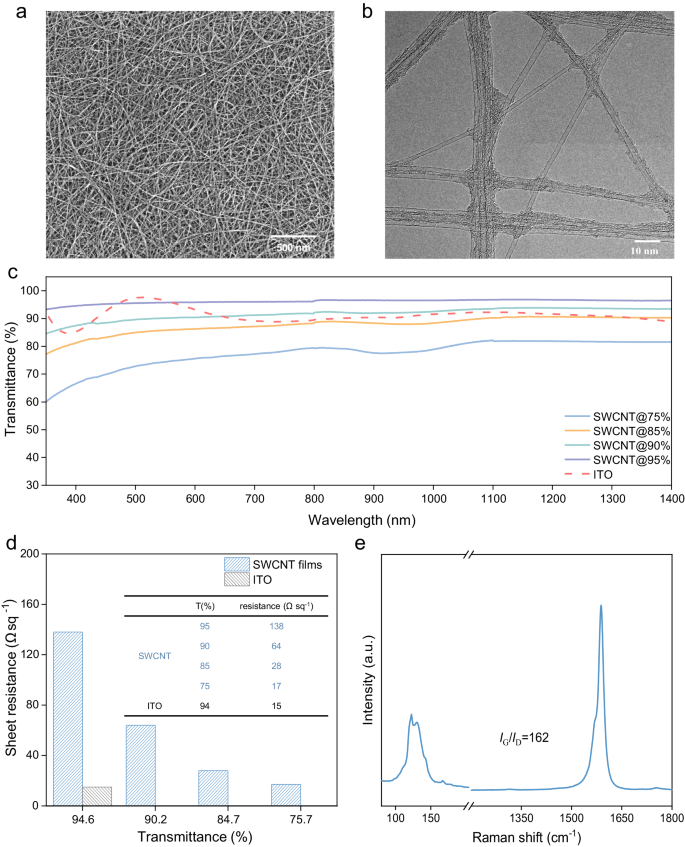
a SEM image of the SWCNT film (scale bar = 500 nm). b TEM graph of a SWCNT film, and the average diameter of the individual tube is ~2.5 nm (scale bar = 10 nm). c Optical transmittances of the SWCNT films with various thicknesses. d Sheet resistances of SWCNT films. e Raman spectrum of the SWCNT film, and the high I G / I D ratio is illustrated.
Interactions between SWCNTs and charge transport materials
Here, we used phenyl-C61-butyric acid methyl ester (PCBM) and SnO 2 as the ETM. This combination can not only reduce the charge recombination at the perovskite/ETM interface, but also offer better electron mobility than a single SnO 2 or single PCBM 49 . The exterior layer that directly contacts the SWCNT film is PCBM, so we investigated the interaction between PCBM and SWCNTs here. The intimate contact between SWCNTs and PCBM was directly observed through TEM. The TEM analysis, as depicted in Fig. S5 , along with the Fourier transform infrared spectroscopy data in Fig. S6 , confirms the close interaction between SWCNTs and PCBM 39 , 50 , 51 . Raman spectra further revealed that the addition of PCBM to a SWCNT film slightly shifts the G band to lower wavenumbers, indicating an n-type doping behavior of PCBM on SWCNTs (Fig. S7 ) 52 , 53 . This conclusion contradicts some previous studies in which it was claimed that PCBM extracts electrons from the SWCNT films 54 , 55 . However, the previous studies focused solely on the interaction between PCBM and semiconducting SWCNTs, and did not consider the effect of PCBM on mixed SWCNTs, which are used in this work. In contrast to pure semiconducting or metallic SWCNTs, a mixed SWCNT film offers the advantage of harnessing the exceptional charge extraction capability of semiconducting SWCNTs, combined with the high conductivity provided by metallic SWCNTs. This unique combination ensures the efficient separation of electron-hole pairs and facilitates effective charge transport at the interface 56 . To further investigate the impact of PCBM on mixed SWCNTs, UV–vis spectra of SWCNT and PCBM-SWCNT were then analyzed. The results reveal a blue shift of the characteristic peak of SWCNTs, indicating strong π–π stacking interactions between PCBM and the SWCNT films (Fig. S8 ) 57 . And the work function of the SWCNT film decreased from ~4.70 eV to ~4.55 eV (Fig. S9 ). Moreover, the resistance of the SWCNT film reduced from 28.8 Ω to 21.9 Ω upon contact with PCBM, presumably owing to the formation of π–π bonds between PCBM and SWCNTs, which facilitated electron transport (Fig. S10 ) 50 , 58 .
We subsequently studied the hole collection ability of SWCNT films. Here, copper-doped nickel oxide (Cu:NiO x ) was used as a hole transport material (HTM) due to its suitable work function (−5.3 eV), high hole mobility (1.09 × 10 −2 cm 2 V −1 s −1 ), and simple fabrication protocols 26 , 59 . As revealed by previous studies, Cu:NiO x nanoparticles can optimize the morphology of the SWCNT films, while organic HTMs (e.g., PTAA) are too thin to compensate the rough surface of SWCNT films 26 .
We then investigated the capability of extracting and transporting electrons within perovskite solar cells (PSCs) with SWCNT films (the ability to extract and transport holes for SWCNTs has been investigated in our previous work) 26 , semi-devices with a configuration of glass/perovskite/SnO 2 /PCBM/SWCNT (with various optical transmittances, 95%, 90%, 85% and 75%) were prepared, and steady-state photoluminescence (PL) and corresponding time-resolved photoluminescence (TRPL) were then conducted. Compared to the bare perovskite thin film, the PL intensity showed a significant reduction for all SWCNT-based semi-devices (Fig. 2a , the inset picture shows the configuration of the semi-device), demonstrating similar electron extracting capability of ETM/SWCNT stacks with slight variation for semi-devices based on SWCNT films with different optical transmittances. To quantify this variation among devices, TRPL data were illustrated and calculated (Fig. 2b ). As a result, the decay time decreased from 11.39 ns to 4.61 ns as the optical transmittance of SWCNT films reduced from 95% to 75%, whereas the values were 9.63 ns and 6.72 ns for semi-devices with SWCNT@90% and SWCNT@85% respectively 60 . In conjunction with the PGD of resultant devices (Table S3 ), this indicated that thick SWCNT films could collect charges more efficiently than their thinner counterparts 37 , 61 . In addition to the difference in conductivity of these SWCNT films, it is plausible that the compactness of the contact between PCBM and thick SWCNT films may contribute to the observed reduction in carrier lifetime 62 , which is consistent with the PL data. To further investigate the influence of the SWCNT films on charge transport behavior, carrier lifetime mapping was performed by comparing the lifetime of charges in areas with and without a SWCNT film. The transfer process of the SWCNT films can be found in Fig. S11 . The half-stack device configuration (glass/perovskite/SnO 2 /PCBM/with and without SWCNT@85%) is illustrated in Fig. S12 , and the PL mapping results reveal that the average lifetime of carriers is reduced from 1.44 ns (blue box, 6 µm × 6 µm) for glass/perovskite/SnO 2 /PCBM to 0.94 ns (orange box, 6 µm × 6 µm) for glass/perovskite/SnO 2 /PCBM/SWCNT@85% (Fig. 2c ). This difference in lifetime provides evidence that the carriers in the perovskite/ETM/SWCNT stack travel more quickly than those in the perovskite/ETM stack, suggesting that additional electron pathways may be formed at the PCBM/SWCNT interface, which leads to the observed reduction in lifetime.
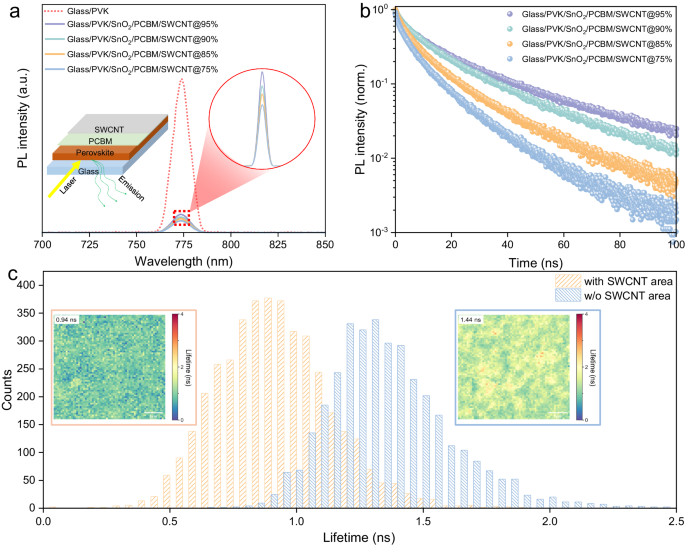
a Steady-state PL of semi-devices with various SWCNT films. b Corresponding TRPL curves of semi-devices with SWCNT films in different thicknesses. c Charge lifetime statics of areas with and without SWCNTs (the fluence power is 0.4 µJ cm −2 ), and the inset pictures are charge lifetime mapping of areas with and without SWCNT films (the size of the area is 6 µm × 6 µm), with average lifetime marked on the top left.
Characterizations of all-carbon-electrode-based bifacial PSCs
We then fabricated bifacial p-i-n devices using an glass/SWCNT@85%/Cu:NiO x /Perovskite/SnO 2 /PCBM/SWCNT architecture and measured their corresponding performances using eight common ground reflection materials under AM 1.5 G incidence. The choice of SWCNT@85% as the front electrode was due to its balanced conductivity and optical transmittance 26 . The reflection spectra and albedo factor of the eight materials can be found in Fig. S13 and Fig. S14 . We then summarized the performances of these all-carbon-based bifacial PSCs under various situations in Fig. 3a and Table S2 . It can be seen that PSCs with a back electrode of SWCNT@75% exhibit the highest PGD when illuminated from the front side under 1 sun (19.14%, PGDs of other devices can be found in Tables S3 ). When considering albedo energy, bifacial devices equipped with SWCNT@85% as both front and back electrodes (denoted as double-sided SWCNT@85% devices) deliver the highest efficiencies among all four structures under high albedo conditions (albedo > 20%), whereas monofacial PSCs do not efficiently utilize this albedo energy (the photovoltaic parameters of a monofacial PSC illuminated from the metal-electrode side are shown in Fig. S15 ). The remarkable PGD in the double-sided SWCNT@85% PSC can be attributed to its exceptional BiFi. Among recently reported efficient bifacial PSCs, the double-sided SWCNT@85% device exhibits the highest BiFi, reaching an impressive value of 98.27% (Table S4 ), while the BiFi for devices incorporating back electrodes of SWCNT@95%, SWCNT@90%, and SWCNT@75% were measured to be 93.36%, 94.25%, and 74.24%, respectively.
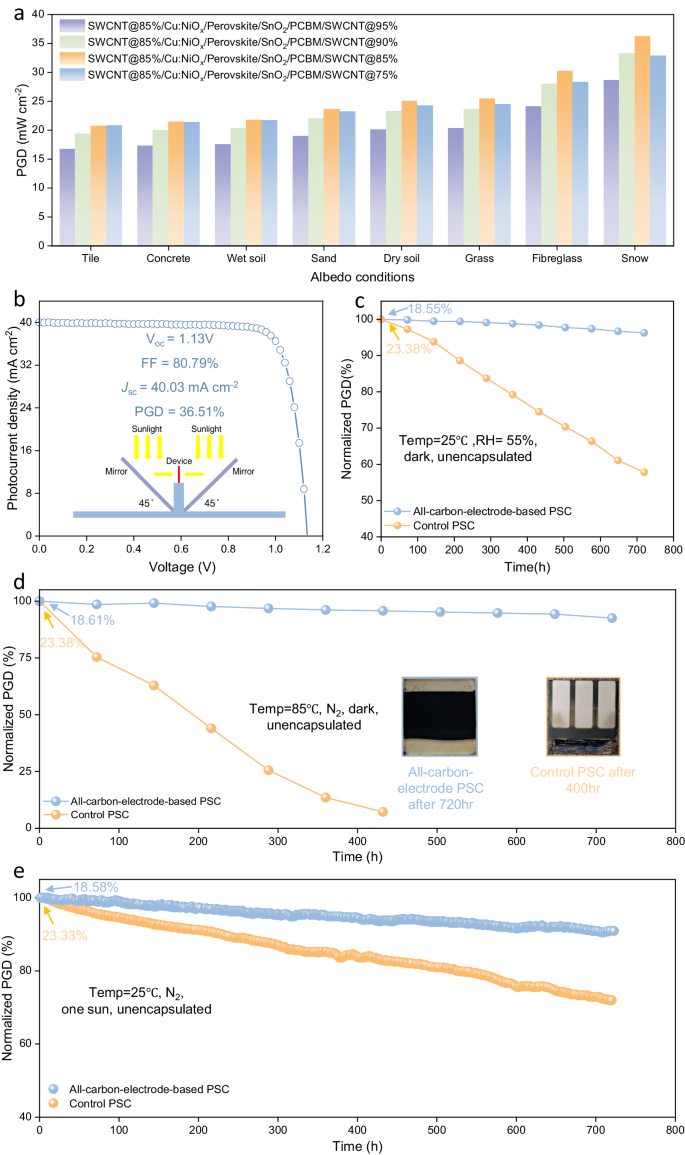
a PGD chart of bifacial PSCs under various albedo conditions. b J -V curves of an all-carbon-electrode-based PSC illuminated from the front side (100 mW cm −2 ) and back side (100 mW cm −2 ) simultaneously, and the inset picture depicts the characterization setup described in IEC TS 60904-1−2: double light source method. c Shelf storage stability records of an all-carbon-electrode-based PSC and control device under 25 °C and a relative humidity of 55% (dark, unencapsulated). d The thermal stability performance of all-carbon-electrode-based PSCs and their control counterparts were evaluated under sustained exposure to 85 °C in an N 2 -filled glove box, and inset pictures show that the control PSC becomes yellowish after 400 h (with orange border) whereas the all-carbon-electrode-based PSC is still black (with blue border). e Maximum power point (MPP) tracking of an all-carbon-electrode-based PSC and control device under N 2 atmosphere, 1 sun continuous illumination without UV filter. (Temperature = 25 °C).
To further confirm the reliability of short-current density ( J sc ) data, we collected external quantum efficiency (EQE) spectra for the devices with different SWCNT films (refer to Fig. S16 ), and these values are in agreement with the trend for J sc shown in Table S4 . Moreover, the performance of the bifacial PSCs was assessed using double light source protocols (refer to Fig. 3b ), as outlined in the International Electrotechnical Commission Technical Specification 60904-1-2 11 , 31 . The setup of the test is presented in the inset of Fig. 3b , where the device receives continuous AM 1.5 G one sun illumination from both the front and back sides simultaneously, enabled by the mirror design. As a result, the double-sided SWCNT@85% device exhibits an impressive J sc of ~40 mA cm −2 , resulting in an equivalent PGD reaching 36.51 mW cm −2 BiFi 1000 , suggesting the potential of bifacial PSCs to enhance equivalent bifacial-PGD (18.54% and 18.22% for frontside and backside) performance by utilizing surrounding reflected irradiance. In contrast, under the same condition, the opaque control cell has a bifacial PGD of 23.63 mW cm −2 BiF i1000 , which is only ~0.3% higher than that of one-side illumination (23.38%, Fig. S17 ). To directly ascertain the degradation processes occurring in perovskite films, we conducted long-term stability tests on these devices without encapsulation under ~55% relative humidity (RH). For comparison, we used a control cell with a configuration of ITO/Cu:NiO x /Perovskite/SnO 2 /PCBM/BCP/Ag. The PGD of the control cell dropped from 23.38% to 13.52% (the initial J -V data of the control cell can be found in Fig. S18 , unencapsulated), corresponding to 30% of its initial PGD after 30 days. By removing both the metal and ITO electrode, utilizing the excellent hydrophobic properties of the SWCNT films, the double-sided SWCNT@85% device retained over 95% of its original PGD after 30 days (Fig. 3c , temperature = 25 °C, RH = 55%, dark, unencapsulated). In practical situations, thermal stability is as critical for bifacial devices because they harvest energy from both sides, leading to higher operating temperatures than their monofacial counterparts 63 . The PGD of a double-sided SWCNT@85% PSC dropped from 18.55% to 16.63%, maintaining around 90% of their initial efficiencies even after being exposed to 85 °C over 30 days (Fig. 3d ). Conversely, the control device did not survive the test and expired after around 3 weeks. Additionally, the encapsulated device retained about 90% of its initial PGD after 30 days under continuous light illumination at the maximum power point (MPP, 100 mW cm −2 , AM 1.5 G, 25 °C), without an ultraviolet filter. In contrast, the encapsulated control device only retained ~60% of its original values (Fig. 3e ). Thus, these results demonstrate the potential of SWCNT electrodes for efficient and stable PSCs.
The mild and simple transfer process of SWCNT films confers remarkable compatibility with flexible substrates, enabling the realization of bifacial flexible devices. We transferred the device configuration to flexible substrates and achieved excellent PCEs of 17.1% (front side) and 16.6% (back side) with a PEN/SWCNT@85%/Cu:NiO x /Perovskite/SnO 2 /PCBM/SWCNT@85% configuration (Fig. 4a , photovoltaic parameters can be found in Table S5 ), obtaining a high BiFi of 96.90%, which is the highest value among flexible bifacial solar cells (Table S6 ). We also characterized the performance of the flexible double-sided SWCNT@85% PSCs under a double light source setup, and a high PGD of 31.82 mW cm −2 BiFi 1000 was achieved. Because the flexible PSC is lightweight (~4.4 g m −2 ), therefore, an exceptional power-per-weight of 73.75 W g −1 was realized (without packaging, while the value for silicon is ~5 W g −1 ), which is the highest value so far 64 , 65 . In comparison to their rigid counterparts, the slightly lower PGD can be attributed primarily to the loss of J sc (~21.0 mA cm −2 for a rigid bifacial PSC and ~19.4 mA cm −2 for a flexible bifacial PSC) caused by the lower optical transmittance of the flexible substrates (Fig. 4b ). From the optical transmittance data, this loss is primarily in the wavelength range from 350 nm to 600 nm, which overlaps with the strong absorption range of the perovskite, resulting in optical losses in flexible PSCs. In terms of environmental stability, the water vapor transmission rate (WVTR) of plastic substrates is much higher than that of glass substrates (e.g., at 40 °C, the WVTR is ~7 g m −2 day −1 for PEN, while the value is ~10 −5 g m −2 day −1 for glass) 66 , which is the main reason for the relatively short lifespan of flexible PSCs. In this study, we employed a method that sandwiches the perovskite layer between two hydrophobic SWCNT films, effectively reducing the amount of moisture that can reach the photoactive layer, thereby ensuring the prolonged lifetime of the flexible PSCs. Our all-carbon-electrode-based flexible PSCs demonstrated significantly improved storage lifetime, as shown in Fig. 4c , and the PGD of flexible double-sided SWCNT@85% device reduced from 17.1% to 15.9% after 1 month, reserving ~93% of their initial PGD, while the control device could only retain ~58% of its pristine value (whose front electrode is ITO and back electrode is Ag, and the initial photovoltaic parameters of flexible control devices can be found in Fig. S19 ). We performed a mechanical stability test on the flexible PSCs with all-carbon electrodes and the control devices by bending them with a 4 mm radius at a rate of 20 cycles/min in a glove box. We measured the PCE every 100 cycles for a total of 1000 cycles. The control device showed severe degradation, with the ITO cracking or breaking after 1000 bending cycles (Fig. S20 ), leading to a drastic rise in sheet resistance (Fig. S21 ). Conversely, the flexible double-sided SWCNT@85% PSC maintained over ~97% of its initial PGD (Fig. 4d ), no obvious change on the morphology of SWCNT was observed (Fig. S22 a,b ), and the sheet resistance remains constant (Fig. S21 ). Therefore, SWCNT films unlock a promising approach to achieve lightweight, highly-efficient, mechanically robust and long-term stable flexible bifacial PSCs.
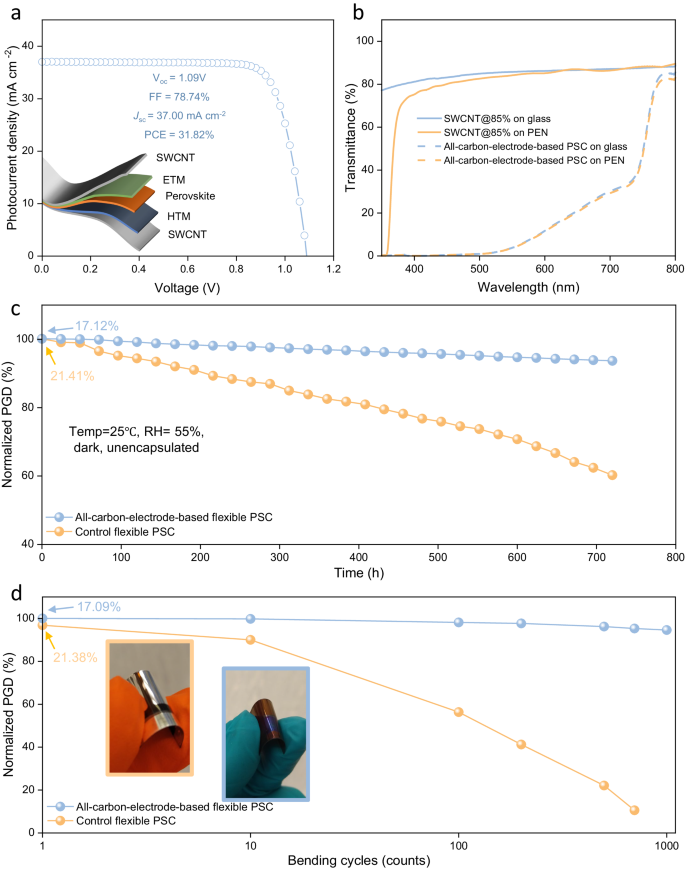
a J -V curves and corresponding PGD of a flexible double-sided SWCNT@85% device measured by double light source method. b Optical transmittances of SWCNT films and corresponding devices on glass and PEN, respectively. c Shelf storage (in dark) stabilities of all-carbon-electrode-based flexible PSCs and controls devices (both unencapsulated) at a temperature of 25 °C and a relative humidity of 55%. d Bending performances of flexible devices (bending radius of 4 mm, 1000 cycles) and the inset pictures show the graphs of a flexible control device (with orange border) and an all-carbon-electrode-based flexible device (with blue border).
Cost analysis
Material cost is a critical factor for commercialization. To accurately assess the economic feasibility of different devices, cost analysis should rely on realistic material price and quantity used in fabrication, with minimal assumptions to ensure the validity of small-scale estimates. Here we consider that all devices are interconnected in series to form a module, following a common practice in thin film production 67 . We also assume that electricity and water consumption are identical for all devices and do not affect the cost comparison. As shown in Table S7 and S8 , the material cost of an all-carbon-electrode-based bifacial PSC is about 70% lower than that of a monofacial device (whose electrodes are ITO and Ag). The cost advantage is further enhanced when accounting for equipment costs, as all-carbon-electrode-based devices eliminate the need for expensive radio frequency (RF) sputtering or thermal evaporation processes for ITO or metal electrodes. Therefore, our results indicate that all-carbon-electrode-based bifacial PSCs offer a promising route to achieve efficient, low-cost and long-term stable devices compared to monofacial devices that use ITO and Ag.
Power generation simulation
We performed a simulation of the power generation of all-carbon-based bifacial PSCs under various albedo conditions, based on the photovoltaic results obtained from the previous section. We employed the Norwegian Earth System Model as the simulation tool, which predicted the weather and daytime period in England for the next 26 years (from 2025 to 2050). More details of the simulation method are provided in the Methods section. We used the double-sided SWCNT@85% PSCs as an example (simulation data of monofacial Si solar cells, bifacial devices with SWCNT@95%, SWCNT@90% and SWCNT@75% are shown in Fig. S23a–h ). For the 1-year (2025) power generation, the power output could reach as high as ~35 kWh in the sunlight-rich month (Fig. 5a , grass, June). In contrast, the monofacial silicon cell could only generate ~28 kWh under similar conditions (Fig. S23a , grass, June). Moreover, for the winter month with a short daytime (e.g., January and December), the double-sided SWCNT@85% PSC could harvest albedo energy efficiently, producing ~13 kWh (Fig. 5a , grass, January) while ~11 kWh for silicon counterparts (Fig. S23a , grass, January). Regarding the long-term power generation (from 2025 to 2050), double-sided SWCNT@85% PSCs are projected to generate ~300 kWh per year of electricity within these 26 years (Fig. 5b , grass), whereas the monofacial silicon cell could only deliver around 260 kWh per year (Fig. S23b ). These simulation results confirm the remarkable potential of bifacial PSCs with carbon materials, especially in terms of enhanced energy generation under various albedo conditions. This is particularly important in urban areas where the widespread use of glass increases the reflection and availability of incident sunlight.
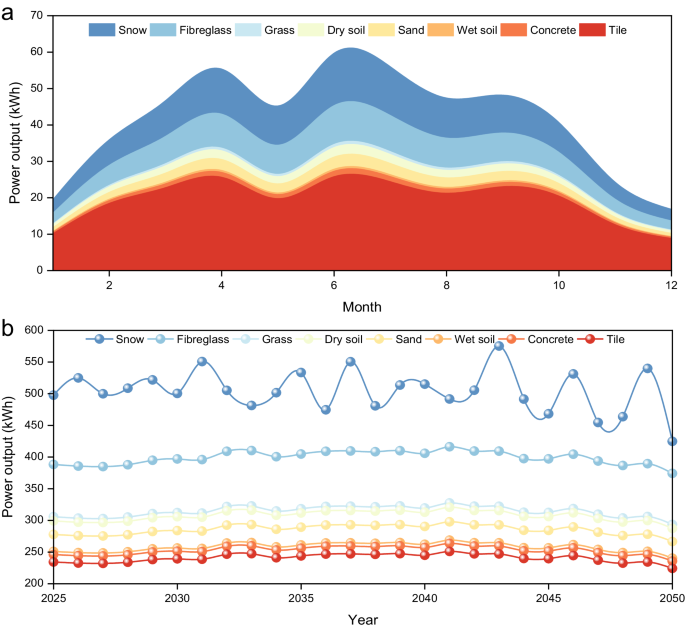
a The 1-year power generation and the ( b ) power output for 26 years (from 2025 to 2050) (assuming the device area is 1 m 2 ). (Source data are provided as a Source Data file).
ITO-patterned glass substrates (10 Ω sq −1 ) were purchased from Huananxiangcheng Ltd. (China) and ITO-patterned PEN flexible substrates (<15 Ω sq −1 ) were purchased from Peccell Inc (Japan). Nickel (II) nitrate hexahydrate (98%) was purchased from Alfa Aesar. Sodium hydroxide (99.9%) and pH paper stick indicator were purchased from Fisher Sci Ltd. Lead diiodide (PbI 2 , 99.99%) and lead dibromide (PbBr 2 , 99%) were purchased from Tokyo Chemical Industry Co., Ltd. (TCI, Japan). Formamidinium iodide (FAI), methylammonium iodide (MAI), Cesium iodide (CsI, 99.999%), copper (II) nitrate trihydrate (98%), nitric acid (HNO 3 , 70%), and choline chloride (≥99%) were purchased from Sigma-Aldrich. PC 61 BM (99.5%) and Bathocuproin (BCP, 98%) were purchased from Ossila. N,N-dimethylformamide (DMF, 99.8%), dimethyl sulfoxide (DMSO, 99.7%), chlorobenzene (CB, 99.8%) and Isopropanol (IPA, 99.5%) were purchased from Acros. SnO 2 (2.5 wt%) in butanol solution was purchased from Avantama. Filter papers were purchased from Whatman Inc. All chemicals and materials were purchased from commercial suppliers and used as received.
SWCNT film preparation
SWCNTs films were prepared according to a floating catalyst CVD process 38 , 68 . And the SWCNT films were formed on a membrane filter at room temperature. The thickness of the SWCNT films was controlled by adjusting the collection time. Glass substrates and PEN substrates were cleaned with deionized water, acetone, and isopropyl alcohol respectively for later use. Then the membrane filter with the SWCNT film deposited first tailored to a proper size with a scalpel and placed on a pre-cleaned substrate. Then a drop of alcohol was dropped on the transferred SWCNT film to ensure good contact between the substrate and the SWCNT film. After several seconds the membrane filter was removed by using a tweezer. Finally, a glass/SWCNT or PEN/SWCNT substrate was obtained to be used to deposit PSCs. For HNO 3 doping, the glass/SWCNT or PEN/SWCNT substrate was transferred to a petri dish, and one drop of HNO 3 was dropped on top of the substrate, followed by drying under 60 °C for 45 min. Then these substrates were washed with diluted water and alcohol for later use.
Calculation of the cost of SWCNT films
The raw materials and the energy used during the production (here is FCCVD) are taken into account. As calculated, the total cost of 1 gram SWCNTs is estimated at ~$110, The weight of a single SWCNT film (~85% optical transmittance) used in this work is ~460 μg. Therefore, the cost of each film is ~$0.0506. And the area of one single SWCNT film is 21.23 cm 2 (equal to 0.002123 m 2 ). Thus, the cost of SWCNT is ~$24 m −2 . While comparing with ITO-coated glass substrates, the cost of glass substrates needed to be added. The final cost of glass/SWCNT is estimated at ~$40 m −2 .
Copper-doped nickel oxide thin film preparation
0.25 mol nickel (II) nitrate hexahydrate and copper (II) nitrate trihydrate were dissolved in 50 ml distilled water with continuous stirring, copper (II) nitrate trihydrate was added to the nickel (II) nitrate hexahydrate solution at a molar ratio of 5%. After the solution became dark green clear, the pH value was adjusted to 10 by adding 10 M sodium hydroxide solution, the pH value was measured by pH indicator. The solution was kept stirring for another 15 min after pH reached 10. Then the solution was filtered by a filter paper to collect the dark green precipitation. The collected precipitation was heated at 80 °C for 1 h after washing with distilled water three times. To obtain copper-doped nickel oxide nanoparticles (Cu:NiO x NPs), the heated precipitation was transferred to a furnace to calcinate at 275 °C for 2 h to obtain black powders. Finally, the black powder was dispersed in deionized water to form 2 wt% Cu:NiO x NPs solution.
Perovskite solar cell fabrication
ITO-patterned glass substrates (10 Ω sq −1 , Huananxiangcheng Ltd.) and ITO-patterned PEN flexible substrates (<15 Ω sq −1 , Peccell) were cleaned with deionized water, acetone, and isopropyl alcohol respectively. Then ITO-patterned glass substrates were treated with an oxygen plasma process (Emitech K1050X, 230 V, 100 W) for 5 min before fabrication. The rest fabrication processes of ITO-based and SWCNT-based perovskite solar cells were the same. Cu:NiO x NPs solution was spin-coated on ITO-based and SWCNT-based substrates at 2000 rpm for 20 s, followed by a post-heating process at 120 °C for 10 min. Then, these Cu:NiO x -coated substrates were moved to a UV-ozone cleaning device to receive 5 min of UV-Ozone treatment. Then the KI layer was prepared on top of the Cu:NiOx via spin-coating, the spin-coating condition of the KI layer is 2000 rpm, 30 s with a solution concentration of 2 mg/ml (in water), and heated at 100 °C for 10 min. Here, the composition of the perovskite layer is Cs 0.05 FA 0.80 MA 0.15 Pb(I x Br 1-x ) 3 , the perovskite precursor solution was prepared by dissolving 470.23 mg PbI 2 , 66.06 mg PbBr 2 , 15.59 mg CsI, 166.64 mg formamidinium iodide, and 19.15 mg methylammonium bromide in a 1 ml solution of 4:1 V/V DMF/DMSO. Following this, the solution was stirred overnight at room temperature. Then the perovskite layer was formed by spin-coating according to a two-step protocol, 1000 rpm for 10 s and 4000 rpm for 35 s, 80 µl CB was dropped 5 s before the end of the second step. Then the film was heated at 100 °C for 60 min on a hotplate. A passivation layer, choline chloride was then fabricated on top of the perovskite layer at 4000 rpm, 30 s with a solution concentration of 1 mg/mL (in IPA), and heated at 100 °C for 30 min. The SnO 2 layer was prepared with the SnO 2 butanol solution, which was diluted with 1-butanol until the concentration reached 1.25 wt%. Subsequently, SnO 2 thin film was spin-coated on top of the perovskite with the diluted solution at 6000 rpm (2000 rpm/s) for 30 s and heated at 100 °C for 40 min. PCBM was employed as the electron transport material, PC 61 BM (20 mg/ml in CB) was spin-coated at 2000 rpm for 20 s, and dried at 100 °C for 5 min. As for the back SWCNT electrode, the transfer process is the same as the front SWCNT transfer process. For control cells, BCP solution (0.5 mg/mL in IPA) was spin-coated on top of PC 61 BM. Finally, a 100 nm thick Ag electrode was deposited in a thermal evaporator (>3 × 10 −6 Torr, Moorefield thermal evaporator) to complete the fabrication process.
Materials and device characterization (SWCNT films and PSCs)
The optical transmittance of SWCNT film was measured by a UV–Vis–NIR spectrophotometer (AGILENT CARY 5000). Raman spectra excited by 633 nm laser was obtained using a Jobin-Yvon Labram HR800 instrument. The sheet resistance of the SWCNT film was determined by Four Probes Tech (4-probe Tech.). The morphology of the SWCNT film was characterized by SEM (Nova Nano SEM 430) and TEM (JEM-2010HR and Tecnai G2 F20, operated at 200 kV). XRD patterns were performed using 45 kV, 40 mA Cu Kλ ( λ = 0.154187 nm) radiation by PANalytical X’Pert Pro, equipped with an X-ray mirror (parallel beam) and proportional Xe detector (GM-tube). The work function of SWCNT films was determined via Esclab-250 instrument. Photoluminescence data were carried out by Agilent Cary Eclipse Fluorescence Spectrophotometer. AFM images were obtained via AIST-NT SmartSPM 1000 in a tapping mode. The TRPL measurements were measured using a confocal microscope setup (PicoQuant, MicroTime 200). The sample was excited by a 510-nm pulsed diode (PDL 828, PicoQuant, pulse width ~100 ps) with an air objective. The signals were focused onto a Hybrid PMT detector connected to a Picoquant acquisition card for time-correlated single-photon counting (time resolution of 200 ps). The J -V characteristics and MPP tracking were performed outside the glove box at the lab condition by using a Keysight B2901A source meter under simulated one-sun AM 1.5 G illumination (100 m −1 W −1 cm −2 ) with a AAA steady solar simulator (Enlitech, SS-F5-3A). Before J -V measurements, the simulator was cautiously calibrated by using a standard monocrystalline silicon reference solar cell (Fraunhofer ISE CalLab (ISE001/013-2018)) with a KG-5 filter. The sweeping conditions are reverse scan (1.20 V to −0.02 V, scan rate 40 mV s −1 , and no delay time), forward scan (-0.02 V to 1.20 V, scan rate 40 mV s −1 ), with no delay time), All devices were measured both in the reverse scan (1.20 V to −0.20 V, step 0.02 V, delay time 100 ms) and forward scan (−0.20 to 1.20 V, step 0.02 V, delay time 100 ms) without any pre-light soaking and pre-bias process. To ensure accuracy, a mask with an aperture area of 0.09 cm 2 was employed during the measuring process 69 , 70 . The data were collected by the IV testing system with software (IVS-KA5000). The stabilized power output was measured at the maximum power output bias voltage. EQE was measured in air on a commercial system (Bentham PV300). And the stability test was conducted without encapsulation. The stability test was performed at 25 °C, and the RH was ~55%. The repeated bending cycle tests are performed by a custom-made stretching machine with an adjustable bending radius.
Models and simulations
The simulation is carried out by PVLib, which is an open-source solar generation simulation software based on Python 71 . The weather forecast data we use for this simulation, such as solar irradiance, temperature and near-surface wind speed, are generated by the Norwegian Earth System Model with lower atmosphere–land resolution under Shared Socioeconomic Pathways 1–2.6 72 . The geographic location of this simulation is set on the west coast of the UK (53.86 N 3.07 W). We assume the devices have an effective area of 1m 2 , and they are fixed to the angle with maximum annual generation facing towards the south.
The Norwegian Earth System Model generates four weather forecast data (Surface Downwelling Shortwave Radiation, Surface Diffuse Downwelling Shortwave Radiation, Near-Surface Wind Speed, and Near-Surface Air Temperature) with a monthly time scale. The forecast data can be converted into ideal hourly data for 1 day of that month by referring to historical hourly data. This hourly data is then fed into the PVlib simulation model to simulate the generation of that day. The effective irradiance of solar cells consists of three irradiances, beam irradiance, ground-reflected irradiance and sky-diffuse irradiance. The albedo is defined as ground surface reflectivity, and it directly determines the ground-reflected irradiance. With different albedo, the PGD of the bifacial perovskite cells varies as well as effective irradiance changes. The generation of the cell is simulated by the effective irradiance it receives. Since the devices are in the lab stage, the losses caused by the package are neglected and the temperature coefficient for all perovskite solar cells is assumed to be −0.1%/°C.
Reporting summary
Further information on research design is available in the Nature Portfolio Reporting Summary linked to this article.
Data availability
The main data supporting the findings of this study are available within the published article and its Supplementary Information and source data files. Additional data are available from the corresponding author on request. Source data are provided with this paper.
Mandys, F., Chitnis, M. & Silva, S. R. P. Levelized cost estimates of solar photovoltaic electricity in the United Kingdom until 2035. Patterns 4 , 100735 (2023).
Article PubMed PubMed Central Google Scholar
IEA-PVPS, snapshot of global photovoltaic markets. Accessed 21 February 2024. https://iea-pvps.org/wp-content/uploads/2022/04/IEA_PVPS_Snapshot_2022-vF.pdf
Song, Z., Li, C., Chen, L. & Yan, Y. Perovskite solar cells go bifacial—mutual benefits for efficiency and durability. Adv. Mater. 34 , 2106805 (2022).
Article CAS Google Scholar
Accessed 21 February 2024. https://www.gov.uk/government/news/energy-bills-support-extended-for-an-extra-three-months
Sun, X., Khan, M. R., Deline, C. & Alam, M. A. Optimization and performance of bifacial solar modules: a global perspective. Appl. Energy 212 , 1601–1610 (2018).
Article ADS Google Scholar
Perovskites take steps to industrialization. Nat. Energy 5 , 1–1 (2020). https://doi.org/10.1038/s41560-020-0552-6
Kopecek, R. & Libal, J. Bifacial photovoltaics 2021: status, opportunities and challenges. Energies 14 , 2076 (2021).
Article Google Scholar
Accessed 21 February 2024. https://www.nrel.gov/docs/fy20osti/70463.pdf
Hezel, R. Novel applications of bifacial solar cells. Prog. Photovoltaics: Res. Appl. 11 , 549–556 (2003).
Araki, I., Tatsunokuchi, M., Nakahara, H. & Tomita, T. Bifacial PV system in Aichi Airport-site demonstrative research plant for new energy power generation. Sol. Energy Mater. Sol. Cells 93 , 911–916 (2009).
Liang, T. S. et al. A review of crystalline silicon bifacial photovoltaic performance characterisation and simulation. Energy Environ. Sci. 12 , 116–148 (2019).
Guerrero-Lemus, R., Vega, R., Kim, T., Kimm, A. & Shephard, L. E. Bifacial solar photovoltaics—A technology review. Renew. Sustain. Energy Rev. 60 , 1533–1549 (2016).
Taguchi, M. et al. 24.7% record efficiency HIT solar cell on thin silicon wafer. IEEE J. Photovolt. 4 , 96–99 (2014).
Subedi, K. K. et al. Nanocomposite (CuS)x(ZnS)1-x thin film back contact for CdTe solar cells: toward a bifacial device. Sol. Energy Mater. Sol. Cells 186 , 227–235 (2018).
Wang, H. et al. Bifacial, color-tunable semitransparent perovskite solar cells for building-integrated photovoltaics. ACS Appl. Mater. Interfaces 12 , 484–493 (2020).
Article CAS PubMed Google Scholar
NREL solar cell efficiency chart. Accessed 21 February 2024. https://www.nrel.gov/pv/assets/pdfs/best-research-cell-efficiencies.pdf
Bailie, C. D. et al. Semi-transparent perovskite solar cells for tandems with silicon and CIGS. Energy Environ. Sci. 8 , 956–963 (2015).
Yanagida, M., Shirai, Y., Khadka, D. B. & Miyano, K. Photoinduced ion-redistribution in CH3NH3PbI3 perovskite solar cells. Phys. Chem. Chem. Phys. 22 , 25118–25125 (2020).
Jiang, Q. et al. Highly efficient bifacial single-junction perovskite solar cells. Joule https://doi.org/10.1016/j.joule.2023.06.001 (2023).
Gu, H. et al. Design optimization of bifacial perovskite minimodules for improved efficiency and stability. Nat. Energy https://doi.org/10.1038/s41560-023-01254-3 (2023).
Hou, F. et al. Monolithic perovskite/silicon-heterojunction tandem solar cells with open-circuit voltage of over 1.8 V. ACS Appl. Energy Mater. 2 , 243–249 (2019).
Zheng, J. et al. Large area efficient interface layer free monolithic perovskite/homo-junction-silicon tandem solar cell with over 20% efficiency. Energy Environ. Sci. 11 , 2432–2443 (2018).
Bush, K. A. et al. Thermal and environmental stability of semi-transparent perovskite solar cells for tandems enabled by a solution-processed nanoparticle buffer layer and sputtered ITO electrode. Adv. Mater. 28 , 3937–3943 (2016).
Jaysankar, M. et al. Four-terminal perovskite/silicon multijunction solar modules. Adv. Energy Mater. 7 , 1602807 (2017).
Chen, D. et al. Efficient Ni/Au mesh transparent electrodes for ITO-free planar perovskite solar cells. Nanomaterials 9 , 932 (2019).
Article CAS PubMed PubMed Central Google Scholar
Zhang, J. et al. High-performance ITO-free perovskite solar cells enabled by single-walled carbon nanotube films. Adv. Funct. Mater. 31 , 2104396 (2021).
Vaagensmith, B. et al. Environmentally friendly plasma-treated PEDOT:PSS as electrodes for ITO-free perovskite solar cells. ACS Appl. Mater. Interfaces 9 , 35861–35870 (2017).
Chen, H. et al. Enhanced silver nanowire composite window electrode protected by large size graphene oxide sheets for perovskite solar cells. Nanomaterials 9 , 193 (2019).
Kim, H.-S., Kang, J.-H., Hwang, J.-Y. & Shin, U. S. Wearable CNTs-based humidity sensors with high sensitivity and flexibility for real-time multiple respiratory monitoring. Nano Converg. 9 , 35 (2022).
Kim, Y. A. et al. Thermal stability and structural changes of double-walled carbon nanotubes by heat treatment. Chem. Phys. Lett. 398 , 87–92 (2004).
Article ADS CAS Google Scholar
Zhang, C. et al. CNT-based bifacial perovskite solar cells toward highly efficient 4-terminal tandem photovoltaics. Energy Environ. Sci. 15 , 1536–1544 (2022).
Dong, Z. et al. Carbon nanotubes in perovskite-based optoelectronic devices. Matter 5 , 448–481 (2022).
Hu, X.-G., Lin, Z., Ding, L. & Chang, J. Recent advances of carbon nanotubes in perovskite solar cells. 3 , 639–670 https://doi.org/10.1002/sus2.158 (2023).
Zhang, C. et al. Efficient stable graphene-based perovskite solar cells with high flexibility in device assembling via modular architecture design. Energy Environ. Sci. 12 , 3585–3594 (2019).
Jeon, I. et al. High-performance solution-processed double-walled carbon nanotube transparent electrode for perovskite solar cells. Adv. Energy Mater. 9 , 1901204 (2019).
Chen, H. et al. Solvent engineering boosts the efficiency of paintable carbon-based perovskite solar cells to beyond 14%. Adv. Energy Mater. 6 , 1502087 (2016).
De Bastiani, M. et al. Bifacial perovskite/silicon tandem solar cells. Joule 6 , 1431–1445 (2022).
Hu, X.-G. et al. Small-bundle single-wall carbon nanotubes for high-efficiency silicon heterojunction solar cells. Nano Energy 50 , 521–527 (2018).
Zhao, Y.-M. et al. A high-performance photodetector based on small-bundled single-wall carbon nanotube film/silicon heterojunctions. J. Mater. Chem. A 10 , 16986–16994 (2022).
Morales-Masis, M., De Wolf, S., Woods-Robinson, R., Ager, J. W. & Ballif, C. Transparent electrodes for efficient optoelectronics. 3 , 1600529 https://doi.org/10.1002/aelm.201600529 (2017).
Kunaraj, A., Chelvanathan, P., Bakar, A. A. & Yahya, I. Single-Walled Carbon Nanotube (SWCNT) thin films via automatic spray coating and nitric acid vapor treatment. J. Eng. Res. https://doi.org/10.1016/j.jer.2023.07.002 (2023).
Bulmer, J. S., Gspann, T. S., Barnard, J. S. & Elliott, J. A. Chirality-independent characteristic crystal length in carbon nanotube textiles measured by Raman spectroscopy. Carbon 115 , 672–680 (2017).
Bulmer, J. S. et al. Extreme stretching of high G:D ratio carbon nanotube fibers using super-acid. Carbon 153 , 725–736 (2019).
Bati, A. S. R., Yu, L., Batmunkh, M. & Shapter, J. G. Recent advances in applications of sorted single-walled carbon nanotubes. 29 , 1902273 https://doi.org/10.1002/adfm.201902273 (2019).
Rong, X. et al. Impact of metal electrode work function of CH3NH3PbI3/p-Si planar heterojunction perovskite solar cells. Sol. Energy 158 , 424–431 (2017).
Park, Y., Choong, V., Gao, Y., Hsieh, B. R. & Tang, C. W. Work function of indium tin oxide transparent conductor measured by photoelectron spectroscopy. Appl. Phys. Lett. 68 , 2699–2701 (1996).
Sugiyama, K., Ishii, H., Ouchi, Y. & Seki, K. Dependence of indium–tin–oxide work function on surface cleaning method as studied by ultraviolet and x-ray photoemission spectroscopies. J. Appl. Phys. 87 , 295–298 (2000).
Zhang, B.-W. et al. Spiro-OMeTAD versus PTAA for single-walled carbon nanotubes electrode in perovskite solar cells. Carbon 205 , 321–327 (2023).
Zhang, J. et al. Fast and balanced charge transport enabled by solution-processed metal oxide layers for efficient and stable inverted perovskite solar cells. Energy Environ. Mater. e12595 https://doi.org/10.1002/eem2.12595 (2023).
Jeon, I. et al. Perovskite solar cells using carbon nanotubes both as cathode and as anode. J. Phys. Chem. C. 121 , 25743–25749 (2017).
Jiang, S. et al. Ultrahigh-performance transparent conductive films of carbon-welded isolated single-wall carbon nanotubes. 4 , eaap9264 https://doi.org/10.1126/sciadv.aap9264 (2018).
Bissett, M. A., Konabe, S., Okada, S., Tsuji, M. & Ago, H. Enhanced chemical reactivity of graphene induced by mechanical strain. ACS Nano 7 , 10335–10343 (2013).
Koehler, F. M. et al. Permanent pattern-resolved adjustment of the surface potential of graphene-like carbon through chemical functionalization. Angew. Chem. Int. Ed. 48 , 224–227 (2009).
Ramuz, M. P. et al. Evaluation of solution-processable carbon-based electrodes for all-carbon solar cells. ACS Nano 6 , 10384–10395 (2012).
Tung, V. C. et al. Towards solution processed all-carbon solar cells: a perspective. Energy Environ. Sci. 5 , 7810–7818 (2012).
Bati, A. S. R. et al. Electrically sorted single-walled carbon nanotubes-based electron transporting layers for perovskite solar cells. iScience 14 , 100–112 (2019).
Article ADS CAS PubMed PubMed Central Google Scholar
Liu, B. et al. A flexible NO2 gas sensor based on polypyrrole/nitrogen-doped multiwall carbon nanotube operating at room temperature. Sens. Actuators B: Chem. 295 , 86–92 (2019).
Delacou, C. et al. Investigation of charge interaction between fullerene derivatives and single-walled carbon nanotubes. InfoMat 1 , 559–570 (2019).
Yao, K. et al. A copper-doped nickel oxide bilayer for enhancing efficiency and stability of hysteresis-free inverted mesoporous perovskite solar cells. Nano Energy 40 , 155–162 (2017).
Yamada, Y., Nakamura, T., Endo, M., Wakamiya, A. & Kanemitsu, Y. Photocarrier recombination dynamics in perovskite CH3NH3PbI3 for solar cell applications. J. Am. Chem. Soc. 136 , 11610–11613 (2014).
Krogmeier, B., Staub, F., Grabowski, D., Rau, U. & Kirchartz, T. Quantitative analysis of the transient photoluminescence of CH3NH3PbI3/PC61BM heterojunctions by numerical simulations. Sustain. Energy Fuels 2 , 1027–1034 (2018).
Stolterfoht, M. et al. Visualization and suppression of interfacial recombination for high-efficiency large-area pin perovskite solar cells. Nat. Energy 3 , 847–854 (2018).
Lamers, M. W. P. E. et al. Temperature effects of bifacial modules: hotter or cooler? Sol. Energy Mater. Sol. Cells 185 , 192–197 (2018).
Gao, D. et al. Highly efficient flexible perovskite solar cells through pentylammonium acetate modification with certified efficiency of 23.35%. Adv. Mater. 35 , 2206387 (2023).
Jeong, G. et al. Highly efficient self-encapsulated flexible semitransparent perovskite solar cells via bifacial cation exchange. ACS Appl. Mater. Interfaces 14 , 33297–33305 (2022).
Barrier Films and Thin Film Encapsulation for Flexible and/or Organic Electronics 2019–2029. Accessed 21 February 2024. https://www.idtechex.com/en/research-report/barrier-films-and-thin-film-encapsulation-for-flexible-and-or-organic-electronics-2019-2029/653
Barr, M. C. et al. Direct monolithic integration of organic photovoltaic circuits on unmodified paper. Adv. Mater. 23 , 3500–3505 (2011).
Hu, X.-G. et al. High-efficiency and stable silicon heterojunction solar cells with lightly fluorinated single-wall carbon nanotube films. Nano Energy 69 , 104442 (2020).
Li, B. et al. Reduced bilateral recombination by functional molecular interface engineering for efficient inverted perovskite solar cells. Nano Energy 78 , 105249 (2020).
Yang, X. et al. Buried interfaces in halide perovskite photovoltaics. Adv. Mater. 33 , 2006435 (2021).
Mikofski, M. A., Holmgren, W. F. & Hansen, C. W. pvlib python: a python package for modeling solar energy systems. J. Open Source Softw. 3 , 884 (2018).
Seland, Ø. et al. Overview of the Norwegian Earth System Model (NorESM2) and key climate response of CMIP6 DECK, historical, and scenario simulations. Geosci. Model Dev. 13 , 6165–6200 (2020).
Download references
Acknowledgements
J.Z., W.Z. and S.R.P.S thanks the EPSRC standard research (EP/V027131/1), Newton Advanced Fellowship (192097) and Equal Opportunities Foundation Hong Kong for financial support for financial support. X.G.H. thanks the National Natural Science Foundation of China (62304163) and Qinchuangyuan Cited High-level Innovation and Entrepreneurship Talent Projects (QCYRCXM−2022-364). HM.C. acknowledges support by the National Natural Science Foundation of China (No. 52188101), K.J. and S.D.S. acknowledge funding from the Royal Society and Tata Group (UF150033) and support from the European Research Council (European Union’s Horizon 2020, HYPERION 756962 and PEROVSCI 957513).
Author information
These authors contributed equally: Jing Zhang, Xian-Gang Hu.
Authors and Affiliations
Advanced Technology Institute (ATI), University of Surrey, Guildford, Surrey, GU2 7XH, UK
Jing Zhang, Dongtao Liu, Bowei Li, Hui-Ming Cheng, S. Ravi P. Silva & Wei Zhang
Shenyang National Laboratory for Materials Science, Institute of Metal Research, Chinese Academy of Sciences, Shenyang, 110016, PR China
Xian-Gang Hu, Peng-Xiang Hou, Chang Liu & Hui-Ming Cheng
Advanced Interdisciplinary Research Center for Flexible Electronics, Academy of Advanced Interdisciplinary Research, Xidian University, Xi’an, 710071, PR China
Xian-Gang Hu
Cavendish Laboratory, University of Cambridge, 19 J J Thomson Avenue, Cambridge, CB3 0HE, UK
Kangyu Ji & Samuel D. Stranks
Centre for Environment and Sustainability, Thomas Telford (AA) building, University of Surrey, Guildford, Surrey, GU2 7XH, UK
Songru Zhao & Lirong Liu
Department of Chemical Engineering & Biotechnology, University of Cambridge, Philippa Fawcett Drive, Cambridge, CB3 0AS, UK
Samuel D. Stranks
Faculty of Materials Science and Energy Engineering, Shenzhen University of Advanced Technology, 291 Louming Road, Shenzhen, 518107, PR China
Hui-Ming Cheng
Shenzhen Key Lab of Energy Materials for Carbon Neutrality, Shenzhen Institute of Advanced Technology, Chinese Academy of Sciences, 1068 Xueyuan Road, Shenzhen, 518055, PR China
State Centre for International Cooperation on Designer Low-carbon & Environmental Materials (CDLCEM), School of Materials Science and Engineering, Zhengzhou University, Zhengzhou, 450001, PR China
S. Ravi P. Silva & Wei Zhang
You can also search for this author in PubMed Google Scholar
Contributions
These authors contributed equally: J.Z., XG.H. XG.H. synthesized and collected SWCNT films, and transferred SWNCT films to substrates with the supervision of PX.H., C.L. and HM.C. J.Z. fabricated perovskite solar cells. B.L. and D.L. performed J-V curve, EQE, and MPPT characterizations. K.J. and S.D.S carried out the PL, TRPL, and charge lifetime mapping measurement. S.Z. and L.L. did the power output simulation. J.Z. drafted the paper. PX.H., HM.C., S.R.P.S, and W.Z. supervised the research and contributed to the analysis and writing of the paper. All authors helped fine-tune the paper.
Corresponding authors
Correspondence to Peng-Xiang Hou , Hui-Ming Cheng , S. Ravi P. Silva or Wei Zhang .
Ethics declarations
Competing interests.
The authors declare no competing interests.
Peer review
Peer review information.
Nature Communications thanks Hao-Sheng Lin and the other, anonymous, reviewer(s) for their contribution to the peer review of this work. A peer review file is available.
Additional information
Publisher’s note Springer Nature remains neutral with regard to jurisdictional claims in published maps and institutional affiliations.
Supplementary information
Supplementary information, peer review file, reporting summary, source data, source data, rights and permissions.
Open Access This article is licensed under a Creative Commons Attribution 4.0 International License, which permits use, sharing, adaptation, distribution and reproduction in any medium or format, as long as you give appropriate credit to the original author(s) and the source, provide a link to the Creative Commons licence, and indicate if changes were made. The images or other third party material in this article are included in the article’s Creative Commons licence, unless indicated otherwise in a credit line to the material. If material is not included in the article’s Creative Commons licence and your intended use is not permitted by statutory regulation or exceeds the permitted use, you will need to obtain permission directly from the copyright holder. To view a copy of this licence, visit http://creativecommons.org/licenses/by/4.0/ .
Reprints and permissions
About this article
Cite this article.
Zhang, J., Hu, XG., Ji, K. et al. High-performance bifacial perovskite solar cells enabled by single-walled carbon nanotubes. Nat Commun 15 , 2245 (2024). https://doi.org/10.1038/s41467-024-46620-1
Download citation
Received : 14 July 2023
Accepted : 01 March 2024
Published : 12 March 2024
DOI : https://doi.org/10.1038/s41467-024-46620-1
Share this article
Anyone you share the following link with will be able to read this content:
Sorry, a shareable link is not currently available for this article.
Provided by the Springer Nature SharedIt content-sharing initiative
By submitting a comment you agree to abide by our Terms and Community Guidelines . If you find something abusive or that does not comply with our terms or guidelines please flag it as inappropriate.
Quick links
- Explore articles by subject
- Guide to authors
- Editorial policies
Sign up for the Nature Briefing newsletter — what matters in science, free to your inbox daily.

IMAGES
VIDEO
COMMENTS
SunPower's Flexible Solar Panels are made with high-quality materials ensuring durability. They are especially ideal for sailboats as their warranty also covers saltwater damage. Pros Here are the standout features of the SunPower 110W Flexible Solar Panel: Flexibility. This solar panel can be bent up to 30 degrees, making it easy to install ...
He's been living aboard and renovating the boat for the past 3.5 years We're excited to show you the transformation as well as how he plans to propel the boat without the use of diesel or fossil fuels! 5280w Solar System for Electric Powered Catamaran. 16 Rigid solar panels (330w each) 20kwh of Lithium Batteries.
To install, open the flaps, place the panel on the bimini, then fold over the top flaps so they stick to the top velcro. very secure, but easy to remove the panel for storage or service. I am planning to install two Renogy 175 watt flexible solar panels on my bimini this summer. After numerous detailed conversations with several local...
Giosolar 1,000W flexible solar panel. Delivering a mighty kilowatt of power, (not far off the amount used by a one bedroom house), this Giostar package comprises ten separate 100W panels, each of which is 1,050 x 540 x 2.5mm in size. Capable of charging either 12 or 24V batteries, a kit of this magnitude is one for the most serious of solar ...
THE AVAILABLE SPACE. In practical terms, a modern 40ft monohull would have the space for around 1,200W of PV panels (cockpit arch, sprayhood top, deck), maybe 1,500W with the addition of a few portable panels for use at anchor. The 1,200W of fixed position solar array could produce around 360Ah on a sunny summer's day (zero shading) or more ...
Solar panel shading is a major issue on many boats. Shading can reduce a standard panel performance by over 60%. Custom Marine Products has developed a series of semi-flexible shade tolerant solar panels that have superior performance when partially shaded by boat equipment or nearby objects.
Rigid solar panels, typically monocrystalline or polycrystalline materials, are the most common type in various applications. While they are less flexible than other options, they remain a reliable and efficient choice for boats with ample deck or rooftop space. Rigid panels are durable, weather-resistant, and can deliver higher power outputs.
Mission Solar MSE345SX5T. MSE 345 is a simple solar panel for all kinds of applications, including boat installations. Mission Solar panels are manufactured in Texas. The module provides 345 Watts of power with 18.7% efficiency. It is certified for high snow (5400 Pa) and wind loads (4000 Pa).
The benefits of flexible solar panels on boats are manifold. They are lightweight, durable, and resistant to impacts, making them ideal for marine environments. Additionally, their flexibility allows them to fit on curved surfaces, maximizing the use of available space on boats. 2. Addressing Rust Concerns in Marine Solar Panels.
Sun Powered Yachts is an authorized dealer of SunPower flexible solar panels 50W, 110W & 170W. High efficiency, marine flexible solar panels for your boat or yacht. Best warranty, highest rated & most durable. Disconnect from the dock and start sailing with the sun.
Spending a lot of money on solar panels now might not feel ideal, but it is the most cost-effective decision. 1. Renogy Starter Kit. This starter kit is going to be perfect for installing on almost any sized boat. There are four solar panels, each can be fitted permanently to the boat.
WATTS/AMPS: 400W/22A. SIZE: 4 x 47.0" x 21.3" x 2.0". PROS: Includes x4 100W panels along with a charge controller and everything else needed to set up, ideal for sailors looking for a lot of power, easy mounting system, great price for a comprehensive kit. CONS: Rigid solar panels can only be on flat surfaces or mounted on rails ...
A solar-power installation on a sailboat is made up of two independent systems: one system to charge the batteries, and another system to provide 120-volt AC power for household appliances. In the charging system, the solar panels convert sunlight into electrical current and deliver it to the batteries via a solar charge controller.
Renogy Flexible Solar Panel 175 Watt 12 Volt. This Renogy solar panel is one of the best options for a sailboat. This product has an efficiency rate of 16-18% and will produce an average of 175 watts. The Renogy flexible solar panel is a durable and lightweight product that can easily mount on any surface.
Another factor you'll need to consider is the size of your boat battery bank. In general, a 100Ah deep cycle battery will need 180 watts of solar to fully charge, assuming you have at least four hours of sunlight a day. Thus, if you have a 200Ah battery bank, you'll need at least 360 watts of solar. In this case, two 200-watt panels would ...
Renogy 100W Flexible Marine Solar Panel: EcoWorthy 25W Solar Kit: NewPowa 30W Solar Kit: TopSolar Solar Kit: EcoWatch Opinion: Best Overall: Best Value: Easiest Installation: Great Budget Option: ... In our opinion, the best solar panels for boat use are the SunPower 170W solar panels. These are flexible panels that allow for easy and versatile ...
Solar panels will average efficiencies can be expected to produce 3 times the nominal power each day. A 100 watt panel will produce about 300 watts (25 ah) on average per day, less on cloudy days, a little more on bright sunny days. High efficiency panels (expensive) panels can get close to 4 times.
These solar panels have aluminum and tempered glass frames, ensuring a durable and weather-resistant use. Weighing 2.75 pounds and measuring 2.32 x 13.86 x 17.13 inches, they are compact and portable. Pros. Easy to store and carry. They come in a complete kit. Provide excellent weather resistance.
Flexible solar panels 12V and 100W options are good choices for bendable solar panels, and the ones by Topsolar are among the best out there, especially for marine settings. Not only are the solar cells highly efficient, but the design is durable too. 3. SunPower 110W Flexible Solar Panel. Specifications.
If you have limited space on your boat and don't want to build a structure to install a solar panel, flexible solar panels are a great solution. They can be...
Take your boat, RV, truck, or trailer off-the-grid with Dakota Lithium. This kit offers enough power to charge 200Ah of Dakota Lithium batteries. Designed for decades of rugged use in extreme conditions, this flexible, marine grade solar panel is waterproof, flexible for curved roofs and boat decks, and is backed up by a 25 year output warranty.
Shop SunPower highest efficiency, best rated, most durable, flexible solar panels. The E-Flex series includes 50Watt & 100Watt panels available for your boat. Shop today! ... The E-Flex series includes 50Watt & 100Watt panels available for your boat. Shop today!
Solar panels are pretty simple once they are in place. You just connect them to whatever they will be powering via MC4 cables. I have a few smaller solar panels with built-in USB ports that can ...
The downside to a flexible solar panel is that they have limited power compared to standard ones. This means flexible solar panels are not best suited to power a home, as the limited power and ...
Take your boat, RV, truck, or trailer off-the-grid with Dakota Lithium. This kit offers enough power to charge a single 100Ah battery. Designed for decades of rugged use in extreme conditions, this flexible, marine grade solar panel is waterproof, flexible for curved roofs and boat decks, and is backed up by a 25 year output warranty.
Our all-carbon-electrode-based flexible PSCs demonstrated significantly improved storage lifetime, as shown in Fig. 4c, and the PGD of flexible double-sided SWCNT@85% device reduced from 17.1% to ...